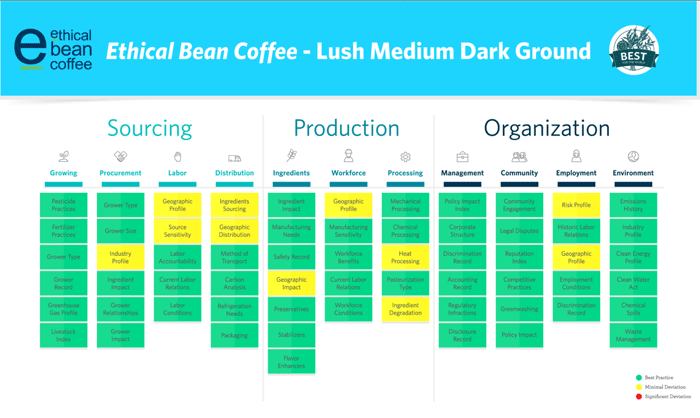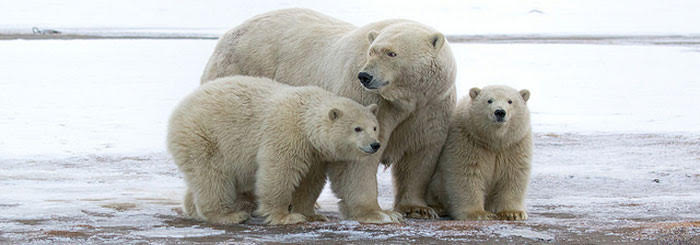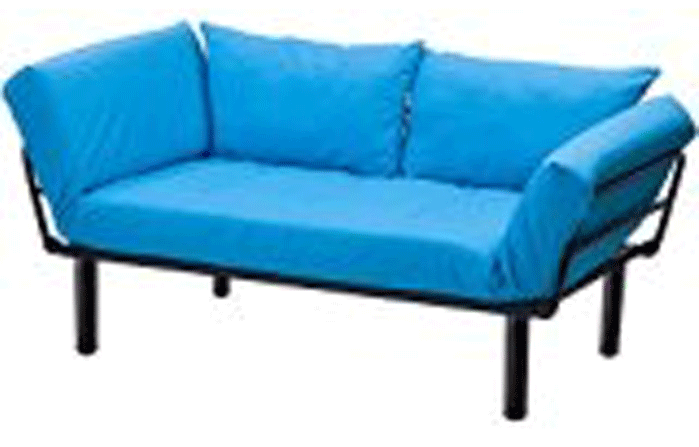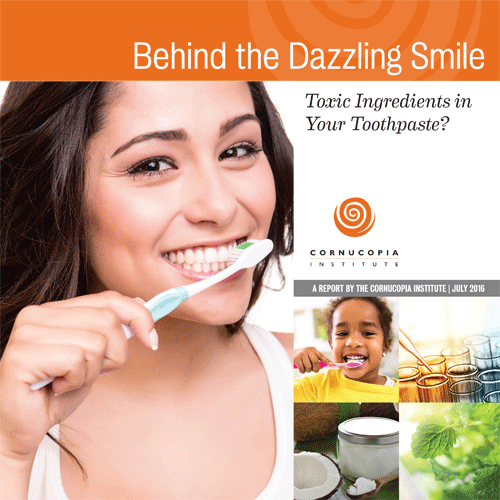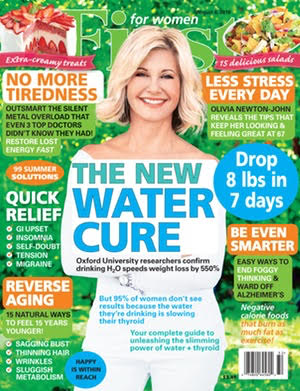
Travel
One Knot Knits
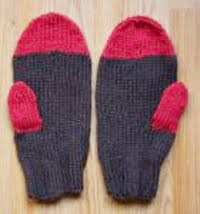 “Cozy knits made by hand with responsibly sourced fibers…I am very particular when choosing my fibers – they are as natural as possible. Some are organic, some are fair trade, and all are purchased from farms, small businesses, or fellow Etsy sellers. I focus on using yarns that are made in the United States or made using fair trade practices around the world. You will not find acrylic yarn or chemically treated yarn in this shop! I only knit with natural fibers, including sheep’s wool, alpaca, llama, silk, cotton, and bamboo.” Hats mittens, scrarves and other accessories for women and babies. image:{organic wool mittens
“Cozy knits made by hand with responsibly sourced fibers…I am very particular when choosing my fibers – they are as natural as possible. Some are organic, some are fair trade, and all are purchased from farms, small businesses, or fellow Etsy sellers. I focus on using yarns that are made in the United States or made using fair trade practices around the world. You will not find acrylic yarn or chemically treated yarn in this shop! I only knit with natural fibers, including sheep’s wool, alpaca, llama, silk, cotton, and bamboo.” Hats mittens, scrarves and other accessories for women and babies. image:{organic wool mittens
Pique Tea Crystals
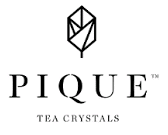 All the benefits and taste of loose leaf green and black teas in an instant. “Handcrafted from whole leaves using our proprietary slow-brew process, Pique delivers the exquisite flavor and natural antioxidants of loose leaf tea. We source the top 5% of tea leaves in the world Pique is made in collaboration with most experienced tea masters and tea farmers around the world. Using ingredients sourced direct from trusted farms in India, China and Sri Lanka at their peak freshness and antioxidant levels.”
All the benefits and taste of loose leaf green and black teas in an instant. “Handcrafted from whole leaves using our proprietary slow-brew process, Pique delivers the exquisite flavor and natural antioxidants of loose leaf tea. We source the top 5% of tea leaves in the world Pique is made in collaboration with most experienced tea masters and tea farmers around the world. Using ingredients sourced direct from trusted farms in India, China and Sri Lanka at their peak freshness and antioxidant levels.”
Meli Wraps
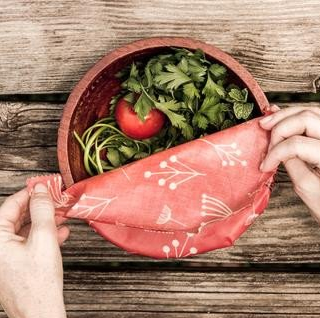 “Meli Wraps are made from organic cotton and a special beeswax blend to create a natural wrap that helps preserve your food. The wraps stick to themselves and can be washed and re-used for up to a year! Cover your bowls, plates or food themselves! Make snack packs, wraps sandwiches, over cover half avocados!” A useful and charming alternative to plastic wrap.
“Meli Wraps are made from organic cotton and a special beeswax blend to create a natural wrap that helps preserve your food. The wraps stick to themselves and can be washed and re-used for up to a year! Cover your bowls, plates or food themselves! Make snack packs, wraps sandwiches, over cover half avocados!” A useful and charming alternative to plastic wrap.
Easy Living Hats
 Beautiful colorful hats crocheted by a grandma from organic cotton yarn. “I have decided to focus on making hats that resembled traditional millinery but were made through a crochet method. When I researched millinery I found that not only was it extremely expensive to purchase all the equipment and supplies necessary, but it was toxic too. The term “mad hatter” came from the fact that all the sprays and stiffeners used to shape the hat were making the workers sick during production. I crocheted a sun hat and fitted a wire in the edge of the brim to look like a straw hat. What I found was how much more practical it was. Not only was it light weight, but it stretched to fit.”
Beautiful colorful hats crocheted by a grandma from organic cotton yarn. “I have decided to focus on making hats that resembled traditional millinery but were made through a crochet method. When I researched millinery I found that not only was it extremely expensive to purchase all the equipment and supplies necessary, but it was toxic too. The term “mad hatter” came from the fact that all the sprays and stiffeners used to shape the hat were making the workers sick during production. I crocheted a sun hat and fitted a wire in the edge of the brim to look like a straw hat. What I found was how much more practical it was. Not only was it light weight, but it stretched to fit.”
Vejibag
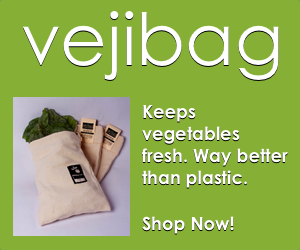 Specially designed bags for storing vegetables made from 100% U.S. grown and milled Organic cotton fabric and thread. ” It keeps all kinds of humidity-loving perishables fresh, crisp, and tasty for a week or more. Damp cloth bags keep moisture-loving vegetables moist and crisp in a high humidity environment. Moisture slowly evaporates from the surface of the bag to keep both the bag and the vegetables “breathing.” A slightly moist bag keeps vegetables crisp, often several days beyond storage in either a crisper drawer or plastic bag.”
Specially designed bags for storing vegetables made from 100% U.S. grown and milled Organic cotton fabric and thread. ” It keeps all kinds of humidity-loving perishables fresh, crisp, and tasty for a week or more. Damp cloth bags keep moisture-loving vegetables moist and crisp in a high humidity environment. Moisture slowly evaporates from the surface of the bag to keep both the bag and the vegetables “breathing.” A slightly moist bag keeps vegetables crisp, often several days beyond storage in either a crisper drawer or plastic bag.”
The Organique Co.
 High-quality organic superfoods in powdered form. “We source only the highest quality superfoods directly from farmers and cultivators around the world that we’ve met personally. Doing this, we can guarantee the highest quality products while ensuring sustainable and eco-friendly methods being used at the same time. In many cases, the cultivation of the ingredients we use even provides an important alternative to destructive farming and deforestation. By minimally processing our superfoods with methods such as freeze-drying and low-temperature milling, we do our best to seal in maximum flavor and nutritional value without the fillers and additives. Our ingredients are always whole, most raw, and all 100% organic and GMO-free.”
High-quality organic superfoods in powdered form. “We source only the highest quality superfoods directly from farmers and cultivators around the world that we’ve met personally. Doing this, we can guarantee the highest quality products while ensuring sustainable and eco-friendly methods being used at the same time. In many cases, the cultivation of the ingredients we use even provides an important alternative to destructive farming and deforestation. By minimally processing our superfoods with methods such as freeze-drying and low-temperature milling, we do our best to seal in maximum flavor and nutritional value without the fillers and additives. Our ingredients are always whole, most raw, and all 100% organic and GMO-free.”
Ambatalia
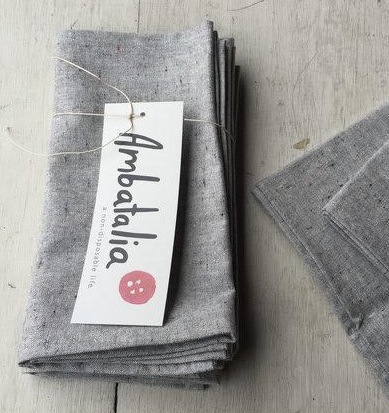 A unique collection of cotton and linen kitchen linens inspired by the deep-rooted tradition of Japan to create beauty in the everyday rituals of life. Cloth napkins and kitchen towels have a myriad of uses, aprons are designed for function as well as protection. Cloth lids to cover dishes and utensil rolls to carry your own are among the other lovely reusable and renewable items to help you live a plastic-free life.
A unique collection of cotton and linen kitchen linens inspired by the deep-rooted tradition of Japan to create beauty in the everyday rituals of life. Cloth napkins and kitchen towels have a myriad of uses, aprons are designed for function as well as protection. Cloth lids to cover dishes and utensil rolls to carry your own are among the other lovely reusable and renewable items to help you live a plastic-free life.
Five Mountains Heirloom Organic Tea
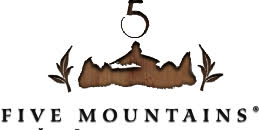 This is tea as Nature intended. “These traditional tea cultivars are renowned for their quality, flavor profiles and health attributes. Each tea is harvested from gardens of their native origin to fully express their variety and terroir…Five Mountains uses international organic certifications, biodiverse and sustainable growing methods, and fully compostable packaging.”
This is tea as Nature intended. “These traditional tea cultivars are renowned for their quality, flavor profiles and health attributes. Each tea is harvested from gardens of their native origin to fully express their variety and terroir…Five Mountains uses international organic certifications, biodiverse and sustainable growing methods, and fully compostable packaging.”
Cat Spot Litter
 Super lightweight cat litter made from 100% organic coconut, delivered automatically to your door every month (or try a single bag).
Super lightweight cat litter made from 100% organic coconut, delivered automatically to your door every month (or try a single bag).
The Philospher’s Stoneground Sprouted Nut Butters
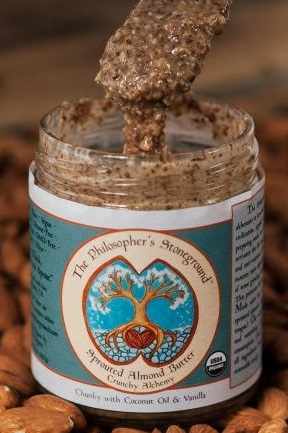 About a year and a half after originally posting this I happened to encounter the creator of this business at the Heirloom Food Exhibition and tasted this almond butter. It is AMAZING. The flavor of almonds is much stronger than usual almond butter and it feels more alive. Way beyond ordinary food,……Spouted almond butters made from organic unpasteurized Spanish almonds sprouted in spring water and sea salt. Finished butter contains only residual salt from the sprouting process. “Sprouting makes almonds sweeter, more digestible, and more nutritious…Our sprouted almond butters feature unpasteurized, truly raw almonds from Spain, which have been grown using dry-farming methodology, a traditional water-sustainable and regionally-adapted approach to almond agriculture. We are the first drought-adapted almond butter company and intend to continue pioneering this path. All of our ingredients are Certified Organic and meticulously sourced. We create gluten-free, peanut-free, sweetener-free, Paleo, raw, and vegan sprouted almond butters.”
About a year and a half after originally posting this I happened to encounter the creator of this business at the Heirloom Food Exhibition and tasted this almond butter. It is AMAZING. The flavor of almonds is much stronger than usual almond butter and it feels more alive. Way beyond ordinary food,……Spouted almond butters made from organic unpasteurized Spanish almonds sprouted in spring water and sea salt. Finished butter contains only residual salt from the sprouting process. “Sprouting makes almonds sweeter, more digestible, and more nutritious…Our sprouted almond butters feature unpasteurized, truly raw almonds from Spain, which have been grown using dry-farming methodology, a traditional water-sustainable and regionally-adapted approach to almond agriculture. We are the first drought-adapted almond butter company and intend to continue pioneering this path. All of our ingredients are Certified Organic and meticulously sourced. We create gluten-free, peanut-free, sweetener-free, Paleo, raw, and vegan sprouted almond butters.”
Anne Steinemann Investigates Indoor Air Quality
Our favorite researcher Anne Steinemann has two new articles about toxic exposures in our homes. She is a Professor of Civil Engineering and Chair of Sustainable Cities at the University of Melbourne School of Engineering in Australia
Both the articles were both published in the journal Building and Environment.
“Ten questions concerning green building and indoor air quality” investigates the concern that green buildings may promote energy efficiency and other aspects of sustainability, but not necessarily the health and well-being of occupants through better indoor air quality (IAQ). Ten questions are asked which explore IAQ challenges for green buildings as well as opportunities
to improve IAQ within green buildings and their programs.
“Ten questions concerning air fresheners and indoor built environments” investigates the seeming paradox that products designed to improve the indoor environment can pose unintended and unknown risks. It examines the science, health, and policy perspectives, and provides recommendations
and research directions.
Really Good Summary of Endocrine Disruptors
This article by a medical doctor is focused on “gender bending,” but gives a really good summary of the main endocrine disrupting chemicals, where they are found, and tips to avoid them.
Target’s Commitment To Toxic-Free

Two weeks ago, Target announced a new commitment to eliminating toxics in their stores.
Their statement includes transparency and disclosure of all materials in all products, investing up to $5 million for green chemistry innovations, and development of safer alternatives.
Target will actively pursue the development of safer alternatives to achieve our goals. We will work to remove chemicals or find alternatives to those chemicals that could pose a risk to our guests, workers and community. When changes are made, we will ensure the integrity and safety of our products.
• Improve textile products by removing added Perfluorinated Chemicals (PFC’s) from products by 2022.
• Improve textile products by removing added flame retardants that are potential carcinogens or pose harm to the guest, workers or communities by 2022.
• Improve beauty, baby care, personal care and household cleaning product categories by formulating without phthalates, propyl-paraben, butyl-paraben, formaldehyde, formaldehyde-donors, or NPE’s by 2020.
I often shop at Target because I already see them carrying toxic-free products I can use. I just purchased a 2-gallon glass food storage jar there for less than $15, and it was the only place locally where I could find those jars in that size. So I’m very happy to see them moving more in this direction.
TARGET: Chemicals @ Target: Chemicals Policy & Goals
GREEN BIZ: Target’s new chemicals policy hits a bullseye
This is the next step in a movement that has been going on at least since 2011.
Q&A: WalMart and Other Retailers are Banning Toxic Chemicals in Products—Not Waiting for Government
Q&A: WalMart Takes Initiative to Get Manufacturers to Reduce Toxic Chemicals
Xtrema Cookware
 My #1 choice for healthy cookware, these Xtrema pots and pans are 100% ceramic, through and through–made only from natural minerals, clay and water. No metals are in this ceramic cookware. This lead-free high-tech all ceramic glaze is easy to clean and does not leach lead or any other toxic metals (see lab tests on website). The extremely hard ceramic cooking surface cannot be scratched by metal utensils or steel wool but I recommend wood utensils when cooking with Xtrema. Because the ceramic material holds heat exceptionally well, you can save energy by cooking at lower temperatures. The attractive and versatile cookware lets you take the food from the stove to the table and then to the refrigerator for storing leftovers. This is the cookware I use every day for almost everything I cook. NOTE: This cookware is lightweight and extremely easy to clean, however, I wouldn’t call it “nonstick.” Eggs will stick unless you spray your cookware with olive oil after the pan is heated on a low temperature for 3 minutes (see the video on the web site on How to Cook Eggs).
My #1 choice for healthy cookware, these Xtrema pots and pans are 100% ceramic, through and through–made only from natural minerals, clay and water. No metals are in this ceramic cookware. This lead-free high-tech all ceramic glaze is easy to clean and does not leach lead or any other toxic metals (see lab tests on website). The extremely hard ceramic cooking surface cannot be scratched by metal utensils or steel wool but I recommend wood utensils when cooking with Xtrema. Because the ceramic material holds heat exceptionally well, you can save energy by cooking at lower temperatures. The attractive and versatile cookware lets you take the food from the stove to the table and then to the refrigerator for storing leftovers. This is the cookware I use every day for almost everything I cook. NOTE: This cookware is lightweight and extremely easy to clean, however, I wouldn’t call it “nonstick.” Eggs will stick unless you spray your cookware with olive oil after the pan is heated on a low temperature for 3 minutes (see the video on the web site on How to Cook Eggs).
 |
Listen to my interview with Ceramcor Founder Rich Bergstrom. |
Revol Porcelain Cookware
Question from Tara
Hi Debra,
I’m on the Williams-Sonoma website, about to purchase a Staub Essential Oven to use on an induction burner as you recommended for a slow-cooker option.
I also realized as my child was talking to me this evening about buying this pot and how he’d like to cook with it when he’s a little older, that the induction set-up would work well for that purpose, because if I recall correctly, that kind of burner doesn’t get hot to the touch, correct? So it would probably be a safer option for a child learning to help with cooking (compared to standing on something in front of the stove with the gas burner on).
Anyway, while I was looking at the Dutch ovens on the Williams-Sonoma website, I came across this Revol brand, which I don’t believe I’ve ever heard of before. Apparently the company has been around since 1768, and they’re from France. Looks like it might be a non-toxic option, so I wanted to pass it along for you to check out. It’s possible there’s something wrong with it; I’ve only read the info here on the product page, haven’t dug any further or looked up the company’s own website, etc. Like the enameled pots, it’s not inexpensive, but I thought I’d pass it along for your review.
www.williams-sonoma.com/products/revol-flametop-round-cocotte/?pkey=cdutch-ovens-casseroles&&cdutch-ovens-casseroles
I also saw that Williams-Sonoma has their own brand of enameled cast iron; I was immediately skeptical, figuring it’s probably a toxic knock-off of Le Creuset and Staub. But it turns out, it’s actually designed by Williams-Sonoma but made by Staub in France. If it’s made to the same standards as Staub’s regular line (all of which is lead- and cadmium-free, then this could be another reasonable option — though it’s not on sale at the moment, so I’m not interested. 🙂 But it does look nice, so if it’s ever on sale, it could be a good option.
www.williams-sonoma.com/products/williams-sonoma-cast-iron-round-oven/?pkey=cdutch-ovens-casseroles&&cdutch-ovens-casseroles
In the W-S line they also have a few other pieces, like this fry pan and a braiser with a glass lid.
www.williams-sonoma.com/products/williams-sonoma-cast-iron-fry-pan/?pkey=ccookware-williams-sonoma%7Cws-cast-iron&&ccookware-williams-sonoma|ws-cast-iron
Debra’s Answer
Great finds Tara!
I checked out the Revol website and indeed they are “Made only from environmentally friendly, natural components; contains no heavy metals (lead, cadmium) or toxins and PTFE-free.” And they are made in France. In addition to Williams-Sonoma, they are also sold at Sur La Table, their own website, and even online. I just added them to Debra’s List.
I’m fine with Straub, and the Williams-Sonoma pieces made by Straub.
Sustainability in Supermarkets—HowGood Shelf Talkers
For several years, a new program called HowGood started certifying “sustainable” food products as good-great-best.
Now they are becoming more visible.
You may have seen their ratings as shelf talkers in supermarkets, and they have 137,000 products on a cellphone app.
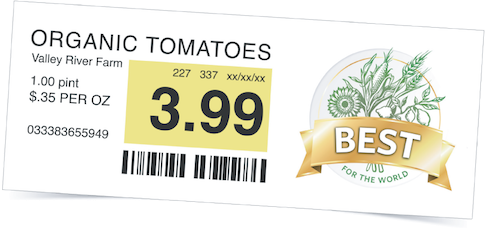
But what are they actually rating? And do these good-great-best ratings indicate the product is nontoxic?
HowGood evaluates products based on a grid of eleven categories having to do with sourcing, production, and organization. And each of these eleven categories has subcategories. Each gets a rating that results in a profile that looks something like this:
or
But the problem I have with this is, like virtually all other certification organizations, all you get is a seal and no details. If you click to the page and mouse over the green boxes on the second image, a window will pop up that gives you an explanation of the category, but no details on the product.
You can also go here to see the full grid and mouseover each square to see all the explanations, but I don’t see a page that fully explains any of them. When you look at these categories they cover toxic exposures but also labor, management, environment, and other factors. A product could rate high on management but low on toxics and still get a good rating. But I can’t analyze this because I have no data about how they came to these conclusions per product.
HOWGOOD’S “BEST” RATED BRANDS: here and here
THE BALTIMORE SUN: Supermarkets look to sustainability as the next organic
By contrast, I’ve been writing product recommendations at Debra Lynn Dadd Recommended Products that give you details on the company philosophy and each of the materials they use to make their products. I’d like to see more disclosure like this.
Any Experience with Hypnos or Saatva Mattresses?
I’ve received two comments asking about these mattresses.
Specifically these readers are wanting to know if anyone has experience with these mattresses—good or bad.
Hypnos is a long established manufacturer from the UK that uses “natural and sustainable” materials, but doesn’t say what they are. They use such luxurious materials as cashmere, camel hair, silk and alpaca for covers over a British wool-and-polyester cushioning. No mention of any materials being organic.
Saatva has organic cotton covers over polyurethane foam (they say it’s bio-based but it’s only a small percetage of bio). They also have a natural latex foam (not organic) mattress.
Thank you.
Weston A. Price Foundation Guide to the Highest Quality Foods Available
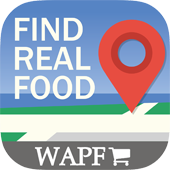 This online and cell phone app helps you find most natural, nutrient-dense foods available near your home or while traveling. Extensive database of 15,000 products sold in 100,000 locations in the U.S. Included a detailed list of how foods and food products are chosen and rated. All foods listed have been meticulously researched and approved by WAPF, which has been providing yearly food guides since 1999. Subscription $6.99/year.
This online and cell phone app helps you find most natural, nutrient-dense foods available near your home or while traveling. Extensive database of 15,000 products sold in 100,000 locations in the U.S. Included a detailed list of how foods and food products are chosen and rated. All foods listed have been meticulously researched and approved by WAPF, which has been providing yearly food guides since 1999. Subscription $6.99/year.
Worthy Goods Textile
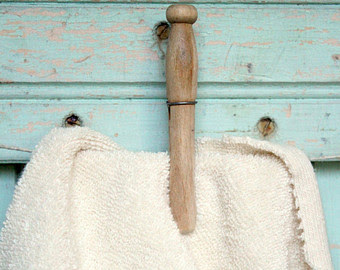 Some unusual GOTS Certified organic fabrics such as organic cotton fleece, terry cloth, flannel in patterns, and more.
Some unusual GOTS Certified organic fabrics such as organic cotton fleece, terry cloth, flannel in patterns, and more.
FruitShare Organic Fruit Delivery
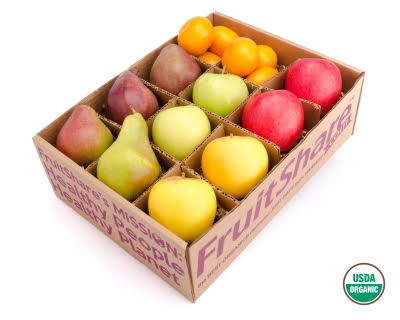 “The most delicious and nutritious farm fresh fruit in season all year long…A beeline from the farm to your door… Picked fresh, shipped fast, always organic. At FruitShare, we know what fruit should taste like. We know that farm fresh fruit is the best because it is almost as fresh as picking it yourself – resulting in flavorful, juicy fruit packed full of nutrients. With FruitShare, you’ll know where your food comes from. We send an eco-friendly e-newsletter to you with every box, detailing stories from the farms, plus tips for handling your fruit, health and wellness information, and recipes. We’ll connect you to the farmers, whether they’re local or all the way across the country.” Fruit clubs, gift boxes, fundraisers.
“The most delicious and nutritious farm fresh fruit in season all year long…A beeline from the farm to your door… Picked fresh, shipped fast, always organic. At FruitShare, we know what fruit should taste like. We know that farm fresh fruit is the best because it is almost as fresh as picking it yourself – resulting in flavorful, juicy fruit packed full of nutrients. With FruitShare, you’ll know where your food comes from. We send an eco-friendly e-newsletter to you with every box, detailing stories from the farms, plus tips for handling your fruit, health and wellness information, and recipes. We’ll connect you to the farmers, whether they’re local or all the way across the country.” Fruit clubs, gift boxes, fundraisers.
The Old White House
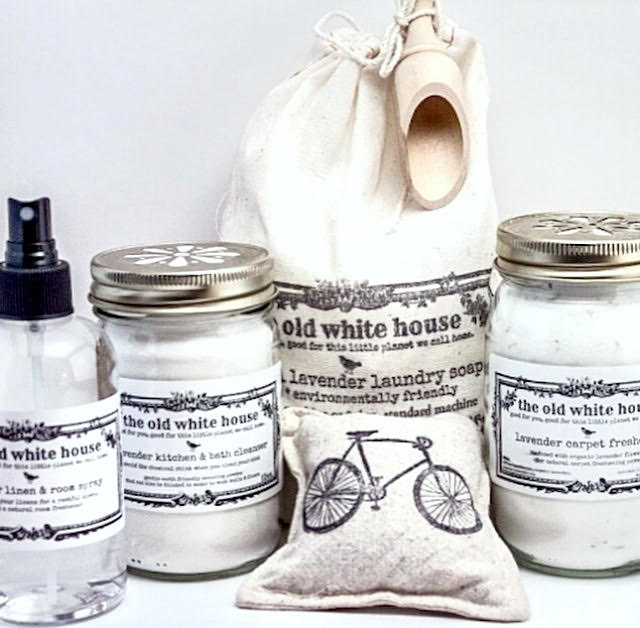 “Almost 5 years ago I decided to give making my own laundry soap a try, as a family of seven at the time we did a lot of laundry… a LOT of laundry! I had seen recipes floating around the internet, and gave a few a try. I didn’t find one that I thought did the job that I wanted it to, so I went back to the drawing board, and came up with a product that not only cleaned our laundry, but also made it naturally soft, and smelled amazing…Our lavender cleaning products include the following… soft, non-sudsing lavender laundry soap, organic lavender dryer sachets, lavender linen & room spray, lavender kitchen & bath cleanser, lavender carpet freshener and lavender soy candles. Our natural earth friendly and vegan lavender laundry and cleaning provisions are made with great care by my family and I. We make sure to use only earth friendly ingredients, pure lavender essential oil, organic lavender buds, natural cotton for the sachets that are stamped with waterproof ink, glass jars made in the USA, all packaged in a reusable cotton bag with a love of the earth and great pride in our products.”
“Almost 5 years ago I decided to give making my own laundry soap a try, as a family of seven at the time we did a lot of laundry… a LOT of laundry! I had seen recipes floating around the internet, and gave a few a try. I didn’t find one that I thought did the job that I wanted it to, so I went back to the drawing board, and came up with a product that not only cleaned our laundry, but also made it naturally soft, and smelled amazing…Our lavender cleaning products include the following… soft, non-sudsing lavender laundry soap, organic lavender dryer sachets, lavender linen & room spray, lavender kitchen & bath cleanser, lavender carpet freshener and lavender soy candles. Our natural earth friendly and vegan lavender laundry and cleaning provisions are made with great care by my family and I. We make sure to use only earth friendly ingredients, pure lavender essential oil, organic lavender buds, natural cotton for the sachets that are stamped with waterproof ink, glass jars made in the USA, all packaged in a reusable cotton bag with a love of the earth and great pride in our products.”
Eco Party Time
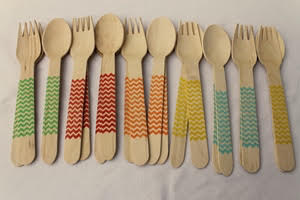 Plant-based disposable tableware, particularly for parties, but can be used anytime. Lots of colors and materials to choose from, including these wooden forks and spoons hand-painted with nontoxic inks. Read material descriptions carefully as the criteria for this website is “eco” rather than nontoxic. There are a lot of nontoxic products here that would make your party fun, just choose carefully.
Plant-based disposable tableware, particularly for parties, but can be used anytime. Lots of colors and materials to choose from, including these wooden forks and spoons hand-painted with nontoxic inks. Read material descriptions carefully as the criteria for this website is “eco” rather than nontoxic. There are a lot of nontoxic products here that would make your party fun, just choose carefully.
PBS Honors Rachel Carson on TV Show “American Experience”
Tonight, your local PBS station will air a new episode of “American Experience” about the life of Rachel Carson. Check your local television listings for the time. Here on the east coast it will be airing at 8:00 pm.
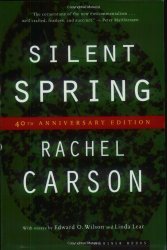 I highly recommend watching this to learn more about Rachel Carson’s life, her viewpoints, and how her book Silent Spring acted as the catalyst for our current awareness of toxics, the environmental movement, and the founding of the Environmental Protection Agency (EPA). I’ll be watching.
I highly recommend watching this to learn more about Rachel Carson’s life, her viewpoints, and how her book Silent Spring acted as the catalyst for our current awareness of toxics, the environmental movement, and the founding of the Environmental Protection Agency (EPA). I’ll be watching.
In conjunction with this, the New York Times ran an article yesterday: Rachel Carson, DDR and the Fight Against Malaria. It has a 12 minute video that also is well worth watching.
This video gives a good picture of why it’s so difficult to get toxic chemicals banned. Toxic chemicals are generally in use for a reason. In the case of DDT, at first it was to kill mosquitoes that cause deadly malaria. DDT was so effective with mosquitoes, it soon became used widely. Carson documented the health and environmental effects and soon DDT was banned.
But without DDT to control disease-carrying mosquitos, malaria soon again became epidemic.
This video shows how we can think beyond using toxics for a quick-fix and come up with more lasting sustainable solutions.
Polar Bear Cubs (and Humans) at Hight Risk from Toxic Industrial Chemicals, Despite Bans
A new story in Scientific American reports levels in polar bear cubs are 1000 times the acceptable level for humans.
“These persistent organic pollutants, or POPs, come from industry and reach the Arctic via air or ocean currents. The compounds include older chemicals like PCBs (polychlorinated biphenyls), whose production peaked in the late 1960s and early 1970s, and relatively newer ones including perfluorinated chemicals, which are used in water-resistant fabric coatings and firefighting foam. The pollutants have been linked with reproductive and immune problems in the bears as well as cancer, and their chemical structures make them nearly impossible for organisms to degrade.”
Bears accumulate high levels of the chemicals because they are top predators (just like we are).
Chemicals accumulate in both bears (and humans) because they build up through the food chain, in plants, fish and, for bears, finally seals—the bears’ main food source. Many of the compounds concentrate in the seal blubber, giving bears a hefty dose of chemicals when they eat seal blubber. The pollutants are then transferred to cubs via their mothers’ milk.
(And the same happens with humans.)
The study notes that between 1985 and 2010 the overall risk in cubs declined by 30 percent because many of the older chemicals were banned. Despite this progress, however, chemicals produced more recently are keeping the risk high. And these new chemicals, as well as the replacements for banned chemicals, are now being found in polar bear cubs in the arctic, thousands of miles from industrial civilization.
(It’s just interesting to me that this article, which is an environmental piece, makes no connection to the similar human exposure. The references to humans in this post are all mine.)
SCIENTIFIC AMERICAN: Polar Bear Cubs at Hight Risk from Toxic Industrial Chemicals, Despite Bans
Scientists Prove Link Between Aluminum and Early Onset Alzheimer’s Disease
We already know that aluminum is present is many consumer products, and that it builds up within our bodies rather than passing through.
Though a link between aluminum and Alzheimer’s Disease has been suspected for many years, even as recently as 2014 the link was largely unproven.
Now things have changed. Read more at…
GREENMEDINFO: Scientists Prove Link Between Aluminum and Early Onset Alzheimer’s Disease
Detoxing Aluminum Through Your Skin In A Simple Way At Home
 My guests today are Elizabeth and Michael Fessler, Founding Partners of Herbalix Restoratives. They make exceptional skin and hair products, some of which detox aluminum from your body as you sleep. Their products are designed to support skin functions with pure, natural and organic ingredients that cleanse and revitalize, while feeding the skin and hair vital nutrients. Today we will be focusing on their detox products. We will be talking about how aluminum enters your body and affect body function, and how topical detox can free the body from aluminum so it can function properly.
My guests today are Elizabeth and Michael Fessler, Founding Partners of Herbalix Restoratives. They make exceptional skin and hair products, some of which detox aluminum from your body as you sleep. Their products are designed to support skin functions with pure, natural and organic ingredients that cleanse and revitalize, while feeding the skin and hair vital nutrients. Today we will be focusing on their detox products. We will be talking about how aluminum enters your body and affect body function, and how topical detox can free the body from aluminum so it can function properly.
Audio + Transcript:
TOXIC FREE TALK RADIO: DETOXING ALUMINUM THROUGH YOUR SKIN IN A SIMPLE WAY AT HOME
HoBo Ties
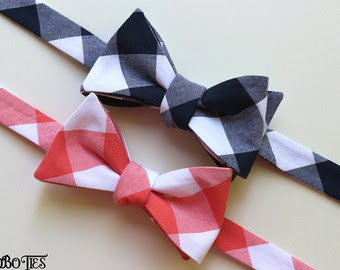 A delightful collection of natural fiber bow ties, neckties, pocket squares, cummerbunds and suspenders for men and boys. “All of our products are created with carefully chosen materials. We source professional hardware to use on our products that are made right here in the USA. Our fabrics are almost always cotton I saw a natural linen tie and sometimes we make specialty silk bow ties.
A delightful collection of natural fiber bow ties, neckties, pocket squares, cummerbunds and suspenders for men and boys. “All of our products are created with carefully chosen materials. We source professional hardware to use on our products that are made right here in the USA. Our fabrics are almost always cotton I saw a natural linen tie and sometimes we make specialty silk bow ties.
Bohemian Beetnik
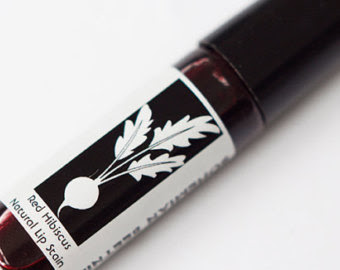 Handcrafted cosmetics and skin care made with botanical colors like beets and hibiscus. “So natural, you could eat it! All handcrafted and made in my own kitchen. I use my own recipes, not from a pre-made base. Our products do not contain chemical preservatives, artificial fragrances, or synthetic chemicals. No mineral colorants here either! Only pure fruits & vegetables, herbs & spices, and oils & butters. Organic ingredients used whenever possible!”
Handcrafted cosmetics and skin care made with botanical colors like beets and hibiscus. “So natural, you could eat it! All handcrafted and made in my own kitchen. I use my own recipes, not from a pre-made base. Our products do not contain chemical preservatives, artificial fragrances, or synthetic chemicals. No mineral colorants here either! Only pure fruits & vegetables, herbs & spices, and oils & butters. Organic ingredients used whenever possible!”
Groundwork
 Organic, fair trade coffees and teas from a popular Los Angeles coffee spot. Chose from single origin, signature blends, limited reserve and decaf coffees—every coffee has a story. Honey-processed coffee anyone? You’ll get a whole different view of coffee here. Flavors are described like poetry. “Groundwork was one of the first certified organic coffee roasters in Southern California and a pioneer in sustainable, relationship-based, and organic coffee sourcing.”
Organic, fair trade coffees and teas from a popular Los Angeles coffee spot. Chose from single origin, signature blends, limited reserve and decaf coffees—every coffee has a story. Honey-processed coffee anyone? You’ll get a whole different view of coffee here. Flavors are described like poetry. “Groundwork was one of the first certified organic coffee roasters in Southern California and a pioneer in sustainable, relationship-based, and organic coffee sourcing.”
Vintner’s Daughter
 A super-potent active botanical skin serum made from “the finest natural, organic and wildcrafted ingredients from conscious growers around the world … While researching her ever more complicated skincare regimen, winery owner, April Gargiulo realized that almost all of her highly touted skincare products contained high levels of ineffective, toxic fillers. As she researched more and discovered the cumulative damage these chemicals have on our systems, April sought out toxin free alternatives…Committed to creating the most active, luxurious serum possible, April began a 2 year-long research and formulation process. Drawing from her experience in fine winemaking, April, alongside natural skincare veterans set out to create a “hero” formulation that would address all of her skincare needs—everything from fine lines and wrinkles to acne to elasticity and general radiance. Much like the fine winemaking process, Vintner’s Daughter begins by sourcing the world’s finest raw ingredients and honors these ingredients through an exacting and time-honored formulation process. The result is Active Botanical Serum, a powerful, multi-correctional serum for face that has earned a cult status the world over.
A super-potent active botanical skin serum made from “the finest natural, organic and wildcrafted ingredients from conscious growers around the world … While researching her ever more complicated skincare regimen, winery owner, April Gargiulo realized that almost all of her highly touted skincare products contained high levels of ineffective, toxic fillers. As she researched more and discovered the cumulative damage these chemicals have on our systems, April sought out toxin free alternatives…Committed to creating the most active, luxurious serum possible, April began a 2 year-long research and formulation process. Drawing from her experience in fine winemaking, April, alongside natural skincare veterans set out to create a “hero” formulation that would address all of her skincare needs—everything from fine lines and wrinkles to acne to elasticity and general radiance. Much like the fine winemaking process, Vintner’s Daughter begins by sourcing the world’s finest raw ingredients and honors these ingredients through an exacting and time-honored formulation process. The result is Active Botanical Serum, a powerful, multi-correctional serum for face that has earned a cult status the world over.
Sun Basket
 A “healthy meal kit service” that delivers organic ingredients and easy, delicious recipes for cooking at home. “We source top-quality organic produce from the best farms, and sustainably-sourced meats and seafood. Plus, our packaging is 100% recyclable and compostable. Our recipes are created by Chef Justine Kelly, award-winning Bay area chef. Sun Basket makes it easy to stick to a healthy diet, no matter your lifestyle – we offer Paleo, Vegetarian and Gluten-Free meal plans, plus breakfast!”
A “healthy meal kit service” that delivers organic ingredients and easy, delicious recipes for cooking at home. “We source top-quality organic produce from the best farms, and sustainably-sourced meats and seafood. Plus, our packaging is 100% recyclable and compostable. Our recipes are created by Chef Justine Kelly, award-winning Bay area chef. Sun Basket makes it easy to stick to a healthy diet, no matter your lifestyle – we offer Paleo, Vegetarian and Gluten-Free meal plans, plus breakfast!”
The Challenge of Finding Product Information
Over the holiday I had reason to do some research on two products.
Both were products I had researched in the past. One was a product that I was considering purchasing for myself (the enameled pot I wrote about last week); the other was a product I was researching for a client.
The enameled pot was available as a brand name product and also as a “knock-off.” I had already researched the brand name possibilities, but not the knock-offs. Since this was a fairly pricey item, I really wanted to buy a knock-off but every time I looked at one, I just felt nervous and didn’t want to take a chance. Particularly since I would be using it for cooking food.
I knew the materials used in the brand name pots because I could call their customer service and get the information. But the knock-offs…you can’t even find out who to call. Store brands usually don’t manufacture their own goods and can’t answer questions. And so in the end I went with the brand name item and felt confident that I knew what the materials are.
That said, researching the other product for my client was a completely different experience. With this product it was very difficult to get any information calling the manufacturers. I really got the runaround. But I did persist and finally did get some of the information I was looking for. By contrast, when I contacted the smaller manufacturers who make this product, most of them responded immediately and were happy to talk with me in detail about their materials. One man had worked for the company for thirty years and we had a long talk. On the other hand, one brand had no manufacturer listing at all and I could even find a website for them.
My conclusion from this experience was:
- MAJOR MANUFACTURERS may or may not know much about their product materials, but at least you can generally contact them and ask
- KNOCKOFFS probably won’t know anything about their materials and you won’t be able to reach the actual manufacturer
- SMALLER MANUFACTURERS generally know most about their materials and are happy to tell you
Transparency and disclosure is a big issue I am working on for 2017. As I’ve said before, every product should fully disclose all materials in a format that is easy for consumers to understand.
This is why last year I started Debra Lynn Dadd Recommended Products, to help business communicate with consumers about their materials. Through this program, I write a Materials Review for products, which lists the materials and also gives background information to help consumers make decisions about the products.
Until all products have this level of transparency and disclosure, stick with brand name products and small businesses, where you can actually talk with someone and ask your questions. If there is no brand name or contact information, don’t buy the product.
Buy from reputable companies that know their materials and are willing to communicate about them.
Splenda Suppresses Thyroid Function, Promotes Weight Gain
This new article from GreenMedInfo.com outlines the range of health effects associated with sucralose (aka Splenda), including the first study to evaluate the effects of Splenda (Sucralose) on thyroid function and metabolism in mammals.
GREENMEDINFO: Spenda Suppresses Thyroid Function, Promotes Weight Gain
Green Chef
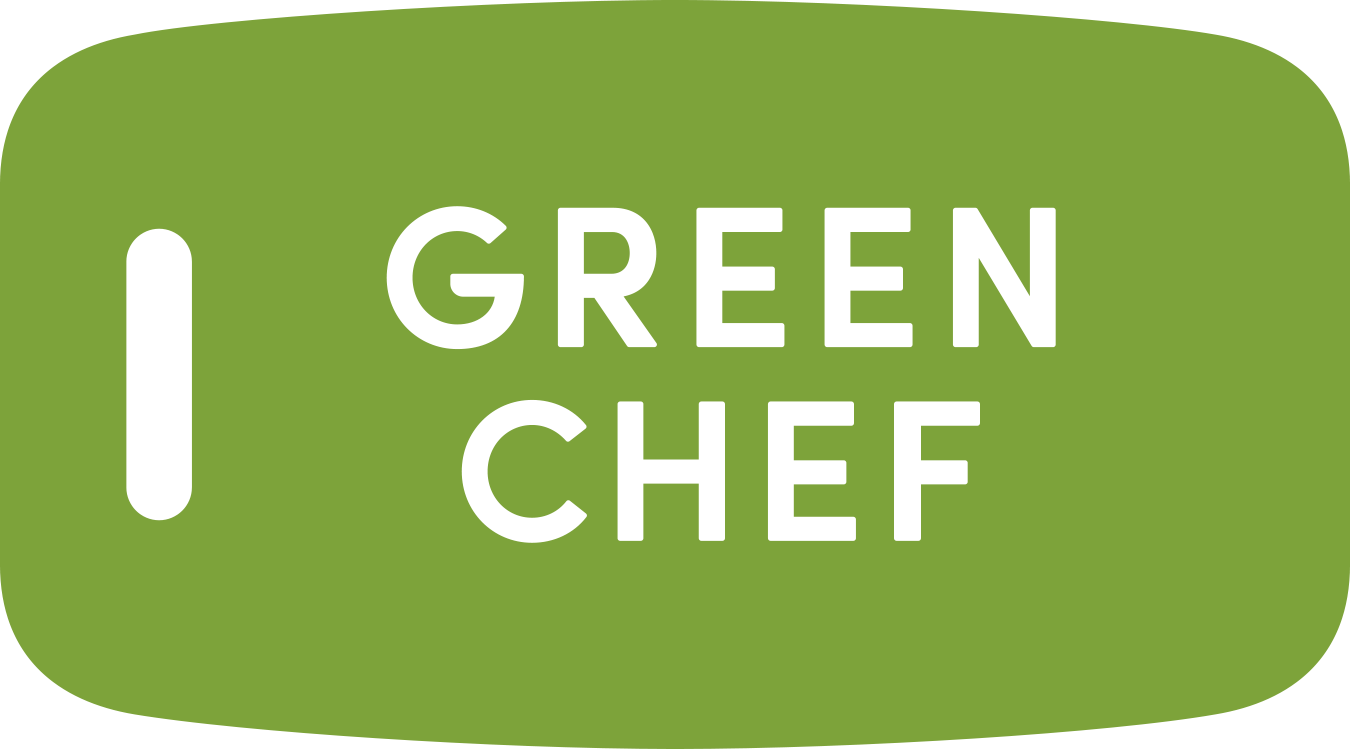 A USDA certified organic subscription meal delivery service that delivers organic ingredients and chef-crafted recipe to your door. All you have to do is follow the recipe using the provided ingredients and your meal is ready. Choose from vegetarian, omnivore, vegan, carnivore, gluten-free and paleo menus. And they profile their organic suppliers, so you can see exactly where your food is coming from.
A USDA certified organic subscription meal delivery service that delivers organic ingredients and chef-crafted recipe to your door. All you have to do is follow the recipe using the provided ingredients and your meal is ready. Choose from vegetarian, omnivore, vegan, carnivore, gluten-free and paleo menus. And they profile their organic suppliers, so you can see exactly where your food is coming from.
A Safe Alternative Slow Cooker
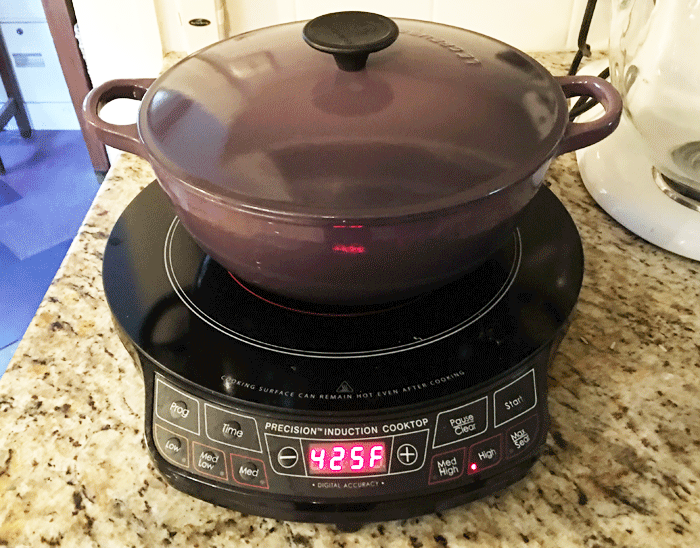
After writing this post I found that I actually first suggested this in 2013.
One of the things I love about Larry is he is really good at coming up with “thinking-outside-the-box” solutions to toxic exposures.
For some years one of the most frequently asked questions is “What slow cooker can I use?” And I’ve always had to say “I don’t know of one that doesn’t have lead in the glaze on the pot.” The only exception to this is the Vita Clay cooker, with an unglazed pot, but this is a rice cooker, not a crock pot of any size].
As some of you know, Larry has been living in California with his parents for the last few years while recovering from an accident. And now he’s in the process of moving back here with me.
While staying with his parents, he saw his father cooking on an induction cooktop. Because he and I both have a tendency to put food on to cook, set a timer and walk away and not hear the timer, he thought we should get one so it will just turn off at the right time and not burn. And that was reason enough for me to agree we should explore the possibility.
An induction cooktop is like a hotplate, but heats food with magnetic induction that directly heats the cooking vessel, so the pot can heat food rapidly. You can also set it to exact temperatures and cooking times, so it will turn off automatically, even if you forget to come and turn it off. It’s so precise, many chefs now use it. It’s easy to carry and can setup anywhere there is and electric plug. So it pretty much can function as a slow cooker.
Magnetic induction doesn’t release toxic pollutants into the air like the combustion by-products from gas. It of course would release some EMFs, but I couldn’t find any data on this. I imagine it wouldn’t be more than an ordinary crock pot and maybe even less.
My biggest concern was the pot. Magnetic induction doesn’t work with my Xtrema cermamic cookware because the cookware needs to be made of a material that is magnetic. You can test any cookware by putting a magnet on it—if it sticks, it will work for magnetic induction. Or look for the induction-ready symbol, or search online for “induction-ready cookware.”
We did some research and decided that the best cooking vessel for us to buy to use with the induction cooker was a cast iron pot with a porcelain enamel finish on the inside. I had already researched Le Creuset and was comfortable with the Le Creuset enamel finish so we bought a Le Creuset soup pot that happened to be on sale at Marshall’s, of all places.
We love this! And we haven’t burned anything since.
We got the NuWave Precision Induction Cooktop. But there are also other brands. We couldn’t find these in stores, but there are many styles on the Internet. We chose this one because it was the one Larry’s father uses and Larry wanted the same one.
NuWave also sells a full line of induction-compatible cookware that has a Duration “ceramic” finish. I called NuWave Customer Service at 1 855 742 2665 and asked what the Duration finish is made of. I found out that they actually have a number of different finishes on various cookware sets and they don’t know what any of them are made from.
I found Duralon online at what looks like the manufacturer’s website. They are in Australia, so they are not available as I am writing this. They have several Duralons made from nylon reinforced with glass or glass and minerals. That’s all I could find. Nylon in general is one of the safest plastics and can be used without melting at very high temperatures.
So while I can’t recommend NuWave’s induction cookware, I can say I’m very happy with my NuWave induction cooker
So this morning, after writing this yesterday, I got up early. I had been soaking beans overnight to cook this morning. Because Larry was still asleep and I myself hadn’t yet learned to use the induction cooker, I decided to just cook the beans “the old way” on the stovetop. Well, the beans boiled over and I had to relight the gas burner and I thought, “If I would just learn to use this induction cooktop, I could just set it to one temperature to bring it to a boil and then program it to other temperature to simmer the beans and then program it to turn off.” And that quite delighted me. I just now need to figure out those perfect cooking times and temperatures and I’ll be able to do that. It’s a whole different thinking process about cooking.
More on Slow Cookers
We’ve been discussing slow cookers on this blog for years.
Just this last week a reader posted a comment and said that recent tests had found some crock pot glazes to be free from lead!
And she sent me the link: TERMINAl VERBOSITY: The skinny on lead in crackpots—It may surprise you!
The anonymous blogger wrote (in 2009) “I don’t like ambiguity, especially when it comes to the health of my children. So I was alarmed when I couldn’t find a satisfactory answer to the question: “Do modern-day crock pot glazes contain lead that can leach into my food?”
So she found the FDA guidelines, called manufacturers, and tested crock pots herself. And she found ZERO LEAD in the top five brands.
Here are some other interesting links from my reader regarding lead glazes in crock pots:
ECO-FRIENDLY BABY/FAMILY PRODUCTS MADE IN USA: Lead in Hamilton Beach crock pots
Regarding this second link my reader wrote, “The lady at Lead Safe America has sons who are lead-injured, so I find her work informative, as she knows firsthand what lead poisoning looks like. It seems to me that some of the crocks contain very low lead because it is inherent in the raw materials, not added in the glaze; I believe that is the point she makes. And this is the same argument made by the Earthpaste toothpaste company — that the lead in their toothpaste is natural in the raw materials. I see that the black Crockpot brand pot at the second link tested as completely lead-free.”
Get an induction cooker and you can choose your cookware. And you can cook in all different sized pots and pans.
More on Aerotoxic Syndrome
In July 2015 I interviewed a former flight attendant on Toxic Free Talk Radio regarding aerotoxic syndrome—a condition caused by toxic chemical exposure during airplane flights. TOXIC FREE TALK RADIO: Aerotoxic SyndromeL How Flying in Airplanes can Affect Your Health
This week, GreenMedInfo has a new investigative report on toxic exposures in the aviation industry.GREENMEDINFO: “Asbestos of the Sky”—The Aviation Industry’s Darkest Coverup
And here’s a documentary about aerotoxic syndrome: UNFILTERED BREATHED IN—The Truth about Aerotoxic Syndrome
And here’s an article about how pesticides are sprayed on passengers: NATURALHEALTH365: Government advises airlines to spray pesticides on passengers. If this title sounds alarming, check out this report that explains when and why pesticides are sprayed: Flyers Beware: Pesticide Use on International and US Domestic Aircraft and Flights
Clothing Companies in India are Cleaning Up Their Act
This week The Washington Post published a piece about health and environmental effects of clothing production in India, and and how “A new crop of small businesses are investing in organic farming, natural dyes and a transparent supply chain that encourages shoppers to think about the effect of their purchases.”
Good news.
EnviroKlenz Face Mask
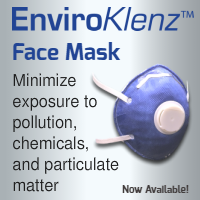 A face mask developed especially for people with MCS. It utilizes the EnviroKlenz patented earth mineral technology which has the ability to chemically dismantle a wide range of undesirable chemical compounds.The fibers of the mask can filter out many common particulates. Reduces exposures to fragrances, VOCs, pollen, dust, dander, odors, and more. It’s light weight, comfortable, reusable, and latex free. I have one here and the mask itself is odor-free.
A face mask developed especially for people with MCS. It utilizes the EnviroKlenz patented earth mineral technology which has the ability to chemically dismantle a wide range of undesirable chemical compounds.The fibers of the mask can filter out many common particulates. Reduces exposures to fragrances, VOCs, pollen, dust, dander, odors, and more. It’s light weight, comfortable, reusable, and latex free. I have one here and the mask itself is odor-free.
Kid Licks
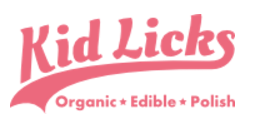 OK OK I finally found a nail polish that I can recommend. It’s “so natural it’s edible.” Really. Zero toxic fumes. And some ingredients are organic. This stuff smells like fruit. The polish goes on smoothly and has a beautiful finish. Vibrant color. I can’t find anything toxic about it. Takes longer to dry than toxic nail polish. And it washes right off with water. It’s really designed for little girls to play dress-up, and it wouldn’t stand up to a day of washing hands or dishes. But if you want to play dress-up for a special night out, or put it on your toe nails until your next shower, this would be great. I’m going to play with the sample they sent me.
OK OK I finally found a nail polish that I can recommend. It’s “so natural it’s edible.” Really. Zero toxic fumes. And some ingredients are organic. This stuff smells like fruit. The polish goes on smoothly and has a beautiful finish. Vibrant color. I can’t find anything toxic about it. Takes longer to dry than toxic nail polish. And it washes right off with water. It’s really designed for little girls to play dress-up, and it wouldn’t stand up to a day of washing hands or dishes. But if you want to play dress-up for a special night out, or put it on your toe nails until your next shower, this would be great. I’m going to play with the sample they sent me.
Cotton organic towels
Question from Meryl
Hi Debra,
Thanks for a great site!
I am looking for organic cotton bath towels and bath mat in beige for my bathroom.
Do you have any new recommendations?
Thanks very much for any info!
Debra’s Answer
This was not difficult to find online.
I just typed “organic cotton bath towels beige” into Google and got a number of responses.
Here are some from a popular online retailer:
Here are some other choices…
Plenty to choose from. Also more at Debra’s List: Bath Linens
Hypoallergenic Cluster Fiber
Question from Jamila
Hi Debra,
doing some research, trying to find out what actually IS hypoallergenic cluster fiber used in mattress toppers…is it entirely free of chemicals that can out gas? how can a polyester fiber be hypoallergenic??
Debra’s Answer
Labeling says cluster fiber products are “100% polyester,” but that may be the primary material. Unknown chemicals may be present that are not accounted for.
Cluster fiber is a synthetic alternative to down.
It is “hypoallergenic” because it does not lead to allergic reactions caused by down and feathers.
Nontoxic Mattress Pad for Bedridden Elderly?
Question from Karen
Hi Debra,
I am looking for a mattress pad that will help eliminate bed sores and ulcers for my bedridden husband. We tried a polyurethane product that was nearly $100 for a single bed. It emitted an odor that was unacceptable and we returned it. I have found some websites that are selling a latex based mattress pads but I can’t find any information about whether they are recommended for bedridden elderly people. Do you have any help for me?
Debra’s Answer
Ask the retailers who are selling the latex pads if they are suitable for your needs.
Readers, any experience with this?
Dog Stink
Question from Miko
Hi Debra,
I have dogs and I hate their smell ,and it seems to be a constant struggle to keep them clean/ not stinking with their weekly bath; I use ONLY organic ,human shampoos and that only lasts a couple of days,smell-wise
any ideas about organic alternatives for their bathing? Enzymes ?
anything ,also organic,and non toxic ( the catch words ) to freshen up the air until the next weekly bath? diffusers? incences?
I have a giant and powerful airfilter,which helps with the dust and hairs,etc but the dogs still stink pretty badly
Thanks.
Debra’s Answer
I don’t have dogs, so readers, any suggestions?
Toxic Free Down and Feathers for Pillows and Comforters
Last week I received a comment posted to Q&A: Non-Toxic Comforter. It really needed a whole post to answer, so here I am.
Here’s the comment:
I came to tbis page looking for info as to whether it’s possible to find a non toxic down comforter and thought I’d find info, given the title above but I’m not seeing the toxicity issue addressed. Did I overlook something? It’s my understanding that two of the main concerns w down is that it’s chemically processed and as with most bedding contains fire retardants and other chemicals. Is it possible to get a down comforter free of all these toxic ingredients?
And the answer is yes, it is possible to get a down comforter without chemical processing or fire retardants.
But first I want to answer the question about possible toxic exposures from down.
I’ve been researching and writing about nontoxic and natural products for more than thirty years. And I’ve owned and slept under a few down comforters. I never noticed them to be toxic in any way and so never did any research about how they might be toxic.
However, reading that down might be chemically processed and contain fire retardants, I had to research those specific questions and also see what is being offered today with regards to down comforters.
How Down is Collected
According to the American Down & Feather Council, “80 percent of the down and feathers used globally [are] produced in China; the majority—90 percent—come from ducks.” If you want to read more about this, and how the down is removed from the ducks, you can read all about this here.
But not all down is produced this way.
“The pure and comforting feathers that fill each of our 100% organic cotton shells travel a whopping one hundred miles down the road from Indiana where they are gathered on a small duck farm.” —Coyuchi.
“hand harvested during the molting season of the bird in a effort to not harm the beautiful bird’s or there habitat. After harvesting the down is hand sorted into different levels of quality based on the size of the harvested clusters. The larger the cluster the better the quality. Harvesting and sorting goose down by hand is very tedious and time consuming but it ensures consistent fill quality across our brands from year to year.” —Down & Feather Company.
There is now a Responsible Down Standard that uses Control Union (a certifier of organic agricultural materials) to certify down and feather that come from birds primarily raised for meat and meet strict animal welfare standards. I don’t know what those standards are because the standards page on the RDS website had been removed.
So in choosing a comforter, you want to look for a description of where the down was sourced and by what method. If the website doesn’t tell you, ask.
How Down is Processed
After down is collected, dust and dirt must be removed. This occurs through washing and drying. Washing agents may be used with unknown ingredients and fragrances. Otherwise, it’s pretty much wash and dry in a drying machine.
The International Down & Feather Testing Laboratory , located in Salt Lake City UT “audits and inspects the entire supply chain including farms and other raw material sources, slaughterhouses, synthetic fiber processors, down and feather processors and finished product sewing factories.” So you might want to find out if the down has been inspected by this organization, but I don’t know their standards.
Chemical Treatments Used on Down
The only chemical treatments I could actually find that are used on down are for making it moisture-resistant.
This down is often called “dry-down,” “hydrophobic down” or something similar. It seems to be being offered as an option, so you can choose to avoid it. Or it would be on the label as a benefit. If you don’t see mention of it on the label, it’s likely the down is not moisture-resistant.
The reason down is treated for moisture resistance is because when down gets wet, it loses it’s loft.
What chemical is used to treat the down is anyone’s guess. “some sort of chemical water repellant, “ ” a molecular level polymer applied to individual down plumes during the finishing process, ”nano technology.” I’m guessing that it’s a perfluorinated compound (PFC), which is used to waterproof many outdoor materials. It’s pretty toxic. Teflon is a PFC.
I did find a treatment for moisture-resistance called “Tan-O-Quil-QM.” There is a whole report available about this treatment that says it is a chrome tanning agent used to increase the fill power and a hydrophobic from complex to increase the water repellency. Now I don’t know if this is still being used. The report is from 1968 and the Code of Federal Regulations says that no down can use the term unless the agent actually has been applied to the down. I couldn’t find any down with Tan-O-Quil-QM online, so I think this is obsolete. But chrome may still be used for waterproofing just as it is used for tanning leather.
There is also some speculation that down is treated with formaldehyde, moldicides, flame retardants and other chemicals, but the only actual data I found online was for moisture proofing. And not much on that.
I doubt that you would find flame retardants on down itself. It’s more likely that the finished item would be treated. Researching this I found a post from this very blog where I reported on a study of flame retardants in pillows As expected there was a huge amount of flame retardants in the polyurethane foam pillow (because it is so flammable) and only 6 parts per million in a feather pillow that probably was not even treated.
Comforters Made With Chemical-Free Down
If you are looking for untreated down, forget about buying your comforter at a discount warehouse and instead look for small businesses online.
Here are a few I’ve found.
Northern Goose Down
“truly hypoallergenic & chemical free Goose Down”
Dewoolfson
“Our experience has shown, however, that these chemicals are toxic and not something that we, or our customers, would want to sleep under every night. We know of one case where an employee was exposed to these chemicals, causing burn-like blotches that required several weeks of treatment. It’s far easier and safer to just store your down products carefully, and like anything else, away from damp areas. ”
Coyuchi
“All of our down duvets and pillow inserts are made in the U.S.A. The pure and comforting feathers that fill each of our 100% organic cotton shells travel a whopping one hundred miles down the road from Indiana where they are gathered on a small duck farm. Before filling the inserts, the down is treated with steam twice to kill bacteria and gently washed with a fragrance-free, non-toxic soap to remove bacteria that is incidental to feathers and down. Next, a water-based, non-toxic chemical is used to reduce the static charge that is associated with natural filling. Both the winter weight and lightweight duvets have a 600-fill power for a cozy and comforting sleep.”
Pacific Coast Bedding
Has a whole page on how they process their down.
Allergy Buyers Club
“The down and syriaca in these comforters is the cleanest, least treated fibers we could find anywhere. The down is de-dusted and gently washed up to 8 times in an environmentally friendly cleansing solution and rinsed three times. This cleaning process and renders it pH neutral. This is the most hypoallergenic down comforters we could find – due to the quality of materials used, cleaning process and the addition of the addition of the natural syriaca clusters.”
A Comparison of Certified Organic Mattresses
Read more about certified organic mattresses in the comments
(click here)
There’s been a discussion happening on my Q&A: Berkeley Ergonomics post about organic mattresses and i just want to bring this subject into it’s own post.
The discussion started with a reader asking about a line of mattresses made by Berkeley Ergonomics. I said it looked OK on paper but they were claiming organic certifications and not displaying them. I said “ask for their certifications.”
Well, a reader wrote back and said:
I asked to see the certifications and they refused to send them to me. In fact they got very defensive. I would love to see them if you are able to get them. I am very suspect of any firm who makes organic claims but won’t provide the certificates. They should be PROUD of them, not want to hide them. It is my understanding that they get the fabric from Europe and do all the sewing themselves so they are handling the materials a LOT. I would be very interested to know if they are handling the materials in a fashion that maintains organic integrity.
This is a great question. There are three parts to the making of an organic product:
- the materials need to meet organic standards
- all the facilities that handle the organic material must be certified
- the handling of the material in all the certified facilities also needs to meet organic standards.
In other words, there are multiple certifications and associated transaction paperwork that are required before an item can be certified organic:
- the material that’s being used in the production process, for example cotton, must be certified as having been grown as organic cotton
- all the facilities (beginning with the organic fiber on the certified organic farm all the way to the facility that makes the final stitch) must be certified, and then
- each facility that moves the materials to the next facility in the production process must get a transaction certificate from the organic certifier who certifies the previous facility so that the next facility is assured that the materials are part of the organic production chain.
For a mattress to be an “organic mattress” it needs TWO certifications (in addition to transaction certificates): one for the materials and another as an organic handler, or manufacturer.
I mentioned that Naturepedic is the only certified organic manufacturer that I knew of and a reader commented, “Actually OMI, Lifekind and Savvy Rest are organic.”
So I want to take a look at these four companies: Naturepedic, OMI, Lifekind and Savvy Rest and see how organic each of them are. I will just disclose that I have known Naturepedic for many years and am very familiar with their products, materials, and philosophy (I wrote a review of their materials for Debra Lynn Dadd Recommended Products. But let’s just look at what each has to say on their websites.
Here’s what I’m going to look for and what you should look for when evaluating whether or not a mattress is organic:
- What is the claim?
- Do they have certificates publicly displayed?
- What are the certificates certifying?
- Who has done the certification?
- What are the standards for the certification?
- What are the dates the certificate is valid?
- What is the name on the certificate?
So let’s take a look…
Savvy Rest
Let’s start with Savvy Rest. www.savvyrest.com/certifications
The first certification they list is GREENGUARD GOLD. This is not an organic certification at all. It measures emissions against a certain standard. If you go to their website and search for mattresses you will see that many mattresses qualify to be GREENGUARD gold certified even if they have materials like vinyl covers, that I would not recommend. So this certification does not contribute to their being an organic mattress.
The next Savvy Rest listed certification is USDA Organic. This applies to their Dunlop latex supplier’s rubber tree farms. And then the latex processing is certified by the International Control Union to the Global Organic Latex Standard (GOLS). All that seems fine. Their latex seems to be organic.
Then Eco Institute, which apparently is their latex certifier. Savvy Rest says, “Our Dunlop supplier, Cocolatex, has achieved Eco Institut certification for the purity of their organic latex.” Go ahead, click. Ah, the certificate is for natural latex. This is a “natural” certification. No organic here.
OEKO-TEX Standard 100 also is not an organic standard. This standard says that the material is below an established standard for 100 toxic substances.
The Environmental Protection Encouragement Agency (EPEA) was founded in 1987 by Michael Braungart to implement the Cradle-to-Cradle philosophy. The standards of this philosophy (which I greatly admire) includes the elimination of a list of toxic chemicals. But this is not an organic standard either. This certification is for Radium Foam, their supplier of (petroleum-based) Talalay latex. Again this is not an organic certification. It’s not even natural latex. [Radium Foam wrote to me from the Netherlands and explained that they supply certified natural latex to North America.]
The only thing certified organic about a Savvy Rest mattress is their USDA and GOLS certified organic latex. But not all their latex is organic. Only their USDA and GOLS certified organic Dunlop latex.
Finally, go to the website for the global organic textile standard: www.global-standard.org. There is NO certification for Savvy Rest as an organic mattress manufacturer. So we don’t know know how they are handling these materials.
Therefore, as far as i am concerned, this is NOT an organic mattress.
OMI and Lifekind
I’m putting OMI and Lifekind together because both these brands are made in the same factory, yet they present themselves as separate businesses with separate names and websites.
Let’s first look at their shared GOTS-certified Eco-Factory. You can read about it here on the OMI website and here on the Lifekind website. I’m not questioning that the factory is certified organic, I’m only commenting that they are not showing the certificate. But they do have one. See their listing in the GOTS database
So OMI can legitimately call themselves an organic mattress manufacturer. There is no GOTS certification for Lifekind listed in the GOTS database. I don’t know what the arrangement is between these two brands, but the GOTS certification is for OMI.
That said, let’s look at their individual claims about certification.
OMI
OMI also has a whole page of certifications at www.omimattress.com/Certifications.php.
This page starts out with a whole paragraph of firsts, which may or may not be true. There are no links to substantiation. They end the paragraph with the statement, “and a printout of our mattress emissions can be found on the UL/GREENGUARD website here. That would be great to see a printout of their mattress emissions. But I couldn’t find it.
They then go on to list numerous certifications, including USDA Organic, Texas Department of Agriculture, GREENGUARD, Oeko-Tex, and others that aren’t even certifications. None of them have certificates.
Mixed in with all these are their GOLS certification for organic latex and their GOTS certification. But they don’t even mention that they are a GOTS certified organic mattress manufacturer. They only say that their organic wool, cotton, and fabrics are GOTS certified.
All they need to say is they are a GOTS certified organic mattress manufacturer and show us the certificate. That covers the whole mattress—all the materials and manufacturing process. Their certification is valid until 2-17-2017. I can tell you they are certified because I went to the GOTS website and found their certification.
Lifekind
Lifekind has their own list of certifications at www.lifekind.com/organic-certifications
“Lifekind’s latex mattress cores are certified to the Global Organic Latex Standard. GOLS is a new certification available to mattress manufacturers.” OK. They have a certificate. Valid until December 16. But it’s a certificate for “Organic Mattresses, Inc.” Which is OMI.
And then they go on to list the same materials as given on the OMI certifications page. Look at these two pages and compare them for yourself.
So it’s clear to me that whether a mattress is branded OMI or Lifekind, it’s pretty much the same mattress, made in the same certified factory from the same certified materials. But neither of these companies are presenting their certifications so consumers can see and verify them, and it appears that Lifekind as a company has no certifications at all.
I’d love to see both these companies improve their presentation of their certifications and be more clear about their relationship.
Naturepedic
Naturepedic lists all their certifications at
www.naturepedic.com/the-naturepedic-difference/certifications-awards.
Right at the top of the page they tell us they are a Certified Organic Mattress Manufacturer & Facility. “All Naturepedic mattresses meet the organic and non-toxic standards of the Global Organic Textile Standard (GOTS) and/or the Global Organic Latex Standard (GOLS). U.S. Department of Agriculture (USDA) recognizes GOTS as the standard for organic consumer goods.” And then they link to their certificates, which are made out to Naturepedic. GOTS Certification, GOLS Certification
They also show their organic content standard certification. The Organic Exchange Certification Program which ensures proper tracking of organic material from its source to the finished product. Naturepedic is certified to meet this standard, demonstrating that the organic fiber in their products has been independently verified. OCS 100 Certification.
Naturepedic also has a GREENGUARD GOLD certification and a UL Formaldehyde-Free Verified certification, and Naturepedic products have been scrutinized by scientists and experts to ensure they do not contain any harmful materials for the Made Safe certification. All of these certifications are current and have valid certificates made out directly to Naturepedic and which clearly list all the Naturepedic products.
Therefore, in fact, Naturepedic truly is a GOTS certified organic mattress manufacturer and does business responsibly.
But I also have to add that Naturepedic not only meets the GOTS organic standards, they go above and beyond them.
- Naturepedic developed the patent on using food-grade polyethylene for waterproofing, instead of using vinyl or perfluorinated compounds (PFCs) or polyurethane. Then, Naturepedic has gone yet another step further and is making its food-grade polyethylene from non-GMO sugarcane.
- Naturepedic is now also using its sugarcane based food-grade polyethylene for its mattress cores, for those crib mattresses that do not use steel innersprings. (Naturepedic also does not use latex, even if organic, in its baby products because it has a separate policy not to use any materials in its baby products that might pose allergenic concerns.)
- Naturepedic does not use any chemical flame barriers or any other flame retardant chemicals whatsoever. All Naturepedic products are designed to meet all flammability requirements without having to rely on flame barriers/retardants.
- Naturepedic has purchased its own machine for making binding materials (aka “tape edge”) and is apparently now the only company that makes much of its binding from certified organic cotton.
- Naturepedic has purchased the last machines anywhere in the world that makes encased coils with sewn certified organic cotton encasing. (These are old German machines that are no longer being manufactured.) Virtually all encasing machines available today spray the encasings with glues, but Naturepedic refuses to use any glues/adhesives in any of its products.
- Naturepedic products are almost entirely free of any petroleum based materials or components.
In short, Naturepedic has become the gold standard for mattresses.
And the Moral of the Story Is…
Always, always, always look for the organic certificates, and make sure they are issued to the company making the claim (and not just to one of their suppliers, which proves little, because a supplier’s certification shows no connection to the mattress company) Independent third-party certification is the only way to know materials really are organic and the organic materials are being processed to similar organic standards.
I’m not trying to be critical here. I’m trying to raise the bar.
As consumers we can’t make informed decisions unless we have information about the materials used to make the products, presented to us in a way that are documented and can be understood. And as consumers, we need to learn what the certifications mean and how to read them.
All the information in this post is taken straight from the webpages given. You can go there and see for yourself.
I’d love to know your comments.
Pdfs of the certification pages mentioned that I examined on 28 and 29 November 2016:
Savvy Rest certifications page pdf
OMI certifications page pdf
Lifekind certifications page pdf
Naturepedic certifications page pdf
Help the FTC Stop Organic Fraud
We all want to buy organic, but in order to find out if a product is actually organic, it needs to be properly labeled.
Unfortunately, there are many non-food products that misrepresent themselves as being “organic” with false claims or misleading language.
Organic food has to be certified to the U.S. Department of Agriculture’s National Organic Program (NOP) standards. Non-food products may be certified to USDA Organic food standards, but the NOP doesn’t require certification and it doesn’t enforce against most false “organic” claims on personal care or textile products.
The good news list that the Federal Trade Commissions (FTC) has landed an investigation into organic fraud.
And they want to hear from us about how to stop organic fraud.
Read more about the problem and sign an FTC petition here
To make sure you are getting real organic products:
- For food products—look for the USDA Organic
- For textile products—look for the Global Organic Textile Standard (GOTS)
- For personal care products—look for USDA certified organic ingredients and companies that are certified organic handlers.
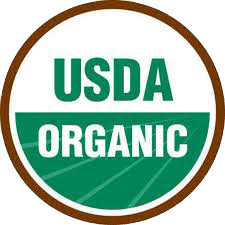
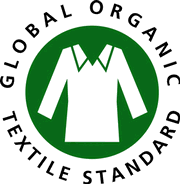
Frog Hollow Farm
 Sweet, tree-ripened organic fresh and dried fruits plus various food products, all grown on their certified organic farm in California. Multiple varieties of cherries, apricots, peaches, nectarines, plums, pluots and pears. These are superior quality fruits. They have a shop and cafe in the Ferry Building Marketplace in San Francisco, and I would always stop and get something when I used to live there. Farm-to-table delivery, fruit clubs.
Sweet, tree-ripened organic fresh and dried fruits plus various food products, all grown on their certified organic farm in California. Multiple varieties of cherries, apricots, peaches, nectarines, plums, pluots and pears. These are superior quality fruits. They have a shop and cafe in the Ferry Building Marketplace in San Francisco, and I would always stop and get something when I used to live there. Farm-to-table delivery, fruit clubs.
Cafe Altura Gourmet Coffee
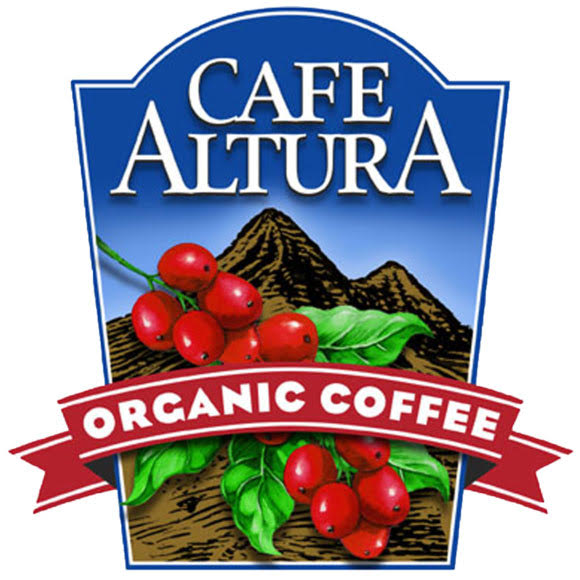 “The original organic coffee, since 1980.” This coffee comes from the Finca Irlanda farm in Chiapas, Mexico, which has now been growing coffee using organic and Biodynamic techniques for decades. It is believed to be the first certified organic coffee farm in the world. Choose from whole bean, ground, and even instant certified organic coffees, including water processed decaf.
“The original organic coffee, since 1980.” This coffee comes from the Finca Irlanda farm in Chiapas, Mexico, which has now been growing coffee using organic and Biodynamic techniques for decades. It is believed to be the first certified organic coffee farm in the world. Choose from whole bean, ground, and even instant certified organic coffees, including water processed decaf.
Creekside Farms
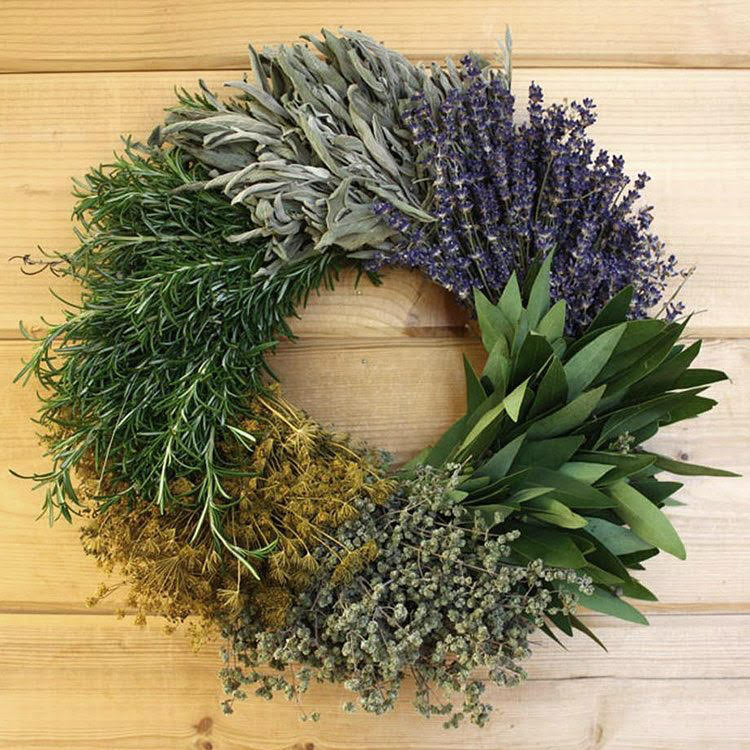 Artisan made wreaths, made on a farm that grows all their materials. Beautiful seasonal wreaths for home and gifts, plus fresh garlands and centerpieces and wreaths with lavender. “Our herbs and flowers are grown naturally without harmful pesticides. We grow and use lavender, olive branches, rosemary, sage, marjoram, oregano, thyme, cilantro, dill and various flowering herbs, such as yarrow, monarda and feverfew in our designs.”
Artisan made wreaths, made on a farm that grows all their materials. Beautiful seasonal wreaths for home and gifts, plus fresh garlands and centerpieces and wreaths with lavender. “Our herbs and flowers are grown naturally without harmful pesticides. We grow and use lavender, olive branches, rosemary, sage, marjoram, oregano, thyme, cilantro, dill and various flowering herbs, such as yarrow, monarda and feverfew in our designs.”
Modern Wool
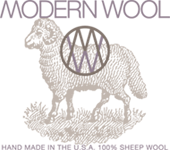 Woolen throws, blankets, scarves and other miscellaneous items made by hand from untreated wool. “We use premium French Merino sheep wool grown in Colorado. Their wool is very soft and not itchy, offering a cozy, comfortable feel for all our products. Next we hand knit them in Southern California. Wool being a natural made material also releases negative ions into the body which build up, strengthen and energize. It is also a temperature regulating material which allows the user to maintain a comfortable body temperature. 100% Wool knits, without synthetic additives, are hard to find and it was in my own fruitless search for them that I decided a product such as this should be on the market and thus Modern Wool was born.
Woolen throws, blankets, scarves and other miscellaneous items made by hand from untreated wool. “We use premium French Merino sheep wool grown in Colorado. Their wool is very soft and not itchy, offering a cozy, comfortable feel for all our products. Next we hand knit them in Southern California. Wool being a natural made material also releases negative ions into the body which build up, strengthen and energize. It is also a temperature regulating material which allows the user to maintain a comfortable body temperature. 100% Wool knits, without synthetic additives, are hard to find and it was in my own fruitless search for them that I decided a product such as this should be on the market and thus Modern Wool was born.
Nail17
“The only product available that kills all 17 bacteria known to cause unhealthy nails without using harsh chemicals or causing painful side effects. The formula was developed by a world-renowned professor at a leading university in Michigan, and remains the only all-natural solution. Athletes, seniors and anyone suffering can be freed from unhealthy nails with Nail 17. Nail 17’s patented formula combines the naturally occurring essential oils of Camphor, Thymol, Menthol, and Eucalyptus, specifically selected for their ability to promote healthy nails. Each individual oil contains properties that effectively stops the progression of the 17 microbes that cause unsightly nails, promoting healthy new nail growth. The inactive ingredient, Isopropyl Alcohol, carries the four essential oils to deeply penetrate the nail plate.” NOTE: I don’t usually recommend isopropyl alcohol, however I am recommending this product which contains it because it is much safer than other treatments.
RX4NAILS
All-natural nail and cuticle oil made with certified organic essential oils guarantees it will improve your nails so they don’t bend, tear, or break. “Rx4Nails is a proprietary blend of all natural, certified organic oils and vitamins. The base ingredient is Soybean oil, with a dollup of coconut oil.”
Ward Pumice Company
“Sustainably harvested pumice kept exactly the way nature made it….over 99% of stores’ so-called pumice is adulterated..crushed to granule and powder, then “glued” back together and injected into molds.In corporations’ quest for product uniformity and large consistent supply, pristine stone’s original abrasive quality is compromised.” Retail outlets
My Thoughts on the Presidential Election
I removed this post and all its comments after a reader brought to my attention that it was off topic for this blog. I agree, I’ve never discussed politics and I will continue that policy.
How to Get Chemicals Out Of Your Washing Machine
I’m writing this post because more often than I’d like I get questions from people who have washed clothing with chemicals in the fabrics and then are not sure if the chemicals are still in the washer. Or they wash something scented and can’t get the fragrance out.
Here’s what to do.
One day I was doing a test on a product and intentionally put perfume on a piece of clothing and then washed it in my washer. My washing machine was now scented and I couldn’t get the scent out.
What worked was a product called “washing machine cleaner”. I used the Clorox brand, but there are others. You find it in the laundry products section of a supermarket.
It’s really really really strong chlorine bleach.
But it did remove the fragrance from my washer.
The product itself is toxic, but we’re dealing with removing industrial chemicals from your washer.
Just use it once and be done with it.
Is Your Gas Stove Producing Combustion By-Products?
On my post Q&A: OK to Use Gas Stove? a reader posted a comment asking “How do you know ‘If your burners are not adjusted properly, …they will produce more combustion by-products’?”
And also since more of you have been testing your indoor air quality by signing up with HomeLab, I’ve frequently been hearing that problems are being found in the kitchen, with combustion by-products being produced by their gas stove. I even found that in my house, where my VOC readings were “in the green” until I turned on my gas stove to cook.
A properly adjusted gas burner should have a blue flame continuously around the burner, like this:

The blue color means the flame is getting enough oxygen and burning completely.
Yellow flames mean the flame is not getting enough oxygen and is not burning completely.

To fix the problem of a yellow flame yourself see http://homeguides.sfgate.com/causes-burner-flame-gas-stove-yellow-82498.html
If a flame is missing, it means that the burner is clogged and needs to be cleaned.

If you want to clean your gas jets yourself see: http://homeguides.sfgate.com/clean-gas-stove-jets-26836.html
This burner really has a problem—uneven, yellow and missing flames—and is producing a lot of combustion by-products:

It’s a good idea to get your gas stove checked by a professional every once in a while, especially if you see any of these problems. Your local energy provider may offer a free service.
Chagrin Valley Soap and Salve Company
A large selection of body care products—including soaps, face and lip care, shampoo bars, and bug repellant—made from “certified organic ingredients–herbs and flowers, vegetables and fruits, sustainable oils and butters and pure essential oils to create fresh, wholesome products that will nourish your skin and be kind to our planet.” The company is certified organic as well as the ingredients.
EarthlyThread
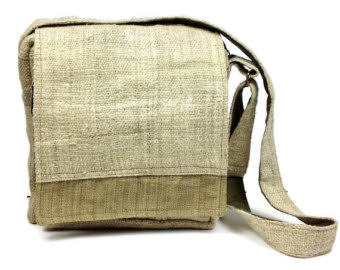 Bags and backpacks made from natural fibers, including hemp, nettle, cotton. Designs are “hippie.”
Bags and backpacks made from natural fibers, including hemp, nettle, cotton. Designs are “hippie.”
O1L23
I tried this oil for hair, skin and nails and it improved my hair with one drop. It’s made from three ancient oils—buckthorn, macula and baobab—each cold-pressed, wildcrafted, organic, non-GMO. Each bottle is hand blended by an organic hairdresser with over 30 years in the industry. This is very potent!
Hullo Pillow
 “A simple, natural pillow designed for comfort….From the 100% organic cotton twill pillow case, to the carefully sourced and selected buckwheat hulls, Hullo pillows are made in the U.S.A. with the finest materials available.” Larger than traditional buckwheat pillows. Easy to adjust fill levels.
“A simple, natural pillow designed for comfort….From the 100% organic cotton twill pillow case, to the carefully sourced and selected buckwheat hulls, Hullo pillows are made in the U.S.A. with the finest materials available.” Larger than traditional buckwheat pillows. Easy to adjust fill levels.
Mary’s Alpaca Poop
Compost tea “poop paks” made from alpaca manure “proven to be best organic fertilizer.” It’s clean, with no mess or smell, so it can be used indoors for houseplants as well as in the garden. It provides all the nutrients found in compost, including beneficial micro-organisms. Approved for organic farming by OMRI.
Big Spoon Roasters
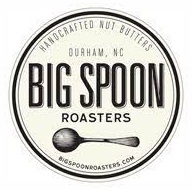 Handcrafted nut butters, made from scratch to order, all made with high quality ingredients. Their basic peanut butter, for example, is made from fresh-roasted peanuts, honey, sea salt, and a bit of organic coconut oil for a very smooth texture. But the really interesting thing is all the unique flavors and combinations. Hot Peanut contains chili peppers. Then there’s peanut cashew, peanut pecan, and peanut cocoa. Then almond cocoa, almond ginger, vanilla peanut sorghum (made with fresh vanilla beans) and more.
Handcrafted nut butters, made from scratch to order, all made with high quality ingredients. Their basic peanut butter, for example, is made from fresh-roasted peanuts, honey, sea salt, and a bit of organic coconut oil for a very smooth texture. But the really interesting thing is all the unique flavors and combinations. Hot Peanut contains chili peppers. Then there’s peanut cashew, peanut pecan, and peanut cocoa. Then almond cocoa, almond ginger, vanilla peanut sorghum (made with fresh vanilla beans) and more.
Review Of Cork Fabric aka Cork Leather
In the last few months I’ve suddenly started seeing many products made from “cork fabric” or “cork leather” and also “vegan leather.” I ignored this vegan leather for a while because in the past vegan leather often mean PVC vinyl, which is not a good substitute, but when I found out it was actually cork, I took a look at it.
You’ve probably seen cork in many consumer products such as wine stoppers and bulletin boards.
The cork used to make cork fabric is thin cork shavings obtained directly from the bark of the cork oak tree. These shavings are glued to a fabric backing to make a fabric that feels very much like leather, but is plant-based.
I called a manufacturer of cork fabric and asked them about the process of making it. The thin layer of cork is “laminated” to a fabric backing using an “environmentally-friendly” adhesive. The standard backing fabric is a polyester/cotton blend.
The company I talked with did not have much information about the laminating process for me to evaluate. This material is apparently made to a vegan standard and has some environmental benefit, but it doesn’t appear to be made with a nontoxic intent.
I have a sample of this fabric, sent from a retailer of products made from it. I just have a small swatch, but even that piece has enough odor to it that I can’t recommend it as being nontoxic. It smells like some kind of fabric finish. I actually had to take the swatch to my garbage can outdoors, and get it out of the house.
So if you see products made from this material, now you know what it is
Bao Cultured
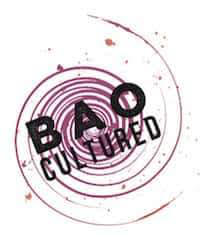 Fermented condiments—catsup, BBQ sauce, hot sauce, and pickles filled with probiotics. Also cultured vegetable slaws and relishes, and flavored kombucha. “Each bottle is packed full of organic ingredients and vibrant probiotic bacteria.”
Fermented condiments—catsup, BBQ sauce, hot sauce, and pickles filled with probiotics. Also cultured vegetable slaws and relishes, and flavored kombucha. “Each bottle is packed full of organic ingredients and vibrant probiotic bacteria.”
Salts of the 7 Seas
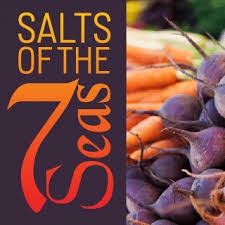 A whole website dedicated to the best of the basic seasonings salt and pepper. Unusual sea salts and blends plus peppercorns. Samplers allow you to learn about salts and peppercorns and choose your favorites. “Salts of the 7 Seas was founded to bring the beautiful and healthy world of whole mineral, all natural sea salts to people everywhere who love to cook and eat. Produced in exacting standards with attention to purity, wholesomeness and respect for the environment.”
A whole website dedicated to the best of the basic seasonings salt and pepper. Unusual sea salts and blends plus peppercorns. Samplers allow you to learn about salts and peppercorns and choose your favorites. “Salts of the 7 Seas was founded to bring the beautiful and healthy world of whole mineral, all natural sea salts to people everywhere who love to cook and eat. Produced in exacting standards with attention to purity, wholesomeness and respect for the environment.”
Leaves & Flowers
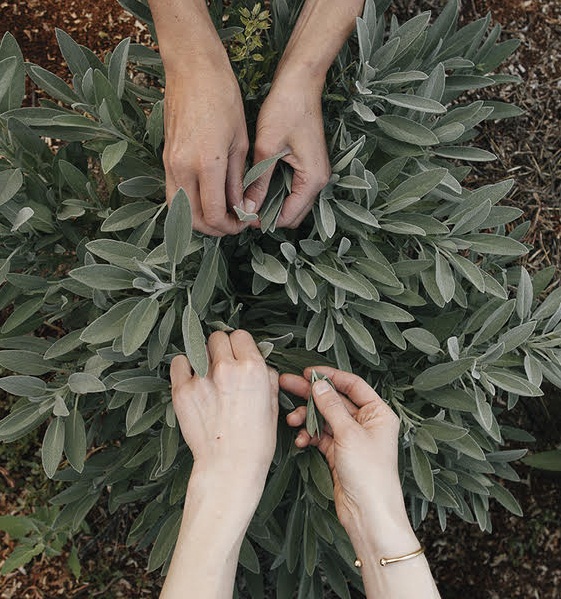 A beautiful and unique selection of handcrafted herbal infusions and premium small batch teas. “Our inspiration comes from the plants themselves – the mythology of their medicine, their potent leaves, delicate flowers, and the intoxicating aroma and flavor they release when infused. At its conception, Leaves and Flowers established a close community of local farms who provide us with exceptional herbs for our herbal infusions. Our accompanying tea collection is sourced similarly to our herbal ingredients, with an ever-changing selection procured from small tea farms in regions of China, Japan and Africa. These farms have been implementing sustainable farming practices for generations, and provide us with teas of extraordinary quality and flavor. We feel fortunate to collaborate with farmers who live in such close relationship with the land. Our farms are either certified organic or apply sustainable farming practices. No chemicals or pesticides are used in the cultivation of our herbs or teas.”
A beautiful and unique selection of handcrafted herbal infusions and premium small batch teas. “Our inspiration comes from the plants themselves – the mythology of their medicine, their potent leaves, delicate flowers, and the intoxicating aroma and flavor they release when infused. At its conception, Leaves and Flowers established a close community of local farms who provide us with exceptional herbs for our herbal infusions. Our accompanying tea collection is sourced similarly to our herbal ingredients, with an ever-changing selection procured from small tea farms in regions of China, Japan and Africa. These farms have been implementing sustainable farming practices for generations, and provide us with teas of extraordinary quality and flavor. We feel fortunate to collaborate with farmers who live in such close relationship with the land. Our farms are either certified organic or apply sustainable farming practices. No chemicals or pesticides are used in the cultivation of our herbs or teas.”
Wild Zora
 Snack bars made from 100% natural meats and organic vegetables that are minimally processed. “We make for you only real food that we give to our own children, family and friends.”
Snack bars made from 100% natural meats and organic vegetables that are minimally processed. “We make for you only real food that we give to our own children, family and friends.”
Ora Organic
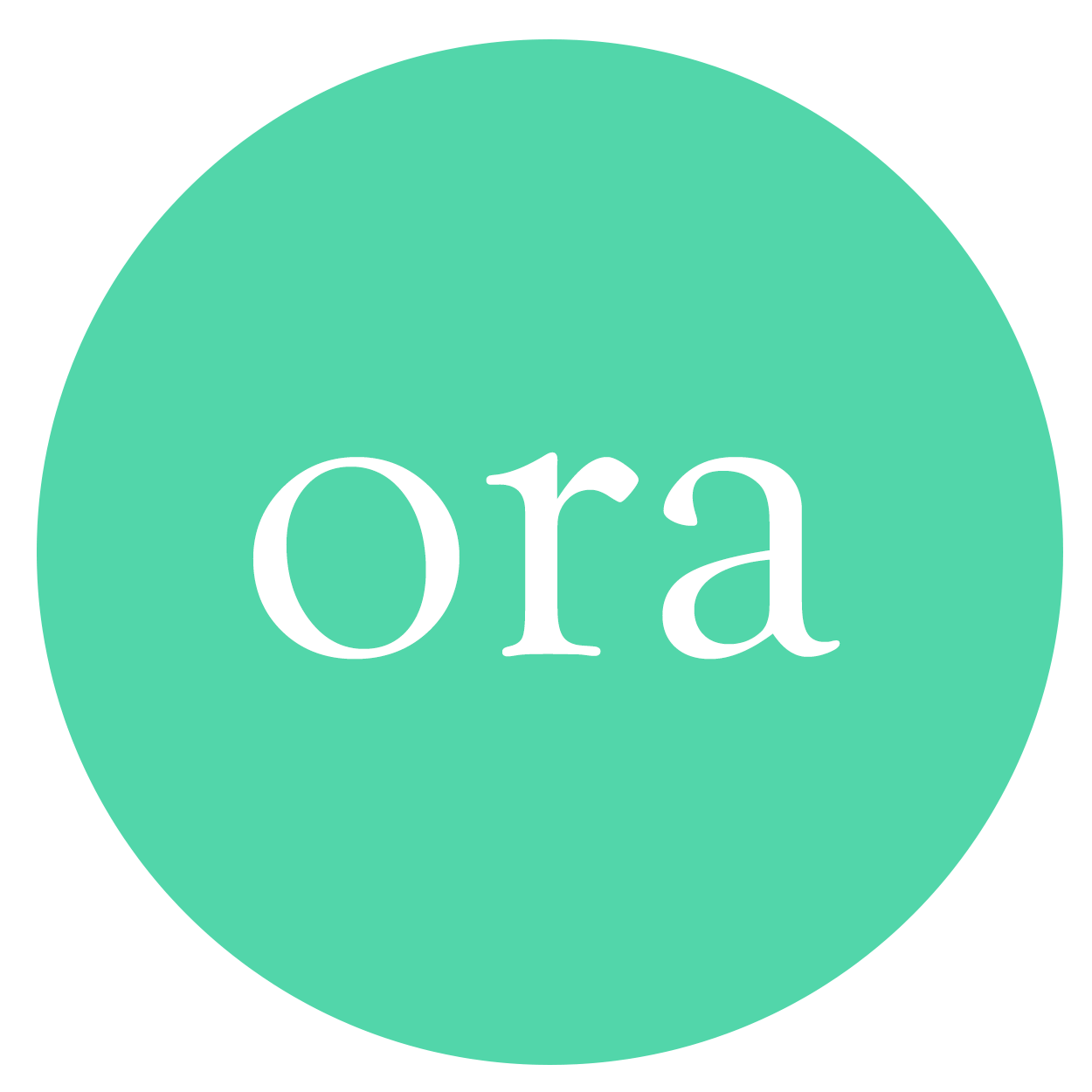 Plant-based supplements made from real whole organic food—and they are designed to taste great too. “We wanted to make the supplement experience enjoyable (not just tolerable), so we brought on an in-house Chef to make our products taste great. No more giant horse sized capsules or pinching your nose to down something that tastes like a handful of dirt and grass.” Just a small collection now of multivitamins, protein, probiotics and omega-3s, but I love the concept of supplements actually being foods that taste good! And they do! I’ve tried them.
Plant-based supplements made from real whole organic food—and they are designed to taste great too. “We wanted to make the supplement experience enjoyable (not just tolerable), so we brought on an in-house Chef to make our products taste great. No more giant horse sized capsules or pinching your nose to down something that tastes like a handful of dirt and grass.” Just a small collection now of multivitamins, protein, probiotics and omega-3s, but I love the concept of supplements actually being foods that taste good! And they do! I’ve tried them.
SaltRox
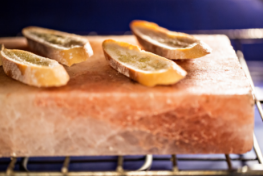 A pink Himalayan salt cooking plate, manufactured to the safe for cooking, grilling, and baking. This plate enhances and seasons your food with before and during the cooking process. No need for cookware—you heat the slab of salt and cook food directly on it.
A pink Himalayan salt cooking plate, manufactured to the safe for cooking, grilling, and baking. This plate enhances and seasons your food with before and during the cooking process. No need for cookware—you heat the slab of salt and cook food directly on it.
Curio Spice Co.
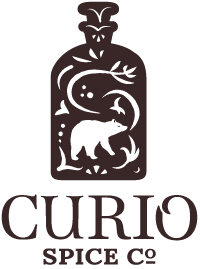 Organic spices and exotic spice blends from around the world and the USA. Spices are sourced direct from origin whenever possible, “with the highest standards in organic and fair trade agriculture. Sourcing from origin highlights the “terroir” of spices from specific regions (just like wine), adding edible luxury, creativity and intense flavor to food, cocktails and more. Simultaneously, Curio’s dedication to direct sourcing and the highest standards in sustainability allow for a premium product and improved farmer livelihoods.”
Organic spices and exotic spice blends from around the world and the USA. Spices are sourced direct from origin whenever possible, “with the highest standards in organic and fair trade agriculture. Sourcing from origin highlights the “terroir” of spices from specific regions (just like wine), adding edible luxury, creativity and intense flavor to food, cocktails and more. Simultaneously, Curio’s dedication to direct sourcing and the highest standards in sustainability allow for a premium product and improved farmer livelihoods.”
Millions of Children Around the World Breathe Highly Toxic Air
 The United Nations Children’s Fund (UNICEF) issued a report last week that shows more than 300 million children around the world are exposed to outdoor air pollution at least six times the level considered to be safe by the World Health Organization (WHO).
The United Nations Children’s Fund (UNICEF) issued a report last week that shows more than 300 million children around the world are exposed to outdoor air pollution at least six times the level considered to be safe by the World Health Organization (WHO).
Clear the Air for Children is a 100-page report that shows the sources of outdoor air pollution, the impact of air pollution on the health of children, the unique vulnerabilities of children, how to protect children from air pollution.
Though the greatest numbers of children affected by the worst air quality is in India, Asia and north Africa, these same pollutants are found in indoor and outdoor air here in the United States and affect our children’s health in the same ways. And our own health as well.
UNICEF: Clear the Air For Children
THE NEW YORK TIMES: 300 Million Children Breathe Highly Toxic Air, Unicef Reports

Satellite image of areas in the United State with excessive particulate pollution in outdoor air.
Air Pollution Affects the Stock Market…And Other Human Activities
According to a new study from researchers at the University of Ottawa and Columbia University, when outdoor air pollution levels rise in Manhattan, stock prices fall.
The study tracked the S&P 500 index, the most widely cited New York Stock Exchange benchmark, over a 15-year period and compared its returns with hourly measures of fine particulate matter in lower Manhattan, where the NYSE is based.
The one standard deviation increase in air pollution decreases returns by 11.9 percent, or what the researchers deemed a “substantial effect on daily NYSE returns.”
“We hypothesize that pollution decreases the risk attitudes of investors via short-term changes in brain and/or physical health.”
CBS MONEY WATCH: Why Investors May Want to Keep Tabs on Air Pollution
New Study Finds Air Pollution a Risk Even for Young Healthy Adults
In the past it was thought that children and elderly people were at greatest risk for heart disease, stroke, and high blood pressure.
But a new study suggests that even healthy people in their twenties are being harmed by particles found in air pollution.
In the new study, a group of 72 people with an average age of 23, from the city of Provo in Utah, provided blood samples during the winters of 2013, 2014 and 2015. When air pollution rose, the scientists found that the number of fragments of dead cells in their bloodstream increased.
One researcher said there appeared to be a significant effect on the health of young adults. “ These findings suggest that living in a polluted environment could promote the development of high blood pressure, heart disease, and stroke more pervasively and at an earlier stage than previously thought.”
“Although we have known for some time that air pollution can trigger heart attacks or strokes in susceptible, high-risk individuals, the finding that it could also affect even seemingly healthy individuals suggests that increased levels of air pollution are of concern to all of us, not just the sick or the elderly.”
INDEPENDENT: Air pollution damages arteries of even healthy young adults, new study shows
VOCs and Heavy Metals Found in Halloween Face Paints
 The Breast Cancer Fund has a new report on toxic chemicals in make-up marketed to kids, including make-up used for Halloween.
The Breast Cancer Fund has a new report on toxic chemicals in make-up marketed to kids, including make-up used for Halloween.
I know I’m a day late for this Halloween, but all this is good to know for next Halloween and any time of year that face painting comes to mind.
Pretty Scary 2 goes beyond looking a labels and had kid’s cosmetics lab tested.
Here are some of the chemicals they found:
Seven different VOCs were found, four having the potential to lead to serious long-term health care effects:
- Toluene, a reproductive toxicant
- Styrene, a probable carcinogen and endocrine disruption compound
- Ethylbenzene, a possible carcinogen
- Vinyl acetate, another possible carcinogen
In addition they found
- fragrances
- heavy metals lead, cadmium, arsenic, and chromium
- toluene
- parabens
- formaldehyde
- ethoxylated ingredients
This comprehensive report covers insufficient regulations, what you can find on the label and what thy cab’t, and much more.
After reading this I went searching for safe face paints. After reading some descriptions of so-called “nontoxic” and “natural” face paints I decided this needed more research before I could recommend them.
But I will give you a link to How To Make Face Paint With Natural Ingredients, which is what I would do for face paint.
Face painting is fun! Just use a safe face paint.
BREAST CANCER FUND: Pretty Scary 2
Microfibers From Washing Synthetic Clothing Polluting World Waterways
Microfibers from the washing of synthetic clothing are part of the larger problem of microplastic pollution in natural waterways. Much thinner than a strand of hair, these tiny pieces of plastic are shed by every garment made with synthetic materials when they are washed in a washing machine.
“I surveyed thousands and thousands of kilometers of ocean. We found microfibers in nearly 90 percent of the samples, and in every sample we found fibers, they were the majority of particles we identified,” said Amy Lusher, a British-based microplastics researcher and a co-author of a 2014 study of microplastic pollution in the Northeast Atlantic Ocean.
Does this affect the environment or our own personal health? Researchers are still trying to determine what effects might climb up the food chain and affect humans eating seafood and our drinking water.
Studies have found that a single synthetic garment can release from up to 700,00 microfibers each.
The solution? Researchers are working to develop a “microfiber catcher” that consumers will be able to throw into their washing machines, trapping the fibers inside the appliance rather than sending them out to sea in wastewater.
I suggest we all wear biodegradable natural fibers instead.
THE WASHINGTON POST: Are Synthetic Fleece and Other Types of Clothing Harming Our Water?
Verdant Kitchen
 Farm fresh USA-grown certified organic ginger and turmeric, in capsules and in a wide variety of other delightful food products that celebrate the properties and flavors of these spices. “These spices have been at the intersection of gourmet and wellness for millennia. At Verdant Kitchen, we use our deep knowledge and the finest ingredients from our own organic farm and around the world to unleash these spices and craft unique, delicious and healthful products.”
Farm fresh USA-grown certified organic ginger and turmeric, in capsules and in a wide variety of other delightful food products that celebrate the properties and flavors of these spices. “These spices have been at the intersection of gourmet and wellness for millennia. At Verdant Kitchen, we use our deep knowledge and the finest ingredients from our own organic farm and around the world to unleash these spices and craft unique, delicious and healthful products.”
[Note some food products may contain sugar, ingredients not listed on website (they will read them to you over the phone). I’m giving you this site for USA-grown ginger and turmeric—two spices/supplements that are usually grown in Asia.]
Meliora Cleaning Products
Basic household cleaners made from coconut soap and natural minerals. They are so transparent about their ingredients they even give you the recipes so you can make them yourself if you want to. Unscented and scented.
Date Me
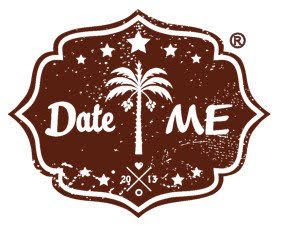 Premium date paste made from organic dates, with no additives. Plus a lot of recipes for using date paste. This is very expensive. You can make date paste at home.
Premium date paste made from organic dates, with no additives. Plus a lot of recipes for using date paste. This is very expensive. You can make date paste at home.
GoodLight Natural Candles
Clean-burning palm oil candles, unscented and scented candles. Throughout the site, these candlemakers have a lot of information about toxic exposures to candles and their decision to make candles out of sustainable palm oil. They have an mission to replace toxic candles in public places (like churches and restaurants) with clean-burning candles, as well has offering a wide variety of palm oil candles in many shapes and sizes for home use. I tried these candles and they burn extremely well. The unscented candles do not have a scent.
Flipside Hats
 Hats for women, men and children, handmade from repurposed pre-consumer waste natural fibers. “We source large rolls of abandoned fabrics from production and dye houses and re-love them into beautifully made hats…it makes us proud to be part of a growing movement of small businesses and organizations that divert 75% of pre-consumer waste—750,000 tons—from landfills and repurpose it into beautiful, functional products we use every day…We source our “waste” from production and dye houses, which is often discarded by big sports and athletic brands. Another 10% of our materials are sustainably sourced fabrics such as Hemp, Organic Cotton and Recycled water bottles.” My spot check turned up with mostly repurposed cotton and wool, only one had spandex. So look around and find the fabrics you like. I’m thinking that the selection of fabrics change all the time, but that customer service will be happy to help you find what you want.
Hats for women, men and children, handmade from repurposed pre-consumer waste natural fibers. “We source large rolls of abandoned fabrics from production and dye houses and re-love them into beautifully made hats…it makes us proud to be part of a growing movement of small businesses and organizations that divert 75% of pre-consumer waste—750,000 tons—from landfills and repurpose it into beautiful, functional products we use every day…We source our “waste” from production and dye houses, which is often discarded by big sports and athletic brands. Another 10% of our materials are sustainably sourced fabrics such as Hemp, Organic Cotton and Recycled water bottles.” My spot check turned up with mostly repurposed cotton and wool, only one had spandex. So look around and find the fabrics you like. I’m thinking that the selection of fabrics change all the time, but that customer service will be happy to help you find what you want.
Organic Candle Company
Aromatherapy and unscented candles made using only certified organic palm oil, organic coconut oil, organic beeswax, organic essential oils, and organic cotton wicks. “Each candle is handmade and our 100% cotton wicks are braided in our facility as well.”
Everything You Ever Might Need to Know About Glyphosate
 Pesticide Action Network (PAN) just released an almost 100-page report titled simply Glyphosate, which compiles information on the chemical, health impacts, human exposures, poisonings, environmental effects, and alternatives. If you have ever had questions about glyphosate, the answers are probably in this report. Bookmark this page, as it is the definitive work on glyphosate, which you may need to refer to at some time.
Pesticide Action Network (PAN) just released an almost 100-page report titled simply Glyphosate, which compiles information on the chemical, health impacts, human exposures, poisonings, environmental effects, and alternatives. If you have ever had questions about glyphosate, the answers are probably in this report. Bookmark this page, as it is the definitive work on glyphosate, which you may need to refer to at some time.
And if your questions aren’t answered in Glyphosate, there’s even more information in this article: ACTIVIST POST: Glyphosate Contaminates The Global Ecosystem: The Damning New PAN Report. This article explains in simple terms key points from the PAN report, plus gives links to many other articles on glyphosate, including a post from this very Q&A: Glyphosate Detox: How to Remove Roundup From Your Body
Pesticide Action Network (PAN) is a global network of over 600 participating nongovernmental organizations, institutions and individuals in over 90 countries working to replace the use of hazardous pesticides with ecologically sound and socially just alternatives such as agroeoclogy. PAN was founded in 1982 and has five independent, collaborating Regional Centers that implement its projects and campaigns.
New Study on Adverse Health Effects Of “Secondhand Scents” by Anne Steinemann
If you experience health effects from fragrances in common consumer products, you’re not alone.
Professor Anne Steinemann—a world expert on environmental pollutants, air quality and health effects—has found that more than one-third of Americans report health problems—from asthma attacks to migraine headaches—when exposed to common consumer products that contain fragrances, such as air fresheners, cleaning supplies, laundry products, scented candles, cologne, and personal care products.
The study also found that fragranced products may affect profits, with more than 20% of respondents entering a business, but leaving as quickly as possible if they smell air fresheners or some fragranced product. More than twice as many customers would choose hotels and airplanes without fragranced air than with fragranced air.
In the workplace, over 15% of the population lost workdays or a job due to fragranced product exposure. Over 50% of Americans surveyed would prefer fragrance-free workplaces. And over 50% would prefer that health care facilities and professionals were fragrance-free.
When exposed to fragrance products, 34.7% of Americans suffer adverse health effects, such as breathing difficulties, headaches, dizziness, rashes, congestion, seizures, nausea, and a range of other physical problems. For half of these individuals, effects are potentially disabling, as defined by the Americans with Disabilities Act.
“This is a huge problem; it’s an epidemic,” says Professor Steinemann.
Professor Steinemann is especially concerned with involuntary exposure to fragranced products, or what she calls “secondhand scents.”
MEDIA RELEASE: Fragranced Products: Risks for People and Profits?
FULL ARTICLE: Fragrance consumer products: exposures and effects from emissions
Toxic Shipping Containers Are Contaminating Imported Goods
“One out of five freight containers arriving in European ports [from Asia] has been fumigated with extremely dangerous, carcinogenic or neurotoxic gases.”
“These toxic gases are left over from the fumigation process, a necessary – sometimes mandatory – operation to kill micro-organisms and pests before transport, in order to prevent the introduction of parasites, bacteria and diseases into the importing country.
“In March 2010, the EU banned the use of methyl bromide, a dangerous pesticide — but many countries, including the U.S., still use it. What’s worse, very few countries actually indicate the presence of toxic gas on their containers, to avoid having to de-gas them.”
“Another more insidious source of toxicity, which puts port workers and consumers at risk, is the vapors emanating from the merchandise itself during transport. Furniture, shoes, clothes made in Asia – mostly Vietnam and China — frequently contain toluene and benzene solvents, which are carcinogen. When this is the case, there are no labels on the shipping container warning port workers to equip themselves against toxic fumes.
“97% of freight containers contained residues of pesticide fumigants and toxic industrial chemicals, mostly 1.2-dichloroethane and methyl bromide, as well as benzene and toluene. About 19% of them had levels exceeding the permitted exposure level. The German researchers told the congress that the fumigants and toxic products “contaminated the transported goods, penetrating into them and settling there.”
These are only a few of the facts reported in the article below. So now we know what some of the chemicals are on imported products and how toxic they are.
WORLDCRUNCH: Toxic Shipping Containers May Be Contaminating Your Food And Clothes
What About an Affordable Sofa Plus Air Filter?
Question from Joelle
Hi Debra,
thanks for all you do in helping families try to live as non-toxic and cleanly as possible!
I have read every single one of the Q&A’s regarding non-toxic, green, eco-friendly, sofas and I am still at a loss. I cannot afford the $5000 price tag for an organic sofa and to be honest, I do not like the looks of most of the options out there. This being said, here is my question and I would truly appreciate your input.
I am at the point where I would like to purchase the most non-toxic sofa that I can afford (Pottery Barn eco-friendly) and add [one of the room air purifiers]=(link to air filters page of Debra’s List) that you did a show on into the room. I used to have an “all or nothing” attitude about detoxing our home but the reality is that the budget will simply not allow for that and we need to get on with joyfully living!
Debra’s Answer
I think you’ve made the best decision that meets your needs.
I once had to make the decision to go work in a toxic office building, so I just took my air filter with me and put it on my desk.
It’s better that you make a less toxic choice that you can afford than make no improvement at all.
As a consumer advocate I have to give you the best choices I can and educate you about the options, and then it’s up to you to choose what is right for you. That’s why I often don’t recommend products that still have some toxic exposures that may be acceptable to some people in some circumstances.
I think you’ve done a great job at figuring this out for yourself.
The old sofa is on its last leg and its time for me to make a decision. Thanks for your help!
Flooring Over Radiant Heat
Question from Cheryl
Hi Debra,
I plan on building a home with radiant in-floor heat. What type of flooring will be safe for me with MCS?
Debra’s Answer
Well, this is a very easy question to answer because the best flooring for anyone to install over radiant heat is also the best flooring for MCS: porcelain, stone, or ceramic tile.
The radiant heat will increase the emissions of any toxic chemicals in other types of flooring, but porcelain, stone, and ceramic tile have no toxic emissions. And These materials are excellent conductors of heat (so they will collect heat and continue to release it after the radiant heating is turned off), do not expand and contract with heat, and are resistant to warping or cracking.
There may be some odor from the mortar, that should outgas quickly, and DO NOT USE GROUT SEALER. Grout sealer is very toxic.
Common Chemicals Cost Us Billions Every Year
Here’s a place we can cut the budget.
“Researchers estimate the United States economy takes a $340 billion hit annually as endocrine-disrupting compounds lower IQs, increase behavior problems and exacerbate health woes like obesity and diabetes.”
And that’s only endocrine disruptors.
According to a new analysis, exposure to chemicals in pesticides, toys, makeup, food packaging and detergents costs the U.S. more than $340 billion annually due to health care costs and lost wages.
“My prediction is that the calculated costs to society will increase substantially once we get better documentation on … additional substances and additional adverse effects.”
—Philippe Grandjean, Harvard University
ENVIRONMENTAL HEALTH NEWS: Toxic Economy: Common Chemicals Cost US Billions Every Year
ButterBuzz
 If you like “bulletproof” type coffee, but don’t like all the bags and jars of different ingredients, ButterBuzz is perfect for you. “Each BuzzPod is packed full of ingredients that are proven to have a variety of health benefits including boosting metabolism, aiding in weight loss and management, improving cognitive brain function, and supporting your hormonal system.” Each pod contains grass fed butter, raw unfiltered honey, raw vanilla powder, raw cacao butter, ground Ceylon cinnamon, cocoa butter—all organic—and hydrolyzed marine collagen.
If you like “bulletproof” type coffee, but don’t like all the bags and jars of different ingredients, ButterBuzz is perfect for you. “Each BuzzPod is packed full of ingredients that are proven to have a variety of health benefits including boosting metabolism, aiding in weight loss and management, improving cognitive brain function, and supporting your hormonal system.” Each pod contains grass fed butter, raw unfiltered honey, raw vanilla powder, raw cacao butter, ground Ceylon cinnamon, cocoa butter—all organic—and hydrolyzed marine collagen.
Nerfertem Naturals
Soaps and body butters made by hand with organic vegetable oils and triple-purified beef tallow from grass-fed pasture-raised cows care for on a small family farm. Pure herbal colorants: turmeric root, annatto seed, French green clay, and others. 100% pure, therapeutic-grade, organic essential oils. I tried this soap and love it. It’s very clean on my skin and the scents are very pure. The mint soap really wakes me up in the morning!
Banner Butter
![]() This small-batch butter is made with “patiently-cultured cream from hormone-free, grass-fed cows with no added flavoring. We go big, but only in taste. Everything else is small, simple and slow.” Salted with sea salt, lightly salted, unsalted, or flavored with combinations like balsamic fig with caramelized onion.
This small-batch butter is made with “patiently-cultured cream from hormone-free, grass-fed cows with no added flavoring. We go big, but only in taste. Everything else is small, simple and slow.” Salted with sea salt, lightly salted, unsalted, or flavored with combinations like balsamic fig with caramelized onion.
Phat Fudge
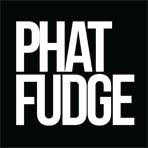 An all-organic fudge made from grass-fed butter, tahini, cacao, ground coffee, turmeric, cinnamon, sea salt, maca, raw honey, vanilla, and cayenne.
An all-organic fudge made from grass-fed butter, tahini, cacao, ground coffee, turmeric, cinnamon, sea salt, maca, raw honey, vanilla, and cayenne.
Wholesome Linen
line of sleep essentials for infants and toddlers made from organic linen fabrics and raw flax fibers. Selection includes a toddler car seat liner. “Our products are soft, hypo-allergenic, machine washable and long lasting. We make them with100% organic raw flax fibers, without adding any dyes or bleaches. We source our flax from certified organic farms in Europe where it has been grown the same way for generations. We turn it into high quality essential sleep products that we deliver to you from Denver, Colorado.”
Modify Furniture
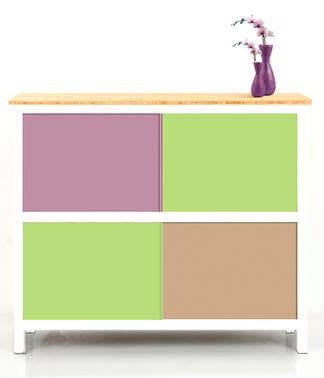 Simple, modern, and colorful, this furniture is designed to change as your needs change. You pick your frame style and color then front and back panel colors, and accessories, At any time you can change your colored panels for new colors! Made from rapidly renewable bamboo, recycled content aluminum, organic powder coating and low VOC finishes.
Simple, modern, and colorful, this furniture is designed to change as your needs change. You pick your frame style and color then front and back panel colors, and accessories, At any time you can change your colored panels for new colors! Made from rapidly renewable bamboo, recycled content aluminum, organic powder coating and low VOC finishes.
Are Flannel Sheets Free of Hazardous Chemicals?
Question from Steve
Hi Debra,
I came across some of you posts and writings as I was searching for bedsheets. I would like to know if all flannel sheets are free from hazardous chemicals. Is it safe to buy flannel sheets that are not organic? Must they state that they are free from chemicals on packaging or are all flannel sheets safe because/if they are not treated to be wrinkle free, easy care, etc? I greatly appreciate your advice.
Thanks,
Steve.
Debra’s Answer
All flannel sheets are “safe” in the sense that they
- have no harmful finishes (they are naturally wrinkle-free because of the weave”)
- pesticides are removed as a by-product of processing in raw cotton into fabric
- dyes are “color-fast,” which means they stay in the fabric
Organic flannel sheets would be even better, though the benefit is more environmental.
I myself sleep on non-organic flannel sheets and have for years.
The only problem I’ve ever had is sometimes they use plastic printing for certain designs. Otherwise, a quick tumble in the washer and dryer and I’m always happy with them.
Latex Wood Slat Bedframe Strips—10 Years Later
Today Larry is working on removing the latex strips that we glued to the slats on our wood bed frame about ten years ago.
It sounded like a good idea at the time: latex strips just on the slats, which would give extra cushioning and still allow the natural wool mattress to breathe. I don’t like the odor of latex, so I didn’t want a whole mattress.
I did have to endure the outgassing of the latex for some weeks, but then it was tolerable and comfortable.
But about a year or two ago I started noticing a lot of dust and bits of latex under the bed. The latex was disintegrating!
This has gotten to be such a problem that Larry has taken the entire bed apart this morning and is pulling the latex strips off the slats. It is creating so much dust he had to bring in the shop vac because our little household Miele couldn’t handle the amount of dust that is being created.
I don’t know if this is a problem for pillows and mattresses, but it is a problem for our two-inch square strips. They just dried out. Maybe they were dehydrated by six months of air conditioning. I don’t know. I just know that it became such a mess we had to remove them.
Peg and Awl
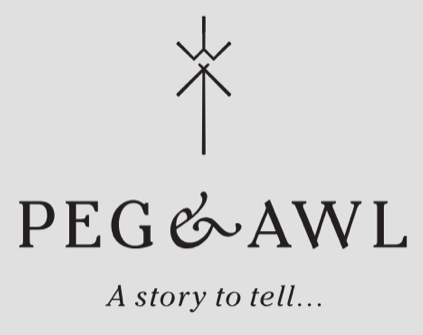 “Useful objects for the home” made from reclaimed wood, leather, and natural fiber fabrics. “To make our wares, we gather materials from flea markets and old shoppes, abandoned houses and torn-down buildings, construction sites, yard sales, and dirty basements. Most of what we use—leather from baseball gloves and drawing-room chairs, and WWII gun slings, pages from outdated medical texts and antique seed catalogs, misplaced photographs of people long dead, fabric from bedding, aprons, window covering—is more than a century old. Every item bears marks of a not-fully-known and not-quite-finished past” While they do not add any toxic materials when making their wares, note that some of their materials may have origins unknown, so proceed with caution and ask questions.
“Useful objects for the home” made from reclaimed wood, leather, and natural fiber fabrics. “To make our wares, we gather materials from flea markets and old shoppes, abandoned houses and torn-down buildings, construction sites, yard sales, and dirty basements. Most of what we use—leather from baseball gloves and drawing-room chairs, and WWII gun slings, pages from outdated medical texts and antique seed catalogs, misplaced photographs of people long dead, fabric from bedding, aprons, window covering—is more than a century old. Every item bears marks of a not-fully-known and not-quite-finished past” While they do not add any toxic materials when making their wares, note that some of their materials may have origins unknown, so proceed with caution and ask questions.
Fair Isle
 Mostly farm-to-table pantry items (plus botanical skin care and wellness products, all jumbled on one page). “All made by hand 30 miles out sea on the island of Nantucket. Together with my love and Iley’s papa, Jacob, we grow and wild-harvest many of the ingredients used in our culinary provisions, teas and herbs as well as our Vital healing botanical apothecary. If we can’t grow or find something locally we then source from organic sustainable suppliers. Products are made in small batches, often to order, and are packaged in recycled glass jars and bottles with environmentally friendly labels printed in the US.” I’m thinking the selection will change based on available ingredients, so just take a look and see what’s seasonal.
Mostly farm-to-table pantry items (plus botanical skin care and wellness products, all jumbled on one page). “All made by hand 30 miles out sea on the island of Nantucket. Together with my love and Iley’s papa, Jacob, we grow and wild-harvest many of the ingredients used in our culinary provisions, teas and herbs as well as our Vital healing botanical apothecary. If we can’t grow or find something locally we then source from organic sustainable suppliers. Products are made in small batches, often to order, and are packaged in recycled glass jars and bottles with environmentally friendly labels printed in the US.” I’m thinking the selection will change based on available ingredients, so just take a look and see what’s seasonal.
Watch the Movie STINK! Free for the Month of OCTOBER
STINK! opens with a foul smell and a pair of kids pajamas. And a single father trying to find out what that smell could possibly be. But instead of getting a straight answer, director Jon Whelan stumbles on an even bigger issue in America, which is that some products on our store shelves are not safe — by design.
Stink! tells us about our exposures to toxic chemicals from consumer products and lack of regulations through the eyes of a father who has lost his wife to cancer. He buys pajamas for Christmas presents for his two tween daughters and is appalled by the overwhelming odor.
Stink! takes us through his journey to find out what’s in the pajamas that causes the odor, shows the world of undisclosed “fragrance” chemicals, and even includes a a teenage boy who cannot attend high school because he goes into anaphylactic shock when he breathes a certain body spray used by many of his classmates.
There’s a lot of good information about toxics in this film that shows the problem. It’s well worth watching and a good movie to show others, so they can get an idea of the problem.
[Just as an aside I want to say that this film is full of interviews with people who are working to change the chemical industry and lack of regulation. One of them shown over and over is Jeffrey Hollander, founder of Seventh Generation, who just sold Seventh Generation to Unilever, manufacturer of the product that won’t disclose the chemicals in the body spray product that sends the teenage boy into life-threatening anaphylactic shock. This is the company that is now manufacturing the Seventh Generation brand.]
At the end of the film, the solution presented is
- manufacturers need to disclose their ingredients and
- there needs to be better regulation. And the closing scene is his daughter calling an online business that is offering “flame-proof” pajamas, asking them if the pajamas contain flame retardants.
What this movie is missing is any mention at all that there ARE toxic-free products available.
A big message of this movie is that we can’t make decisions as consumers unless the big corporations disclose the ingredients of their toxic products. Well, I would like to see that happen too, however, it’s not a prerequisite for us to determine the products are toxic or for us to have the power to identify, find, choose and purchase toxic-free products.
My concern about the film is that it leaves the viewer with the idea that the world is 100% toxic, and there are no safe alternatives. That may be the filmmaker’s world, but I know that’s not true.
So if you see this film and share it, tell everyone to come to my website after to find out how to live toxic free.
Watch STINK! Free for the Month of October
Bunny Power Products
Rabbit manure tea, “That will help your gardens flourish…produced at our family run farm in a healthy, sustainable setting”.
Breathe Sleepwear
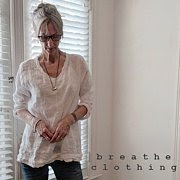 Surround yourself with linen while you sleep with linen sleepwear for women and men made by a small clothing design studio in the USA. “Artfully designed, impeccably crafted linen sleepwear….not mass produced, but made one at a time for each customer…carefully created from the initial design, pattern making, through the meticulous construction process, using only exceptional quality linens and other natural materials…not meant to be seasonal or trendy & my customers understand that they are making an investment. My hope is that these garments will become a staple in your wardrobe for years to come. I believe you will love your Breathe Clothing.”
Surround yourself with linen while you sleep with linen sleepwear for women and men made by a small clothing design studio in the USA. “Artfully designed, impeccably crafted linen sleepwear….not mass produced, but made one at a time for each customer…carefully created from the initial design, pattern making, through the meticulous construction process, using only exceptional quality linens and other natural materials…not meant to be seasonal or trendy & my customers understand that they are making an investment. My hope is that these garments will become a staple in your wardrobe for years to come. I believe you will love your Breathe Clothing.”
Kinderfeet
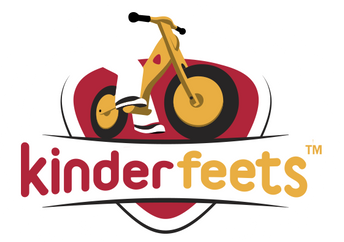 A wooden push “balance bike” to ease the transition to pedal-powered bicycle at a toddler’s comfort level. Designed by a Dutch father as a gift to his son, “Our balance bikes are made from sustainable birch wood, from a replenishable source. The airless tires are completely biodegradable. We use minimal packaging material made from recycled paper and water based-ink. The chalkboard finish paint is water-based and the lacquer is non-toxic.” Also push bikes made from bamboo wood.
A wooden push “balance bike” to ease the transition to pedal-powered bicycle at a toddler’s comfort level. Designed by a Dutch father as a gift to his son, “Our balance bikes are made from sustainable birch wood, from a replenishable source. The airless tires are completely biodegradable. We use minimal packaging material made from recycled paper and water based-ink. The chalkboard finish paint is water-based and the lacquer is non-toxic.” Also push bikes made from bamboo wood.
Luvnest
Herb blends for use in chick and chicken bedding to support health. “Our products use 100% USDA Certified Organic herbs, are preservative and additive free – and are completely natural and edible.”
Touch Of Eco
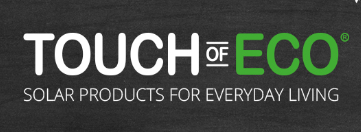 Useful and affordable products that run on solar power, such as individual lights, strings of lights, cell phone recharger, flashlights, and much more.
Useful and affordable products that run on solar power, such as individual lights, strings of lights, cell phone recharger, flashlights, and much more.
Northwest Wild Foods
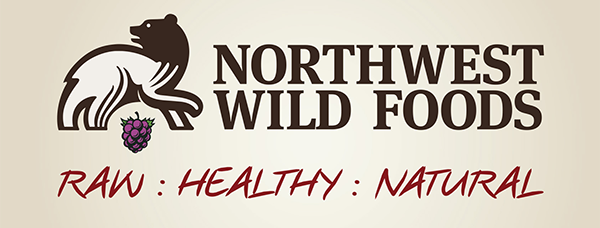 A small, family-owned company that is dedicated to offering the “rare and natural wild flavors” of the Pacific Northwest. Both raw foods and prepared into various food products. “Our wild berries are hand-gathered in the lush woodlands of the Cascade and Olympic Mountains where our intrepid pickers often find themselves competing with Black bear, cougar and other native animals for the sweet, juicy berries. Perhaps our favorite wild berry is tiny Wild Mountain Blackberry that our family has been collecting for more than three generations….” Supplies are limited by necessity.
A small, family-owned company that is dedicated to offering the “rare and natural wild flavors” of the Pacific Northwest. Both raw foods and prepared into various food products. “Our wild berries are hand-gathered in the lush woodlands of the Cascade and Olympic Mountains where our intrepid pickers often find themselves competing with Black bear, cougar and other native animals for the sweet, juicy berries. Perhaps our favorite wild berry is tiny Wild Mountain Blackberry that our family has been collecting for more than three generations….” Supplies are limited by necessity.
Project TENDR Takes on Risks of Neurotoxins
Project TENDR is a collaboration of leading scientists, health professionals and children’s and environmental advocates who came together in 2015 out of concern over the now substantial scientific evidence linking toxic environmental chemicals to neurodevelopment disorders.
These disorders include autism spectrum disorder, attention deficits, hyperactivity, intellectual disability and learning disorders.
In July, Project TENDR is releasing a scientific Consensus Statement as a national Call To Action to significantly reduce exposures to chemicals and pollutants that are contributing to neurodevelopmental disorders in America’s children.
The “prime examples” of neurotoxic chemicals listed in the Statement are
• Organophosphate (OP) pesticides
• PBDE flame retardants
• Combustion-related air pollutants, which generally include PAHs, nitrogen dioxide and particulate matter, and other air pollutants for which nitrogen dioxide and particulate matter are markers
• Lead
• Mercury
• PCBs
Check their Chemicals & Pollutants tab on the main menu for more information about how these chemicals can affect children’s development.
Everyday Toxic Chemicals That Interfere With Fertility
If you’re trying to get pregnant, here are two resources to read.
One from Rodale Wellness and one I wrote when I was invited to speak at a summit on infertility
RODALE WELLNESS: 9 Everyday Chemicals That Could Be Screwing with Your Fertility
DEBRA LYNN DADD: Protect Your Baby From Toxics Before Birth
How to find Mint-Free Toothpaste
Question from Rose
Hi Debra,
Can you recommend a toothpaste without mint, which is similar to Sensodyne in being: less abrasive/easy on sensitive teeth/ and generally helpful in preventing erosion?
I like Tom’s toothpaste, but the dental tech recommended Sensodyne.
I am allergic to processed Mint, alas.
I checked out Merz Apothecary here in Chicago, but all of the tooth pastes have mint.
Thank you.
Ciao’
Rose
Debra’s Answer
There are actually a number of toothpastes that don’t contain mint. They either have no flavoring, or flavors such as lemon or anise or simply the flavors of active ingredients.
See the Dental Care page of Debra’s List.
Readers, what mint-free toothpastes do you like?
Are Menstrual Cups Safe To Use?
Question from Leslie
Hi Debra,
Have you seen the study that claims the Diva Cup menstrual cup can cause endometriosis? I want to use one but obviously after reading that study I’m very conflicted. It claims that since the blood is not absorbed it can funnel back up to the ovaries and cling to them. If I understood correctly.
This is the report I read. http://assocpharmtox.org/pages/CupsIntro3.html
Thanks
Debra’s Answer
The study you read is ten years old.
There is more recent information.
Menstrual Cups and Endometriosis gives a good review of the dilemma. Basically, there is no longer a concern that menstrual cups are a cause of endometriosis. This website lists all the companies that now make menstrual cups, but they also have resources for cloth pads and organic pads and tampons. So it’s basically a good site for considering all your natural options.
The Endometriosis Foundation has no obvious warnings about not using menstrual cups that I could find on their website.
Menstrual cups are made from either rubber or medical-grade silicone. Both these materials are unlikely to cause harm for this use.
So if you want to use a menstrual cup, I see no reason not to.
Kalon Studios
 Simple sustainable furniture made from domestic hardwoods, organic cotton and wool, latex from organic trees, and other natural and nontoxic materials. “Based in Los Angeles, California and in Germany, Kalon Studios is a design studio focused on contemporary form with a particular aesthetic of simple, subtle and unobtrusive beauty. Kalon Studios’ design focus is as much on quality of design as it is on material, method and process. All of our products are non-toxic, fully sustainable, and domestically produced respectively in the in the US and in Europe. Each piece is handcrafted to order by traditional furniture makers. The ancient Greek concept of ‘kalon’ meant beauty linked with moral worth and usefulness, a value we seek to express in our designs.” Oh,, I love this! “Materials + Methods” is the first item on the main menu.
Simple sustainable furniture made from domestic hardwoods, organic cotton and wool, latex from organic trees, and other natural and nontoxic materials. “Based in Los Angeles, California and in Germany, Kalon Studios is a design studio focused on contemporary form with a particular aesthetic of simple, subtle and unobtrusive beauty. Kalon Studios’ design focus is as much on quality of design as it is on material, method and process. All of our products are non-toxic, fully sustainable, and domestically produced respectively in the in the US and in Europe. Each piece is handcrafted to order by traditional furniture makers. The ancient Greek concept of ‘kalon’ meant beauty linked with moral worth and usefulness, a value we seek to express in our designs.” Oh,, I love this! “Materials + Methods” is the first item on the main menu.
JADETribe
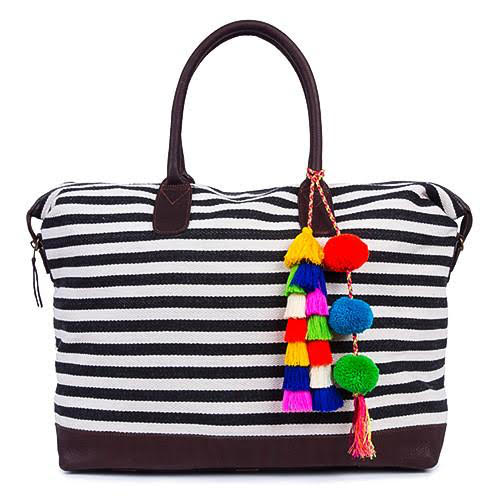 Delightful 100% natural fiber bags, totes, weekender bags and more. “Captivated by the colors of the natural organic dyes coupled with their incredible weaving skills and the remarkable textiles these women were creating, Kimberly employed this village to create exclusive colors and patterns that became the foundation of the JADEtribe handbag collection. A little bit beach-y, a little bit bohemian jet set, and 100 percent natural and ethical, JADEtribe is the true embodiment of fashion with a conscience. Whether it’s the handbag repurposed from hand embroidered baby carrier cloths, or the hand braided jewelry that jingles, or the organically dyed and hand loomed traditional textiles, each element of JADEtribe carries in it a piece of Kimberly’s heart and a piece of the hearts of the women in South East Asia whose lives have been improved by making it.” Also ready-to-wear clothing.
Delightful 100% natural fiber bags, totes, weekender bags and more. “Captivated by the colors of the natural organic dyes coupled with their incredible weaving skills and the remarkable textiles these women were creating, Kimberly employed this village to create exclusive colors and patterns that became the foundation of the JADEtribe handbag collection. A little bit beach-y, a little bit bohemian jet set, and 100 percent natural and ethical, JADEtribe is the true embodiment of fashion with a conscience. Whether it’s the handbag repurposed from hand embroidered baby carrier cloths, or the hand braided jewelry that jingles, or the organically dyed and hand loomed traditional textiles, each element of JADEtribe carries in it a piece of Kimberly’s heart and a piece of the hearts of the women in South East Asia whose lives have been improved by making it.” Also ready-to-wear clothing.
Wild Hill Botanicals
A skincare line based on the southwest coast of Vancouver Island, Canada. “Our connection to this landscape and our ongoing study of the amazing botanicals it has to offer has been the inspiration for our formulations. We believe that organic is just plain better. Organic ingredients have been shown to be higher in antioxidants, essential fatty acids, vitamins, and minerals. Wild plants are known to contain many molecules not present in their domesticated cousins. This core value of bringing together organic and sustainably harvested wild ingredients serves not only your skin, but also the greater environment, which we take very much to heart. We focus on growing organic herbs on our farm in East Sooke, using the freshest organic oils and house made hydrosols to craft products that are amazing, completely natural and inspired by the landscape of this beautiful coast. We take pride at Wild Hill in creating each of our products in small batches by hand to ensure freshness and quality control. We think that skincare and bath rituals should be a gratifying and important part of self-care in everyone’s day. Love yourself, take some downtime from this hectic world, and absorb the power of nature.”
Farm Fresh Clothing
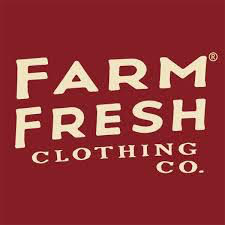 Organic cotton t-shirts for men, women and children, sewn and printed in the state of California, printed by hand with water-based inks. Will do custom printing with your art (minimum 150 shirts).
Organic cotton t-shirts for men, women and children, sewn and printed in the state of California, printed by hand with water-based inks. Will do custom printing with your art (minimum 150 shirts).
Blue Mountain Organics
 A great selection of organic raw and sprouted foods that are hard to find other places. Here you can buy nuts already soaked and sprouted, raw sprouted nut butters, spouted nut, bean and seed flours, raw treats, superfoods, and more. Every product is organic.
A great selection of organic raw and sprouted foods that are hard to find other places. Here you can buy nuts already soaked and sprouted, raw sprouted nut butters, spouted nut, bean and seed flours, raw treats, superfoods, and more. Every product is organic.
The Healthy Porcupine
All natural, handmade tallow-based soaps that are free of palm oil.
“We do not use chemical fragrance oils, dyes, or preservatives. We also use locally sourced ingredients whenever possible- all tallow that is used is from grass-fed cows and comes from local New Hampshire farms. Our soaps are long-lasting hard bars, with a luxurious lather that leaves your skin feeling soft and rinses off clean. We truly believe you’ve never used anything like it!”
Roots Wrap
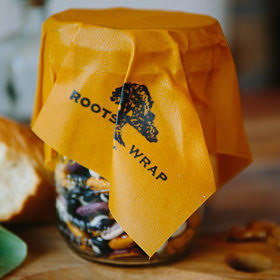 A great alternative to plastic wrap for food storage. It is an easy way to do something good for the planet and your food! Our wraps are made right here in beautiful Maui from organic cotton hemp muslin, organic beeswax, organic jojoba oil, and tree resin. The antibacterial properties of the beeswax, hemp, and jojoba oil help to keep food fresh and allow you to use your Roots Wrap over and over.” Click on the menu item “sustainable way” to read all about their sustainable practices.
A great alternative to plastic wrap for food storage. It is an easy way to do something good for the planet and your food! Our wraps are made right here in beautiful Maui from organic cotton hemp muslin, organic beeswax, organic jojoba oil, and tree resin. The antibacterial properties of the beeswax, hemp, and jojoba oil help to keep food fresh and allow you to use your Roots Wrap over and over.” Click on the menu item “sustainable way” to read all about their sustainable practices.
Simply Straws
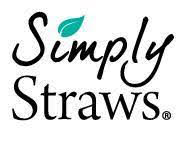 Glass straws in various sizes and shapes plus…you can have them etched with your name (or anything else) or buy them in a set with mason jars with special lids that hold the straws (great for taking drinks on the go).
Glass straws in various sizes and shapes plus…you can have them etched with your name (or anything else) or buy them in a set with mason jars with special lids that hold the straws (great for taking drinks on the go).
Is Your Tap Water Tainted With Carcinogenic Chromium-6?
 Environmental Working Group (EWG) released another report last week on our exposures to toxic chemicals in everyday life.
Environmental Working Group (EWG) released another report last week on our exposures to toxic chemicals in everyday life.
If you remember the true-story movie Erin Brockovich from 2000, chromium-6 was the chemical discovered to cause numerous cancer cases in the town of Hinkley, California. Now EWG has tested samples of tap water across the nation and found this same chromium-6 in 75% of water supplies in America.
According to EWG, “In 2008, a two-year study by the National Toxicology Program found that drinking water with chromium-6, or hexavalent chromium, caused cancer in laboratory rats and mice. Based on this and other animal studies, in 2010, scientists at the California Office of Environmental Health Hazard Assessment concluded that ingestion of tiny amounts of chromium-6 can cause cancer in people, a conclusion affirmed by state scientists in New Jersey and North Carolina.”
In 2010, an EWG investigation found chromium-6 in the tap water of 31 cities. This prompted the EPA to order local water utilities to begin the first nationwide tests. From 2013-2015 more than 60,000 samples of drinking water were taken. EWG’s analysis of the test data estimates that water supplies serving 218 million Americans – more than two-thirds of the population – contain more chromium-6 than the California scientists deemed safe.
EWG: ‘Erin Brockovich’ Carcinogen in Tap Water of More Than 200 Million Americans
EWG: ‘Erin Brockovich’ Carcinogen in Tap Water of More Than 200 Million Americans – The Study
Are You One of the 218 million?
EWG has provided an interactive map of the USA,where you can click on the county you live in and find out if you have chromium-6 in your water.
I checked Pinellas County, Florida—where I live—and found that chromium-6 was detected in 87% of samples tested.The range was from “none detected” to 0.620 parts per billion (ppb). The California Public Health Goal is 0.02 ppb.
What to Do
So, OK, I have my local numbers from the interactive map, but, is the water from MY tap “none detected” or 0.620 pub or somewhere in between?
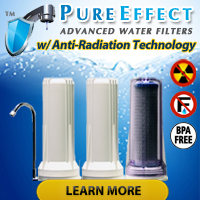 Since I have a PureEffect Water Filter, I asked founder Igor Milevskiy if I needed to be concerned about chromium-6 in my water.
Since I have a PureEffect Water Filter, I asked founder Igor Milevskiy if I needed to be concerned about chromium-6 in my water.
Igor said, “Due to varying water chemistry from place to place, and the heightened concern for Cr6 across a wide span of water supplies, we highly recommend to test your specific water at home with inexpensive and very simple to use test strips. This way you will know for yourself how much Chromium (if any) is in your water and how well the filter is performing on this contaminant.”
He recommends Waterworks Chromium test strips.
PureEffect water filters contains the type of filter media that removes chromium. “Our 3 and 4 chamber systems have 3 different types of metal removal media, which also target Chromium. The principles of the media are such, that they should have a good effect on reducing this contaminant.”
Again, test strips.
Igor said, “In the event it becomes necessary to provide even greater Cr6 removal power, if your readers let us know their test results, we can make a custom cartridge for those with extra stubborn situations.”
Seeing this report again reinforces for me the need for every home to have an effective water filter system that removes a broad spectrum of pollutants. You never know what might be in your water.
Butcher Box
 100% grass-fed beef, organic chicken and Heritage Breed pork delivered directly to your door for about $6 per serving. Your order arrives in cooler with a note from the butcher describing the cuts of meat and the farms that raised them. I have to say, I ordered a box and the quality of the meat was way above and beyond what I can buy at my local natural food stores or butchers. It’s the best-tasting meat I’ve ever eaten. Really. Just delicious. I’m going to continue to order from them. You buy a box on a subscription basis (1, 2 or 3 month delivery). Choose the all-beef box, or beef in various combinations with pork and chicken. You can also add on extras like sugar-free Paleo bacon, burgers, and ground beef, and change your order any time. “The beef is sourced from a collection of small grass-fed farms. It’s of the utmost quality and tastes incredible. The taste is attributed to our special ButcherBox blend of grasses.”
100% grass-fed beef, organic chicken and Heritage Breed pork delivered directly to your door for about $6 per serving. Your order arrives in cooler with a note from the butcher describing the cuts of meat and the farms that raised them. I have to say, I ordered a box and the quality of the meat was way above and beyond what I can buy at my local natural food stores or butchers. It’s the best-tasting meat I’ve ever eaten. Really. Just delicious. I’m going to continue to order from them. You buy a box on a subscription basis (1, 2 or 3 month delivery). Choose the all-beef box, or beef in various combinations with pork and chicken. You can also add on extras like sugar-free Paleo bacon, burgers, and ground beef, and change your order any time. “The beef is sourced from a collection of small grass-fed farms. It’s of the utmost quality and tastes incredible. The taste is attributed to our special ButcherBox blend of grasses.”
Beans72
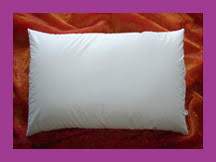 “Rolls Royce quality” authentic handcrafted Japanese buckwheat hull pillows. Filled with 100% natural triple air cleaned USDA Organic buckwheat hulls. 100% unbleached cotton cover. Fits in a standard pillowcase. Also body pillows filled with buckwheat hulls, buckwheat lumbar support and bolster pillows, and dried organic lavender to add to your pillow to aid sleep. All pillows come with zippers so additional buckwheat hulls can be added when needed. “The materials, dimensions, calculations and workmanship are a result of a lifetime accumulation of knowledge and pillow making experience.”
“Rolls Royce quality” authentic handcrafted Japanese buckwheat hull pillows. Filled with 100% natural triple air cleaned USDA Organic buckwheat hulls. 100% unbleached cotton cover. Fits in a standard pillowcase. Also body pillows filled with buckwheat hulls, buckwheat lumbar support and bolster pillows, and dried organic lavender to add to your pillow to aid sleep. All pillows come with zippers so additional buckwheat hulls can be added when needed. “The materials, dimensions, calculations and workmanship are a result of a lifetime accumulation of knowledge and pillow making experience.”
Beans72 Herringbone Buckwheat Bears
 Teddy bears made with 100% cotton cover, filled with 100% natural triple air cleaned USDA Organic buckwheat hulls or a buckwheat and dried organic lavender mix. (Adorable lavender-filled sachet bears with lavender-colored covers also available).
Teddy bears made with 100% cotton cover, filled with 100% natural triple air cleaned USDA Organic buckwheat hulls or a buckwheat and dried organic lavender mix. (Adorable lavender-filled sachet bears with lavender-colored covers also available).
Pompeii Organics
More than 70 USDA certified organic essential oils and carriers. “We are a small company in central Pennsylvania that meticulously sources Certified Organic, unsprayed, and wildcrafted essential oils, carriers, infused oils, and hydrosols. In 2015, we completed the USDA Organic Certification process. We offer over 60 Certified Organic essential oils, hydrosols, and carriers. We source Certified Organic products whenever possible. You will see that many of our oils are unsprayed or wildcrafted. Because it is important to source the oils from their native lands, some oils can not be sourced as Certified Organic…We label each bottle with the batch number, country of origin, cultivation method, distillation method and the distilllation date.”
Jacobsen Salt Co.
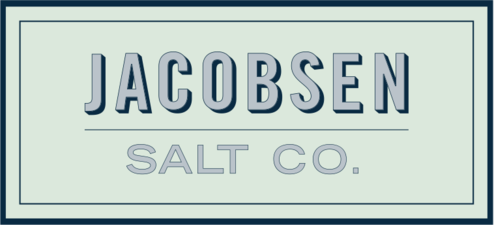 “Harvested from the cold, pristine waters of Netarts Bay on the Oregon Coast, Jacobsen Salt Co.’s flake and kosher sea salts have gained much critical acclaim for their beautiful and pure taste, texture, and appearance, and are used by chefs and home cooks around the world. We are proud to be the leader in the emerging vanguard of American Saltmakers, as well as first company to harvest salt in the Pacific Northwest since Lewis & Clark. In addition to an extensive assortment of pure sea salts and infused sea salts, Jacobsen Salt Co. also produces a line of salty confections, cocktail salts, seasonings and spice blends.” Also various prepared food products that use this salt as an ingredient.
“Harvested from the cold, pristine waters of Netarts Bay on the Oregon Coast, Jacobsen Salt Co.’s flake and kosher sea salts have gained much critical acclaim for their beautiful and pure taste, texture, and appearance, and are used by chefs and home cooks around the world. We are proud to be the leader in the emerging vanguard of American Saltmakers, as well as first company to harvest salt in the Pacific Northwest since Lewis & Clark. In addition to an extensive assortment of pure sea salts and infused sea salts, Jacobsen Salt Co. also produces a line of salty confections, cocktail salts, seasonings and spice blends.” Also various prepared food products that use this salt as an ingredient.
BeeThinking
In our world where last year beekeepers across the United States lost 44 percent of their honey bee colonies, maybe more of us need to consider backyard beekeeping. Here on this site, home beekeeping has been simplified. Everything you need to be a beekeeper is here. “All of our beehives are crafted at our mill in Portland, Oregon using kiln dried Western Red Cedar from the Pacific Northwest. We use these same products in our own apiaries and we love to pass on our knowledge of natural beekeeping to beekeepers new and old.”
Carved Wooden Spoons
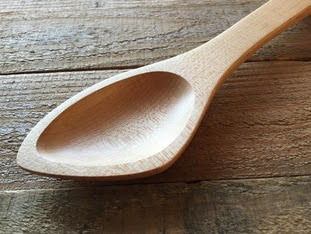 Woodenware items you can’t find anywhere else…wooden spoons of all shapes and sizes. From tablespoons, to teaspoons, the wooden spatulas, to the more exotic shaped kitchen utensil, there’s a wooden cooking utensil for every kitchen and occasion. All of my utensils are handcrafted and with proper care can last to be passed down generations. I use sustainably harvested wood and I’m dedicated to making a 100% all natural wood product that will be enjoyed for a lifetime.
Woodenware items you can’t find anywhere else…wooden spoons of all shapes and sizes. From tablespoons, to teaspoons, the wooden spatulas, to the more exotic shaped kitchen utensil, there’s a wooden cooking utensil for every kitchen and occasion. All of my utensils are handcrafted and with proper care can last to be passed down generations. I use sustainably harvested wood and I’m dedicated to making a 100% all natural wood product that will be enjoyed for a lifetime.
Arbor Teas
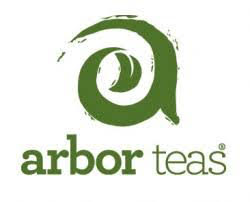 Our daily mission is to find the world’s most fantastic organic teas and deliver them to you as sustainably as possible. From our exceptional collection of organic and Fair Trade Certified® teas, to our Carbonfree® business practices, to our backyard compostable package, our passion is steeped in a desire to do worldly good, and our vision is to remain organic to a tea.” They have a wide variety of teas, plus teaware, and lots of information about tea and how to enjoy it.
Our daily mission is to find the world’s most fantastic organic teas and deliver them to you as sustainably as possible. From our exceptional collection of organic and Fair Trade Certified® teas, to our Carbonfree® business practices, to our backyard compostable package, our passion is steeped in a desire to do worldly good, and our vision is to remain organic to a tea.” They have a wide variety of teas, plus teaware, and lots of information about tea and how to enjoy it.
Lalune Naturals
Natural and organic ingredients for making your own skincare products, plus instructions and how-to videos.
Millstores
 Ready-to-finish wood furniture for every room in your home, made from a number of different types of wood.
Ready-to-finish wood furniture for every room in your home, made from a number of different types of wood.
Seventh Generation Sells Out to Unilever
Well, the world is changing.
Pioneering green products company Seventh Generation was just purchased by Unilever for $700 million.
It was actually an emotional shock for me to get this news
I remember when Seventh Generation was started in 1988. It was just before Earth Day 1990 and the book 50 Simple Things You Can Do to Save the Earth, which brought awareness to the mass market that what we do in our homes every day has an effect on the environment—for better or for worse.
Seventh Generation really was the first company to develop products with health and environment being the guiding star. And they did Read more about Seventh Generation…
For Seventh Generation to sell to Unilever…it’s the end of an era. Seventh Generation was an innovator, they were visionaries who changed the marketplace. And now decisions will be made based on mass market values instead of life values.
All I can say is thank goodness for all of the small businesses that are independently producing toxic free products. Please support them.
THE WALL STREET JOURNAL: Unilever Buys ‘Green’ Products Maker Seventh Generation
France Bans Plasticware
France has become the first country in the world to ban disposable, plastic cups and dishes.
The new law, which passed last month, requires all single-use cups, plates and other dishware sold in the country to be compostable and made at least partly of bio-sourced materials. Businesses have been given until Jan. 1, 2020 to comply.
A ban on plastic bags has been in place since July.
The decision to do this was made based on environmental considerations—France currently throws away more than 4.7 billion plastic cups every year. But it will also reduce exposure to toxic chemicals in plasticware as well.
Manufacturers, of course, are opposing the law, asserting that lower-income families regularly use disposable tableware because they can’t afford reusable tableware. I can’t agree with that argument. I once was living in a rented apartment by myself and I had one fork, one spoon, one knife, one plate, one bowl, one cup, and one glass. That’s all one person actually needs. Anyone can obtain these for practically nothing at any thrift store.
I think this is a good move, but we also need to consider the use of disposable products altogether. It is possible to have a society where everything is reusable and biodegradable. We don’t need plastic at all. Indeed, as a species we survived perfectly well without it until the twentieth century (the first plastic was bakelite, invented in New York in 1907).
ASSOCIATED PRESS: France to bid adieu to plastic dishes with controversial ban
Finding Hotels That Are Non-Toxic
Question from Mimi
Hello Debra,
This is an area in need of change!!
We have been staying hampton Inns for many years and have always called before to ask them not to use fabrezee and any fragrance in the rooms.
For a couple of years we found most of the rooms to be at least ‘liveable”
But, for the last two years we have traveled Florida panhandle, and up and back on the I 77/ I81 corridor from Fl to NH…and had some horrible experiences.
At the Hampton Inns in Florida and Virginia.. the one in Tallahassee reaked so badly that we had to leave the property at 3 AM and drive for more hours to our home,because my husband and I were getting sick. it took us two weeks to recover.
We contacted the customer service department many times and they just kept referring us to one new person after another . Yes, they compted the room, but that means nothing when you have a whole night without sleep and have a full drive the next day!
We are very upset about this!!! There are so many of us out here wanting to travel and having chemical sensitivity.
Can you recommend a hotel chain or group that would identify which hotels have nontoxic options as of Sept 2016.
We support your work and will spread the word .. thank-you for any info you can give us! And keep up the good work. More of us need to join in and change this!
Thank-you Mimi
Debra’s Answer
I totally agree with you!
I have a page about travel on Debra’s List.
I just went there and unfortunately found that the Safer Travel Directory website is no longer there.
And I searched online for anything new. Nothing. Old links broken.
I read that Hyatt Hotels and Fairmont Hotels are offering hypoallergenic rooms, but that was an old post, so I don’t know the current status. Would you contact these chains and see what the story is, and let us know?
We really need some improvement on this. Let me think about what we can do.
New Labels Can Help You Find Sofas Without Fire Retardants-But… They Still May Contain Toxic Chemicals

Last year there was a big change in the furniture world. A California law went into effect that allowed furniture manufacturers to make and sell upholstered furniture—such as sofas, loveseats, and chairs—without toxic fire retardants. That’s certainly good news!
The problem is that while the fire retardants are gone, most of the affordable sofas and chairs are still made with synthetic materials and toxic finishes like stain repellants.
Less toxic to be sure…but not toxic free yet.
Since January 1, 2015 the CA labeling law has required all upholstered furniture (couches, sofas, loveseats, and recliners) to have a label that states whether or not harmful flame retardant chemicals were added to the product.
I could have told you this last year but didn’t, because it only applied to upholstered furniture manufactured after January 1, 2015. Stores were still filled with furniture manufactured before this date.
Now, furniture manufactured since the beginning of 2015 is more widely available.
If you are buying upholstered furniture, what you want to look at is the “law label.”
And now I’m going to send you over to an article that has a very clear explanation of how to find the label, the three different labels you might see, and how to find the information about flame retardants—complete with pictures.
NATURAL RESOURCES DEFENSE COUNCIL: Want to Avoid Toxic Couch Chemicals? Just Look for New Label!
Toxic Plastics From China
I know a lot of you are concerned about toxics in products from China.
Here’s a website that recently came my way via Q&A comments. I’m pulling it out and making a post so we can all find it easily.
Campaign to Halt the Import of Chemical-Emitting Smelly Plastic from China
If you know of any other sites with specific information about toxics in products from China, please post a comment with the name and link.
Thank you.
Debra 🙂
FDA Finds Glyphosate in Honey
FDA has found residues of the weed killer glyphosate even in a food that is not produced with the use of glyphosate: honey.
All of the samples the FDA tested in a recent examination contained glyphosate residues, and some showed residue levels double the limit allowed in the European Union. There is no legal tolerance level for glyphosate in honey in the United States.
According to the FDA records, samples tested by an FDA chemist showed these residue levels:
| Carmichael’s Honey | Louisiana | 107 ppb |
| Leighton’s Orange Blossom Honey | Florida | 22 ppm |
| Sue Bee Honey | Lowa | 41 ppm |
Sue Bee is marketed by a cooperative of American beekeepers as “pure, all-natural” and “America’s Honey.” Customers “can be assured that Sue Bee Honey is 100% pure, 100% all-natural and 100% American,” the Sioux Honey Association states.
The obvious recommendation is to choose organic honey, but I’m not sure it has less glyphosate. What is becoming more and more evident is that glyphosate is now widespread in the general environment, and not limited to GMO foods.
The good news is that honey has a tremendous amount of nutrients and inherent healing qualities. Of all foods, honey is the food most likely to have the ability to counteract the negative affects of glyphosate.
I would still choose organic honey.
THE HUFFINGTON POST: FDA Finds Monsanto’s Weed Killer in US Honey.
What We’ve Learned in 25 Years of Research on Endocrine Disruptors
This week, researchers, public health advocates, government officials, and industry spokespersons will meet at National Institutes of Health (NIH) to celebrate 25 years of scientific research on endocrine disrupting chemicals (EDCs).
Here is a good commentary on what we’ve learned about this chemicals, and where we need to go to learn more.
New Study Compiles Data on Toxics in House Dust—45 Chemicals Found
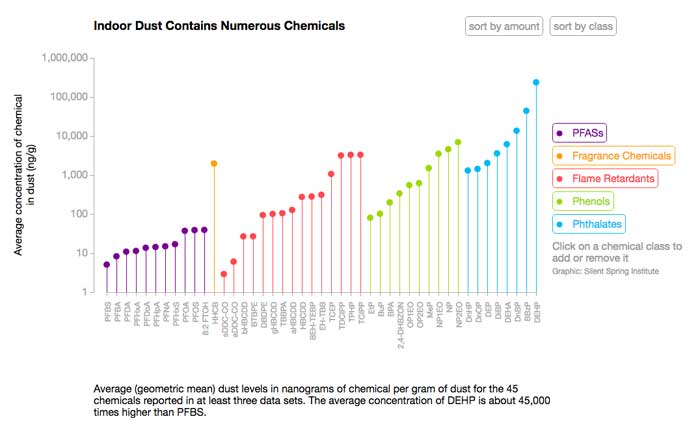
An interactive version of this graph can be found here (scroll down the page).
A new study came out this week that gives us more data than ever about what types of toxic chemicals are found in household dust and amounts.
The fact that household dust contains toxic chemicals is not new—but this study is the first to make a comprehensive assessment of consumer product chemicals of concern in the dust found in US homes, provide a picture of the toxic chemicals in the home, estimate potential exposures for children and determine heath threats.
The study identifies 45 chemicals from five chemical classes—phthalates, phenols, flame retardants, fragrances, fluorinated chemicals—that were measured in dust in US homes.
Some phthalates, fragrance, flame retardants, and phenols were consistently found in 90 percent or more of dust samples across multiple studies.
The articles below do a great job of explaining the problem, but fall short on giving workable solutions.
Here’s my advice.
1. All the things you are already doing to reduce your use of chemicals in your home that you are learning on this website are also reducing toxic chemicals in your house dust. So keep finding toxic products in your home and continue to replace them with nontoxic products.
2. Get an air filter that removes both particles (dust) and gasses (chemicals. Check out my recommended brands at Debra’s List: Air Filters.
Find out what’s in your indoor air and take steps to improve it. This could make a big difference in your health.
CBS NEWS: Household Dust is Laced With Toxic Chemicals, Study Finds
a news story
NATURAL RESOURCES DEFENSE COUNCIL: Not Just Dirt: Toxic Chemicals in Indoor Dust
an analysis
ENVIRONMENTAL SCIENCE & TECHNOLOGY: Consumer Product Chemicals in Indoor Dust
the study
NATURAL RESOURCES DEFENSE COUNCIL: Toxic Dust: The Dangerous Chemical Brew in Every Home
another blog post about toxic dust
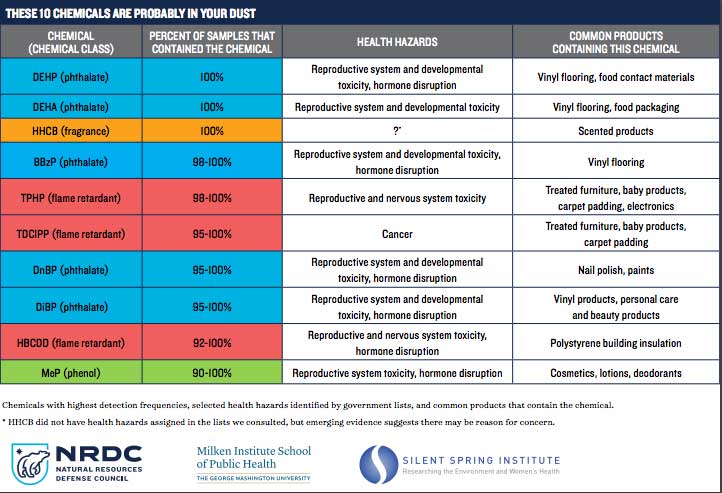
Penns Hill Soap
Our handmade bar and liquid castile soap is made in small batches using certified organic oils and a recipe that dates back to the 11th century. We use certified organic essential oils instead of “fragrance” for their delicate bouquet and high quality. Scented soaps have a soft whiff of aroma – as subtle and gentle as the soap itself.” Unscented and natural aromas of lavender, lemongrass, cinnamon, rosemary and others.
Salinity Salts
 Handcrafted gourmet finishing salt blends made from the purest sea salts and organic herbs. Choose from more than a dozen flavors from around the world. Read about their salt and the organic farms that supply their herbs.
Handcrafted gourmet finishing salt blends made from the purest sea salts and organic herbs. Choose from more than a dozen flavors from around the world. Read about their salt and the organic farms that supply their herbs.Fair Indigo Joobles
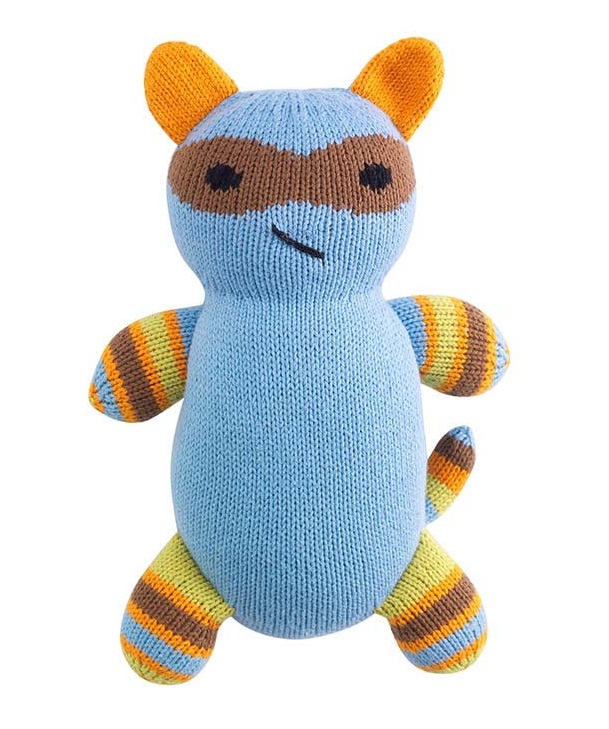 Cute and colorful stuffed animals made from 100% organic cotton and gentle, earth-friendly Oeko-tex® certified dyes.
Cute and colorful stuffed animals made from 100% organic cotton and gentle, earth-friendly Oeko-tex® certified dyes.
The Effects Of Radiofrequency Electromagnetic Radiation On Sperm Function
Abstract
Mobile phone usage has become an integral part of our lives. However, the effects of the radiofrequency electromagnetic radiation (RF-EMR) emitted by these devices on biological systems and specifically the reproductive systems are currently under active debate. A fundamental hindrance to the current debate is that there is no clear mechanism of how such non-ionising radiation influences biological systems. Therefore, we explored the documented impacts of RF-EMR on the male reproductive system and considered any common observations that could provide insights on a potential mechanism.
Among a total of 27 studies investigating the effects of RF-EMR on the male reproductive system, negative consequences of exposure were reported in 21. Within these 21 studies, 11 of the 15 that investigated sperm motility reported significant declines, 7 of 7 that measured the production of reactive oxygen species documented elevated levels and 4 of 5 studies that probed for DNA damage highlighted increased damage, due to RF-EMR exposure. Associated with this, RF-EMR treatment reduced antioxidant levels in 6 of 6 studies that studied this phenomenon, while consequences of RF-EMR were successfully ameliorated with the supplementation of antioxidants in all 3 studies that carried out these experiments.
In light of this, we envisage a two-step mechanism whereby RF-EMR is able to induce mitochondrial dysfunction leading to elevated ROS production.
A continued focus on research which aims to shed light on the biological effects of RF-EMR will allow us to test and assess this proposed mechanism in a variety of cell types.
PUBMED: The effects of radiofrequency electromagnetic radiation on sperm function.
The effects of radiofrequency electromagnetic radiation on sperm function Full PDF
Health Problems with Infrared Heaters?
Question from Jody
Hi Debra,
Do you know of any health concerns related to infrared heaters? I am considering installing this:
http://biosmartsolutions.com/shop/heating/on-wall-heaters/bio-1500owa-onwall-heater-and-airpurifier/
Thank you. Jody
Debra’s Answer
This looks fine to me as a heater.
However, the “air filter” is only a UV lamp and negative ion generator. This removes some particles and no gasses, but does kill bacteria and viruses and other micro-organisms.
The same caveat applies to this heater as to all others: the paint may emit odors when the heater is on until the paint is fully outgassed. But when outgassed, this heater should be fine.
Air Filter for New Car Smell
Question from Bonnie
Dear Debra,
I had wanted to buy a new 2016 car until I smelled the chemicals. I was shown a 3 year old prior leased car as I would still have warranty and thought I detected new car smell, but less. When my friend was talking with the salesperson I decided to find where the 2016 odor was coming from – It is from the AC vent!
I can not put charcoal pads on that. I saw you mentioned a filter – does it sit in the car with me or does it get installed into the car?
I would rather have a very old car, but I am concerned financially I may not be able to cover repair costs.
How well does the filter work? What year car do you think is safe from offgasing.
Do you think some models are more safe than others? Foreign cars can last many decades – so I rather take an old car.
I checked some and the seats are squashed, but a friend said a upholstery shop could replace them.
Would like to give a big thank you for the suggestion you gave me many years ago about the sleep number bed. The odor is not detectable with the charcoal blankets. It was the only bed I could use due to a medical problem. THANK YOU.
Debra’s Answer
You are very welcome.
The filter I have used in the past is from E.L. Foust It’s 160AN Auto/RV Air Purifier. It plugs into your cigarette lighter and sits on the floor on the passenger side. I found it to work very well. You plug it in and turn it on.
I try to purchase cars that are at least five years old. I manage to find used cars with low miles.
The car I currently have was only two years old when I bought it. It still smells like a new car. Mostly I drive it with the sunroof open so the fumes can escape.
Yes foreign cars last longer than American cars. Larry just bought an old Prius. They can last more than 200,000 miles.
Right now the choices seem to be 1) old and outgassed 2) use an air filter 3). Reupholster.
If you think the smell is coming from the AC, use the air filter.
Non-toxic pad under dining room table cloth
Question from Melanie
Hi Debra,
I hate vinyl, but need a thin pad to go under my dining room tablecloth.
I have searched the Internet thinking I could find latex or rubber padding but was not successful. Thoughts?
There has got to be something less toxic than vinyl…
Thanks so much, Melanie
Debra’s Answer
First, for those who don’t know why you might need a dining table pad…
If you have a nice wood dining table, it can be damaged by heat, scratches, and spills. A pad can protect the surface of your table from these accidents.
This is good for the table, but may not be so good for health.
The industry standard is to use vinyl and other possibly toxic materials and adhesives to make these pads.
There seem to be two types:
* solid, about 11/2” thick
* flexible, like a table cloth with thin padding.
The industry standard is to use vinyl and other possibly toxic materials and adhesives for both,
So the challenge here is to come up with some type of padding that will protect the table. I’m thinking if we can find a nontoxic foam in a thin layer, that should do it. And then put a tablecloth on top.
I actually did find something I think will work, but haven’t tested it.
There’s a website called Foam Order that sells thin sheets of foam made from EVA or polyethylene. Either of these would be fine to use. I don’t know if these are waterproof, however you can get it as thin as 1/8”. Call them and ask if this would meet your needs and let us know.
If it’s not waterproof, you could add a waterproof layer of something else. But this would give you the padding.
FDA Orders Removal of Antibacterial Triclosan From Consumer Soaps
The Food and Drug Administration (FDA) has finally told manufacturers they can no longer put triclosan in consumer soaps.
The FDA says antibacterial do little or nothing to make soap work any better and the industry has failed to prove they are safe.
Manufacturers have one year to comply.
Triclosan is still allowed as an antibacterial in other consumer products.
NBC News: FDA Orders Antibacterials Removed From Consumer Soaps
Listen to these shows on Toxic Free Talk Radio about antibacterials:
TOXIC FREE TALK RADIO: How Antibiotics and Antibacterials are Compromising Our Health
TOXIC FREE TALK RADIO: The Dangers of Antimicrobials and How to Choose Products Without Them
Bar vs Bottle — How Do You Buy Your Soap?
An interesting article entered my email inbox the other day from the environmental blog Treehugger.
It was about the change that’s occurring in the way people buy soap.
Bar soap sales are declining and liquid soap sales are gaining.
I was sorry to read this. From a toxics viewpoint, soap is one of the few products that can be very pure.
I love to buy soap from a local soap maker who doesn’t even put a wrapper on the soap. They just stamp the information right into each bar. Whenever I drive in that direction, I stop and buy a few bars.
One of my pleasures in life is buying all different kinds of handmade soaps at various craft fairs and trying them out.
But I can understand about soap in a bottle.
Reading about this, I took a conscious look at whether I was using bar or bottle soap. I hadn’t really thought about it.
What I observed was that I use bar soap in the shower and bathroom sink, and liquid soap in the kitchen.
For me, the issue is soap melting all over the soap dish. In the kitchen I often need to wash my hands because I have been cutting up chicken, and I don’t want to put bacteria on the soap. A squeeze of foaming soap from the bottle seems to be much more sanitary in that regard.
But it makes sense to stick with bar soap. We certainly don’t need yet another plastic bottle.
What do you think about this?
TREEHUGGER: The Sad Slippery Slope of Bar Soap
Affordable Sofas
There have been so many questions about finding affordable sofas I thought I would make a separate post to answer this question.
First, there are no ready-made affordable sofas that I would call toxic-free.
All the ready-made sofas cost thousands of dollars.
But there are some things you can do. [I’ve mentioned these before in other places, but am gathering them all together in one place for you.]
My first nontoxic sofa was a sectional sofa where the pieces were made with cotton canvas over metal frames, with toxic pillows on top. I just replaced the toxic pillows with 100% cotton pillows stuffed with some of the first organic cotton batting that was available. It was a great sofa and I wish someone would make this type of frame now.
Here are three strategies I know of. Please comment if you know of any others.
REUPHOLSTER
My current sofa started as an old frame, which I stripped and had reupholstered. I bought the sofa frame at a storage auction for $50. The upholsterer said it had “nice bones.” It’s a beautiful, old, solid wood frame.
I chose a 100% linen upholstery fabric in a plaid to honor my Scottish heritage. The cushions are old spring cushions covered with wool batting.
All in all the total cost was about $1500. That was maybe 20 years ago. It’s held up very well, It still looks the same as it did 20 years ago. No wear and tear.
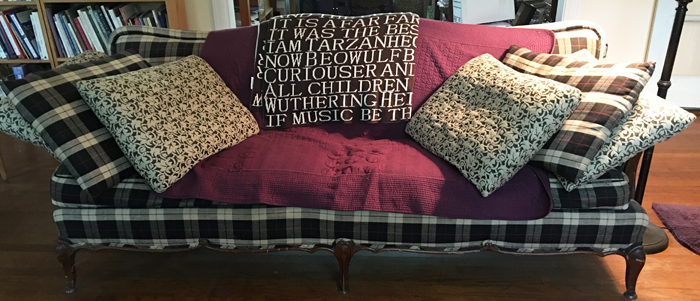
My sofa with linen uphostery, purple cotton quilted throw and cotton throw with words
FILL A FRAME
Ever since futons became popular in the 1980s, there have been wood frames available to turn those futons into sofas. Today they are also available made of metal. And you can fill them with any kind of cushions you can imagine.
Wood frames for futons come in two designs: clamshell (sofa only) or bi-fold (which converts into a platform bed).
Here are some sofa frames from White Lotus Home made out of sold wood with water-based glues and nontoxic finishes. But there are many more online. Just search on “futon frame for sofa.” Even places like overstock and wayfarer have them for only a few hundred dollars (be sure to check materials before buying).
There are many more frames online—I just checked. Search on “sofa plans” and other similar terms.
Here are hundreds of futon frames online.
Some frames come complete with pillows you probably don’t want, but other frames you can purchase separately (and you can always toss the pillows if necessary and replace them with natural ones.
Doesn’t say what pillows are but I assume they are synthetic. I would replace the cushions and pillows.
Wow. Just exploring futon frames for just a few minutes showed me there are MANY more inexpensive sofas in this category than ever before, but you’ll need to provide your own cushions.
BUILD YOUR OWN
And it turns out nowadays you can even get plans for making your own sofa.
DIY may be the way to go if you are handy or can enlist help (I am fortunate that Larry is always willing and able to repair or build anything I want). You could also get the plans and materials and hiring someone to put it together and it would still be affordable. And you could modify the plans to get exactly the sofa you want.
Here are some plans sent by a reader. There may be more:
http://www.ana-white.com/2016/03/free_plans/modern-wood-storage-sofa
http://www.ana-white.com/2010/11/build-your-own-storage-sofa.html
http://www.ana-white.com/2015/06/free_plans/one-arm-outdoor-sectional-piece
http://www.ana-white.com/2014/05/modern-sectional-sofa
Here’s a massive Use this for ideas and plans, but substitute your own toxic-free materials.
Please comment with your ideas, questions, and photos of affordable sofas (if you have one) and even a natural sofa that’s not affordable (if you have one).
Toxics in Toothpaste
The Cornucopia Institute has a new report on toothpaste that is exceptional, It covers regulations, and ingredients and ends with a list of toothpastes that contain organic ingredients and how to make your own at home.
Is There Any Difference Between PET and PETE?
Question from Katherine
I’m confused about PET and PETE. Are they the same thing or different?
Debra’s Answer
PET and PETE are both acronyms for polyethylene terephthalate.
Polyethylene terephthalate is a clear, tough plastic in the polyester
family. It is made from only two chemicals that are tightly bonded together.
PET has been approved as safe by the FDA and the International Life Sciences Institute
(ILSI). In 1994, ILSI stated that “PET polymer has a long history of safe consumer use,
which is supported by human experience and numerous toxicity studies.”
There is one important thing to know about polyethylene terephthalate.
Because it has “phthalate” in its name, some people think PET contains toxic “phthalates.” This is not correct.
The toxic “phthalates” that leach out of plastics are “orthophthalates,” which is a completely different type of chemical than “terephthalate.”
I also researched to see if there was any outgassing from PET into the air. NASA has a website (outgassing.nasa.gov) where you can look up all kinds of materials they have assessed for outgassing because they need to choose materials for spaceships that do not outgas. They found that PET needed zero curing time to be used in a spaceship.
Colors in Silicone
There have been some questions about what type of colorant is use to make brightly-colored silicone products.
I’m in the process of reading a book called Advances in Polymer Coated Textiles=which states that coloring agents for silicone coatings need to be chosen carefully because organic pigments are not suitable for high-temperature uses. [Organic pigments are carbon based and can be natural or synthetic. Synthetic organic pigments are made from petroleum.]
Therefore inorganic pigments such as iron oxides and titanium dioxides are used.
I’m thinking this would hold true for silicone kitchenware as well.
I also found a study that measured color leaching from silicone: EUROPEAN JOURNAL OF DENTISTRY: Color Stability of Silicone or Acrylic Denture Liners: An in Vitro Investigation. Their tests show the silicone dental liners showed far less change in color than the acrylic liners.
Which Handwashing Dish Soap Do You Use?
Question from Sicili
Hi Debra. I noticed on one of your comments, you said you hardly have any plastic in your home at all. I just wanted to ask ,what type of hand dish washing soap do you use for doing dishes ? I am trying to figure out if I should use the natural ones listed on EWG or if I should try to avoid the plastic and use bar soap to wash the dishes? I try to learn as much as I can from your books and website but for some things I would just really like to know what you use right now. How do you feel about Tropical Traditions, household traditions dish soap? Thank you so much for your time.
Debra’s Answer
Right now I use BioKlenn All Natural Dish Soap.
The one I get has a citrus scent that I like and it cleans really well.
I’ve also recently used Earthview Dish Detergent, which I liked a lot. It’s made for people with MCS.
Tropical Traditions is a good company with very high standards. Their Dish Liquid is developed by and for people with allergies, asthma, and MCS. However, they do not give a complete list of ingredients. Only “surfactants,” “emulsifiers,” etc.
I am a stickler for wanting to know the actual ingredients, which are listed on the brands I use.
I’m not saying there is anything wrong with Tropical Traditions. I just don’t know because they are not disclosing their ingredients.
The dish soap I use comes in a plastic bottle. I wouldn’t use bar soap to wash your dishes unless it is a very plain soap or a bar soap developed specifically for dishes. Bar soap is designed for skin, not for eating.
Non-Profits Sue General Mills for False and Misleading Use of ‘Natural’
Tests Reveal Nature Valley Products Contain Glyphosate,
an Ingredient in Monsanto’s Roundup
Washington, DC – Today, three non profit organizations filed a lawsuit against General Mills for misleading the public by labeling their Nature Valley brand granola bars “Made with 100% NATURAL whole grain OATS.” It was recently discovered that the herbicide chemical glyphosate, an ingredient in Roundup and hundreds of other glyphosate-based herbicides, is present in the Nature Valley granola bars, which consumers expect to be natural and free of toxins.
Moms Across America, Beyond Pesticides and Organic Consumers Association with The Richman Law Group filed jointly on behalf of the non profit members in Washington DC under the District of Columbia’s Consumer Protection Procedures Act.
“As a mother, when I read “100% Natural” I would expect that to mean no synthetic or toxic chemicals at all. Glyphosate is a toxic chemical that the EPA recognizes as a “reproductive effector” which “can cause liver and kidney damage” and “digestive effects.” It is unacceptable that Nature Valley granola bars contain any amount of this chemical.” Zen Honeycutt, Founder and Executive Director of Moms Across America.
A national survey conducted by Consumer Reports in 2015 finds that sixty six percent of consumers seek out products with a “natural” food label under the false belief that they are produced without pesticides, genetically modified organisms, hormones, and artificial ingredients.
“Glyphosate cannot be considered ‘natural’ because it is a toxic, synthetic herbicide,” said Jay Feldman, executive director of Beyond Pesticides. “Identified by the World Health Organization(WHO) as a carcinogen, it should not be allowed for use in food production, and certainly not in food with a label that suggests to consumers that the major ingredient –oats– is 100% natural, when it is produced with and contains the highly hazardous glyphosate,” he said.
“Food grown with dangerous pesticides like glyphosate isn’t natural. Consumers understand this. That’s why sales of natural products are booming. Unfortunately, companies’ misleading claims trick consumers into buying just what they’re trying to avoid. This has to be stopped.” -Alexis Baden-Mayer, Political Director of the Organic Consumers Association
The case specifically cites the use and presence of the weedkiller glyphosate in General Mills’ Nature Valley Granola products. The hazardous chemical is used during the production of oats, the major ingredient in these products, which are marketed as “natural” and labeled “Made with 100% Natural Whole Grain Oats.” As a result, glyphosate is present in the natural-labeled products.
Proponents of glyphosate herbicide use may claim that the residue levels found in many foods and beverages in America recently are below the EPA allowable levels established in 2014, and therefore consumers have no reason to be concerned. However, a 2015 study published in the journal Environmental Health finds that chronic, low-dose exposure to glyphosate as low as .1 parts per billion leads to adverse effects on liver and kidney health. A study released in early 2016 finds that glyphosate can cause changes to DNA function resulting in the onset of chronic disease, including diabetes, obesity, and Alzheimer’s disease.
The lawsuit alleges that, when marketing Nature Valley products, General Mills misleads and fails to disclose to consumers of the use and presence of glyphosate and its harmful effects. Plaintiffs are asking a jury to find that General Mills’ “natural” labeling is deceptive and misleading and therefore a violation of law, and require its removal from the market.
View a web version of this press release with links here
Debra’s Answer
I just have to comment on this.
I have no problem with these groups filing a suit, however the logic just boggles my mind.
1. There is NO legal definition of “natural.” It is widely used in the marketplace in reference to ingredients being of plant, animal or mineral origin, and not petrochemical.
2. ALL so-called “natural” products contain pesticides, which are intentionally added to the ingredients during the growing of the plants and animals. Also other toxic chemicals may be used. This is all that “natural” means: the ingredients are not made from petrochemicals.
3. If General Mills is false and misleading, so is every other product that claims to be natural.
Part of the problem in the marketplace is our really inadequate labeling laws. Labels on food and personal care items require only that the ingredient that “goes into the pot” (so to speak) be on the label. Its like a recipe tells you only what to put in the bowl. Labels only list the end ingredient, even if it contains many other sub-ingredients.
For example, if “ham” is and ingredient in a food product, labeling laws do not require the label to list the nitrates that are in the ham. Nor do labeling laws require that pesticides or other processing chemicals be listed.
If I were labeling supermarket applesauce, I would say
* apples (with a list of pesticides commonly used on apples)
* GMO corn syrup
* water (with chlorine, fluoride and other water pollutants)
And then I would label organic applesauce
* apples
* water
But instead we have to say
* organic apples
* filtered water
And the toxic product requires no qualifiers to indicate that it is toxic.
We need a MASSIVE overhaul of labeling in order for consumers to know what is actually in products.
I would say most products on the market today are false and misleading with their labeling. General Mills Nature Valley is not the only one.
However, there is actually something that is false and misleading about Nature Valley, and it’s not the glyphosate. It’s that Nature Valley gives an impression that it is natural in it’s name, packaging and advertising.
I wonder if any of these products would sell if manufacturers were required to show consumers right on the label what’s in them.
Nontoxic Glue for Wood Floor
Question from Katie
Hi Debra,
Glad to be able to ask advice on nontoxic glue for a patch job. We had to remove several planks of engineered hardwood flooring in front of our back sliding door. We will be putting down new planks but I am concerned about fumes from the glue.(I will outgas the new planks…)
I read on your site that you recommend. Titebond II yellow glue for this. We are on a concrete slab.
Our handyman looked into it and thinks Titebond 771 would be better.
What would you recommend? I am very chemically sensitive.
Thank you for your help.
Debra’s Answer
No, I wouldn’t recommend Titlebond 771.
Here is the SDS for Titebond II
Here is the SDS for Titebond 771
Notice that 771 says “: This material is considered hazardous by the OSHA Hazard Communication Standard (29 CFR 1910.1200).”
!! says “this material is not considered hazardous by the OSHA Hazard Communication Standard (29 CFR 1910.”
I am confident Titebond !! will do the job. I’ve used it to attach wood to concrete with no problem.
Handmade Betty
 All kinds of organic body care products for men, women, and children, including the purest sun protection I’ve seen. Packaged in glass jars. “We make everything in small batches & with only transparent ingredients . Our Company dedicate itself in finding the best ingredients and suppliers to find wholesome and beautiful ingredients. All of our products are made from scratch and made to order. It is made once the order comes in so nothing is sitting on shelves….We are very proud of my products! We are constantly doing research to make sure not only the products are free of harmful chemicals but also that each essential oil & ingredients that we put in our products are fresh and wont disturb your skin. Homemade Betty started making products for her children and her self. She was worried about all the products that were going on their body! She started making lotion and never turned back. Every product that she makes is something her or her family uses daily.”
All kinds of organic body care products for men, women, and children, including the purest sun protection I’ve seen. Packaged in glass jars. “We make everything in small batches & with only transparent ingredients . Our Company dedicate itself in finding the best ingredients and suppliers to find wholesome and beautiful ingredients. All of our products are made from scratch and made to order. It is made once the order comes in so nothing is sitting on shelves….We are very proud of my products! We are constantly doing research to make sure not only the products are free of harmful chemicals but also that each essential oil & ingredients that we put in our products are fresh and wont disturb your skin. Homemade Betty started making products for her children and her self. She was worried about all the products that were going on their body! She started making lotion and never turned back. Every product that she makes is something her or her family uses daily.”
Uncle Goose
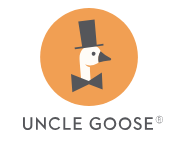 Adorable wooden blocks painted with animal faces and features. Also beautiful ABC blocks. These are truly works of art. I love these! “We handcraft every set in Grand Rapids, Michigan, using choice materials from around the Great Lakes. And yes, we are 100% made in the USA…non-toxic, child-safe inks on all our blocks.”
Adorable wooden blocks painted with animal faces and features. Also beautiful ABC blocks. These are truly works of art. I love these! “We handcraft every set in Grand Rapids, Michigan, using choice materials from around the Great Lakes. And yes, we are 100% made in the USA…non-toxic, child-safe inks on all our blocks.”
Terrain Heritage Garden Hose
A beautiful garden hose made from toxic free polyurethane, with chrome-planted lead-free brass fittings. Come in six lovely garden-compatible colors. Plus this site has many more stylish and natural garden and home products.
Portola Paints & Glazes
Handcrafted Zero-VOC paints (acrylic base). made in small batches and blended by hand. “Jamie and Casey Davis, co-founders and owners, were born and raised in Los Angeles to a family of artists. Mentored by their father, a high-end custom home builder, Jamie and Casey inherited a deeply rooted love for design and color…Because every paint color provides an opportunity to tell a story and transform a space, the brothers take both time and pride in creating customized palettes that reflect a client’s unique personality. Their extensive variety of paints and specialty finishes are all made locally and in small batches at their L.A. headquarters. Using their knowledge of pigment and saturation, and an ability to match all of their paints by eye, they design full spectrum colors that reflect a broader range of light and coordinate in subtle, yet powerful ways, to any environment…Portola products are high quality, eco friendly & affordable. We are also a family owned and operated small business, and source everything locally.”
Soludos
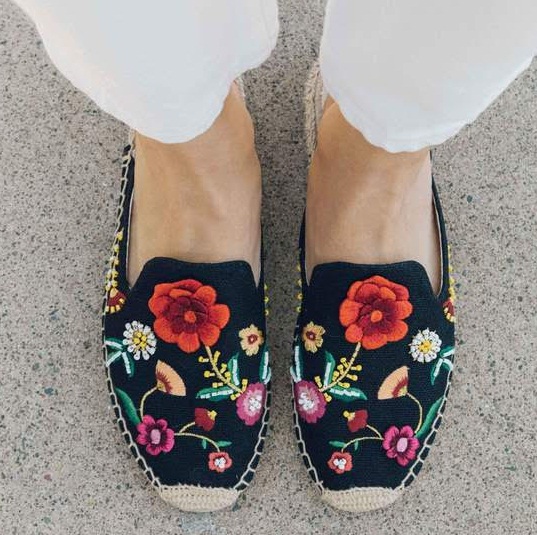 Traditional cotton/jute espadrilles with natural rubber (latex) soles in up-to-date styling: tennis shoes, slippers, sandals. Also some suede uppers, some linen linings. Lots of colors, some decorated. Flats and wedge heels. Women and men. Read comments for advice about ordering the correct size.
Traditional cotton/jute espadrilles with natural rubber (latex) soles in up-to-date styling: tennis shoes, slippers, sandals. Also some suede uppers, some linen linings. Lots of colors, some decorated. Flats and wedge heels. Women and men. Read comments for advice about ordering the correct size.
Lancaster Creations
Organic herbal products “born out of a mother’s need for clean, natural, unadulterated products for her home and family…owned and operated by a self proclaimed “Arti-Free” Mommy of 2…We use the highest quality Organic ingredients & source locally whenever possible. Our beeswax is collected from a CCOF certified small family owned farm in Kingsburg, California, and every gram is filtered in house by April Lancaster herself…100% Organic Goodness. Made by hand, with love in a toxicant free home.
Rooted Athlete
Unscented, certified organic stick deodorant made from coconut oil, carnauba wax, arrowroot powder, shea butter, and baking soda. Also scented available.
Coco Pits
Unscented, certified organic stick and cream deodorants, made from organic virgin, cold-pressed coconut oil, sodium bicarbonate, organic arrowroot powder, beeswax, Vitamin E oil, and organic essential oils. Also comes in six scents.
Stick Candles
Unique handmade 100% beeswax candles—cast from sticks, twigs and branches. “We pour our candles one at a time. Originally made as a gift for mom…”The Candles that we are now able to cast, from shapes that we gather, strike me as beautiful and fascinating…when someone tells me about their experience with a candle that I made…It doesn’t point to me. It points to the shape of that cutting. Beauty in Nature.Wow : What Could Be Better Than That ?”
The Fastest Way to Remove Paint Fumes
Last week I had an interesting experience on a private Facebook group I belong to.
A pregnant woman with a 1 1/2-year-old posted that she had just moved into here new house the day after renovations were done and she could still smell new paint, floor adhesive and lacquer. She was trying to “get these toxins out of the house FAST!”
Given that this is a private group and anyone can post on any subject, she got quite a few well-intended recommendations. They were not, however, the correct actions to take to remove volatile chemical gasses from her home.
Here are some of the suggestions (and my comment on them on the indent lines after each comment):
- I have a floor fan you can use.
Inadequate.
- Do a wipe down with vinegar and water.
This will do nothing for paint fumes.
- Leave all windows open so fumes can vent out of the house. Can also put 2 or 3 box fans in windows on one side of house in open windows drawing air OUT of the house. This will pull in fresh air from the remaining open windows. You need to let the fumes escape from the walls and flooring, and then be vented out of the house. It may take some time.
Ventilation is always good, but in this case what is needed is to accelerate the release of the VOCs in the paints and adhesives.
- Place bowls of baking soda with lemon squeezed on top (leave the lemons in the bowl too) around the house.
Baking soda does remove odors, but not specifically paint fumes.
- Take big bowls full of ammonia and place them in every room, shut the door, it absorbs the smells.
This may remove odors, but ammonia itself is a toxic chemical and will not remove toxic gasses.
- Buy an air purifier from Target for around $100.
Air filters sold at Target and other such stores do NOT remove paint fumes and other VOCs. They are designed to remove particles such as dust and pollen, which are larger than chemical gasses.
- There are a number of plants that remove toxins from the air , floors etc and then give you fresh air. You can google the list. I believe there are about 12 different ones you can choose from.
Plants are not adequate to handle the toxic chemical gasses in this home. You would need hundreds of plants. I did the math once on this to see if I could recommend this instead of air filters. Not in a situation like this. A 9×12-foot room with an 8-foot ceiling is 864 cubic fee, so you would need 72 plants to duplicate the results from Wolverton labs—a virtual jungle!
Here’s what to do in a situation like this:
- Get yourself and your family out of the house. Find somewhere else to stay until you have handled the toxic exposure.
- Close the windows and “bake” the house. Follow the instructions at QA: Intructions to “Bake Out Toxic Fumes
- Get an air filter that removes toxic gasses. The best air filter I know of for removing toxic fumes from an area fast is the EnviroKlenz Mobile Unit.
Of course it’s always best to paint with a zero-VOC paint to begin with.
Do You Need to Change Your HVAC Filter?
Last week I finally changed my HVAC filter and it made so much difference that I had to tell you about this.
Just to be clear, an HVAC filter removes dust and other particles from the air. It has nothing to do with removing toxic gasses (for toxic gasses you need something like the EnviroKlenz HVAC filter. The purpose of the particle filter is to remove particles so they don’t clog up the HVAC.
HVAC particle filters are designed to last for three months, and then you need to change them. I was one month overdue because I can’t climb up there and change it myself. I need to get someone else to do it.
When we took the filter out, it had a lot of dust buildup all over it.
What was amazing to me was how much BETTER the air conditioning worked after the filter was changed!
I leave my A/C on 72 degrees. With the new filter, it was way too cold. I now have my A/C set to 74 degrees and am entirely comfortable. A new filter made that much difference.
I’ll save more than the cost of the filter this month on my power bill, and create fewer air pollution emissions from the generation of electricity to keep the air cool.
Now I want to give you a tip too about choosing a dust filter for your HVAC.
I chose a Honeywell Allergy Plus Air Filter, which I purchased at my local Home Depot.
All HVAC filters have a rating that tells you how much they will filer from the air.
Here is the rating from the filter I purchased. I like this label because it clearly shows that as you move up the ratings the filter removes more volume of particles and more different types of particles.
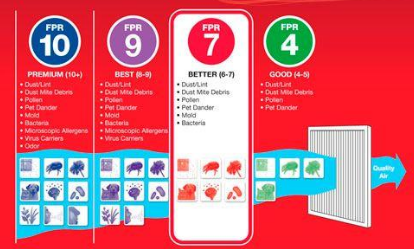
I bought a 7 because it removes more than 4, and they didn’t have any 9 or 10s on the shelf.
What you want to look for is a MERV rating or an FPR. The difference is:
- MERV is a universal industry rating
- FPR is a made up rating by the manufacturer.
- MERV 8 is considered the best choice to protect your HVAC without spending more money than you need to. FPR 7-9 is equivalent to MERV 8.
If you think ahead, you can order a box of four filters online and save money. And you’ll be good for a year.
Filters are supposed to last 90 days, but not every day is the same. If you’re not running your HVAC, you don’t need to change the filter. Check it every 90 days. If it’s grey, change it. If it’s still white, let it go a little longer.
But changing your filter at the right time DOES make a difference in your power bill and pollution. So pay attention and change your filter when it needs to be changed.
EnviroKlenz Hand Soap & Deodorizer
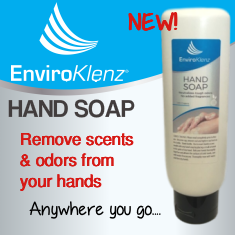 A liquid Castile soap that eliminates scents and odors from your skin.The soap utilizes the EnviroKlenz patented earth mineral technology to neutralize the odors at the source without the use of masking agents offragrances. Nontoxic and fragrance-free. Gentle on all skin types. For a 10% discount on your entire purchase, enter coupon code “toxicfree10″ at checkout.
A liquid Castile soap that eliminates scents and odors from your skin.The soap utilizes the EnviroKlenz patented earth mineral technology to neutralize the odors at the source without the use of masking agents offragrances. Nontoxic and fragrance-free. Gentle on all skin types. For a 10% discount on your entire purchase, enter coupon code “toxicfree10″ at checkout.
 |
Listen to my interviews with Kyle Knappenberger, Director of Applications at Timilon Technology Acquisitions LLC |
Most Modest
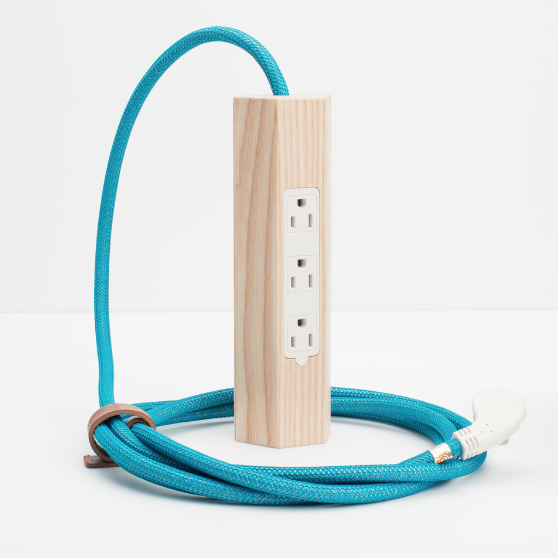 Power strips in unfinished solid wood housings. “a new power solution that considers where and how people use power today. A functional wood form combined with a one of a kind knitted mesh power cable, Niko adds an element of fun to any environment.” Comes in several styles and cord colors.
Power strips in unfinished solid wood housings. “a new power solution that considers where and how people use power today. A functional wood form combined with a one of a kind knitted mesh power cable, Niko adds an element of fun to any environment.” Comes in several styles and cord colors.
Good4You Plant Makeup
Paint your face with plants. These unique and simply makeup products provide a rainbow of gentle plant-based colors for eyes and lips. She uses “local flowers and herbs to create makeup, skin care and bath products for a new era of natural beauty…Plant Makeup is a bit different than regular makeup. It applies lighter on skin compared to bold dramatic colors. When Plant Makeup creator Jes first started out studying plants, she made plant based paints for a project in a class she was taking. The result was a lighter gentler paint, compared to deep colored conventional paints. Chemicals make it possible to obtain crazy makeup colors. Really cool shades, but not really made of the best ingredients. So plants themselves act more like a natural dye than a dramatic bold color stain…All Good4You ingredients are either locally grown // foraged locally or certified organic. We only want the best in each of these creations so they vibrate with as much vitality as they were first gathered from the earth. We have a great respect for nature and only want to inspire + spread a message of conservation, protection and awareness through anything we offer back to the world. Because of this our batches are small + special, based on the season and sometimes limited edition. We enjoy knowing we spoil anyone who receives these creations with the highest quality we can possibly offer.” Be sure to watch the video (scroll down).
Ulimana
 “Let thy dessert be thy medicine” is the motto of these chocolatiers. A proprietary blend of raw, fair trade, organic cacao, low-glycemic organic coconut nectar, organic cacao butter, and organic food flavorings. “Creating exceptional tasting chocolate with healing, nutritional properties was the passion behind UliMana Chocolate Truffles when we began in 2005 in Asheville, NC and this is the mission which continues to drive us forward today. As the first raw chocolate company, we remember the light that went off when we discovered raw chocolate to be one of the most, if not the most, nutrient rich and complex foods known to man, and how our bodies have the ability to thrive as long as we eat real, unadulterated food. And this is the light we see in others as we continually educate people on the benefits of raw chocolate and how they too can thrive.Our creative and joyful chocolatiers are devoted to making our truffles using the purest and finest, certified organic ingredients. UliMana Chocolate Truffles are hand rolled with care, often to the sound of stories, laughter and singing of the women gathered around the truffle table. This is truly a chocolate made with joy in every bite.” Can’t wait to try these!
“Let thy dessert be thy medicine” is the motto of these chocolatiers. A proprietary blend of raw, fair trade, organic cacao, low-glycemic organic coconut nectar, organic cacao butter, and organic food flavorings. “Creating exceptional tasting chocolate with healing, nutritional properties was the passion behind UliMana Chocolate Truffles when we began in 2005 in Asheville, NC and this is the mission which continues to drive us forward today. As the first raw chocolate company, we remember the light that went off when we discovered raw chocolate to be one of the most, if not the most, nutrient rich and complex foods known to man, and how our bodies have the ability to thrive as long as we eat real, unadulterated food. And this is the light we see in others as we continually educate people on the benefits of raw chocolate and how they too can thrive.Our creative and joyful chocolatiers are devoted to making our truffles using the purest and finest, certified organic ingredients. UliMana Chocolate Truffles are hand rolled with care, often to the sound of stories, laughter and singing of the women gathered around the truffle table. This is truly a chocolate made with joy in every bite.” Can’t wait to try these!
Woolies
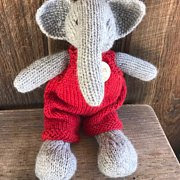 Handmade stuffed toys made with cotton fabrics and stuff with wool fleece. Designs are based in nature—animals, sun, stars, unicorns…
Handmade stuffed toys made with cotton fabrics and stuff with wool fleece. Designs are based in nature—animals, sun, stars, unicorns…
Brute Jute
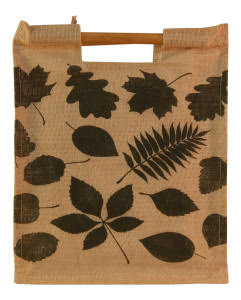 Reusable shopping bags made from jute. “Long wooden handles provide a far more comfortable grip than conventional shopping bags. Carry up to 50% more capacity than a typical plastic or paper bag. Easily rolled-up and neatly stored in your car between shopping trips.”
Reusable shopping bags made from jute. “Long wooden handles provide a far more comfortable grip than conventional shopping bags. Carry up to 50% more capacity than a typical plastic or paper bag. Easily rolled-up and neatly stored in your car between shopping trips.”
Protective Bedding Store
 Protective bedding for bedwetting and incontenance, much made with organic cotton and nontoxic urethane film. All bedding sizes. For all ages. NOTE: I am not recommending the vinyl products on this website, so choose carefully.
Protective bedding for bedwetting and incontenance, much made with organic cotton and nontoxic urethane film. All bedding sizes. For all ages. NOTE: I am not recommending the vinyl products on this website, so choose carefully.
Lightweight Non-Toxic Dinner Plate
Question from Carol
Hi Debra,
I’ve been using melamine for dinner plates, but I worry that they’re toxic. I have a 2 1/2 year old daughter. I need a lightweight plate because I have RSI and some disc trouble. What would you recommend? I couldn’t find anything through Google search.
Debra’s Answer
I think what you want is enamelware. It’s steel with a baked-on enamel coating, which is basically glass. It’s the dinnerware you take camping, but now it’s in a lot of stylish colors and patterns.
Here are a lot of choices for enamel dinnerware online.
You can also just search on your favorite search engine for “enamel dinnerware.”
Some people are concerned about heavy metals in enamel. So before you buy, contact the manufacturer and ask if there are heavy metals in the enamel. You can check for yourself with a Lead Check kit.
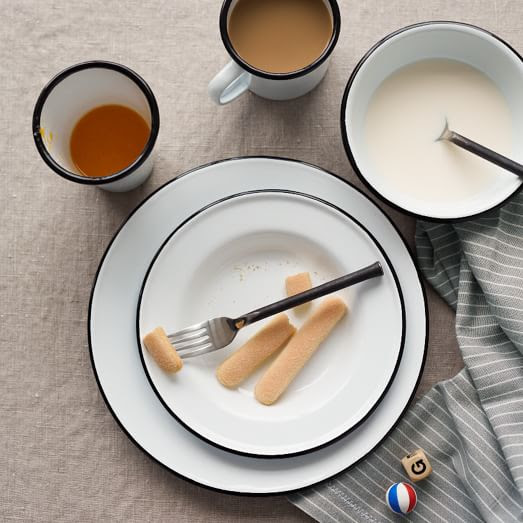 From West Elm
From West Elm
Pure Rooms
Question from Patricia
Hi Debra,
I continue to reference your website as the go to place for info on MCS safe products. Thank you!
I was wondering if you had ever heard of these allergen – free Pure Rooms? They use a multiple step process to clean and purify hotel rooms for people with allergies. There is also an air purifier in each room.
I have MCS and have been able to tolerate some of these rooms. I think the ones I was able to tolerate better were in hotels that hadn’t been remodeled recently.
Unfortunately, the number of Pure Rooms available at any hotels is dwindling. I’m guessing that the cost of maintaining the rooms and / or lack of bookings due to price is resulting in their demise. This is disappointing as these rooms were the only way I could get away for a little vacation.
Do you consider these Pure Rooms MCS safe due to the process used to purify? It seems that the Pure Rooms need more publicity and feedback so people will book them and then hotels could offer more of them.
Pat in Cleveland
Debra’s Answer
Well…not much information on their website.
I don’t see anything about what they do to make the rooms PURE.
Buried in a blog post I found this description of the air purifier:
Each PURE Room is treated according to a patented 7-step purification process and features an air-purifier powerful enough to be classified by the FDA as a Class II medical-grade device. Scientifically proven to eliminate and protect against 98-100% of viruses, bacteria and other harmful irritants, this technology provides superior air-quality and a more rejuvenating environment during recovery.
No mention is made of removing toxic gasses or heavy metals. Sounds like it basically and allergen filter, not a toxics filter.
I think it’s a great idea to have PURE rooms, but I’d like to see them have a toxic-free criteria.
And these rooms should be widely promoted so hotels will have more and more of them.
Oh here, I finally found a link to the PURE PROCESS on the page where you book a room:
Nothing refreshes a room like PURE. Our patented, 7-step purification process treats every surface, including the air, removing up to 99% of pollutants so you can breathe easy, and rest peacefully. PURE’s leading air-purification system protects you from airborne irritants, and eliminates odors at the source, leaving your room smelling fresh and clean. PURE’s unique, hypoallergenic mattress and pillow encasements provide soft, breathable coverings to protect you even further. Carpets, upholstery and all surfaces are deep cleaned and specially treated. Our rigorous maintenance is performed regularly to keep PURE Room’s certified allergy-friendly. When you stay in a PURE Room, you are free to live without boundaries, confident you have the freshest air quality in the hotel industry.
PURE’S Patented, 7-Step Purification Process
- Deep Clean Air-Handling Unit. Deep Clean Air-Handling Unit. A PURE heating and air conditioning unit along with air clean filters results in healthier air circulating throughout the room. Coils are deep cleaned and disinfected using PURE’s advanced treatment. And finally, an enzyme-based drip-pan tablet is in place to ensure maximum protection and minimum allergy at home or in partner hotels.
- PURE Tea Tree Oil Cartridge. Tea tree oil is a natural substance known for its antimicrobial and disinfectant properties. A cartridge of this tea tree oil is installed in the air-handling unit to maintain sanitized conditions.
- Carpet and Upholstery Cleaning. Our patented PURE clean solution is used to maximize the removal of dirt, bacteria and mold from all soft surfaces that traditional cleaners leave behind.
- One Time Shock Treatment. This advanced shock treatment destroys nearly all of the mold and bacteria in every nook and cranny of the room, removing any lingering odors caused by these and other contaminants, including but not limited to cigar or cigarette smoke, pets, or other unpleasant sources. The result is a fresh, crisp, environment.
- PURE Shield. This bacteriostatic barrier is applied to all room surfaces to repel microorganisms that cause illness and discomfort, and prevent their growth. Our advanced shield process makes it nearly impossible for bacteria viruses to survive in a PURE environment.
- Air Purification System. PURE’s air purifier is 24-hour defense against airborne irritants. Listed by the FDA as a Class II Medical Device, PURE’s state-of-the-art system is proven to kill 98% to 100% of bacteria and viruses.
- Allergy-Friendly Bedding. PURE’s personal protection continues. Aside from air clean filters, PURE uses only micro-fiber, mono-filament mattress and pillow encasements for lesser risks of allergy at home.
So…nothing about toxics. Bedding is synthetic. It’s all about bacteria and viruses and allergens.
But it may be better than most hotel rooms. I don’t know. I’ve never stayed in one.
Nightstand from Room and Board
Question from Sue
Hi Debra,
I found a Zen style nightstand I love at Room and Board. It’s walnut veneer over plywood and MDF (argh) so I called them to inquire. They told me all of their products have 0 VOC’s by the time they leave the warehouse, meet California standards, and many are Greengard certified (but they don’t spend the $ to test all of their products for that, they test mostly the kid stuff). They use all non-toxic glues. Do you think it’s safe?
www.roomandboard.com/catalog/bedroom/nightstands/copenhagen-nightstands
Thanks Deb!
Debra’s Answer
You are telling me that it’s made from materials that usually are red flags for me, but Room & Board seems to be aware of the outgassing issues and say they don’t exist.
So I would proceed with caution, bring it home, and be prepared to return it if you find it does outgas after all.
Dinnerware
Question from Dianne
Hi Debra,
Do you know if Villeroy and Boch fine china and bone china is safe to use or has too much lead content?
Debra’s Answer
I don’t know off hand.
But instead of me finding out, I’ll tell you how to find out so you can check any china you want to.
1. Go to the manufacturer’s website: www.villeroy-boch.com
2. Look for the “Contact Us” link which is usually in the top navigation bar or in the footer: www.villeroy-boch.com/shop/contacts/
3. Often there is a phone number you can call for Customer Service, but not on this site. They have only a contact form. Fill it out and ask your question. They may or may not respond.
Ask them if their china is lead free. Some china companies have a statement. This one does not.
Look in the product descriptions for “lead-free” or a State of California Proposition 65 warning label.
If there is a Proposition 65 label, there is lead in the glaze. If not, or if it says “lead-free” that means there is no lead added. But there is often lead in the materials that is naturally occurring.
See the Dinnerware page on Debra’s List for the dinnerware I recommend.
YOU CAN’T ESCAPE LEAD. THAT’S WHY I DETOX FOR LEAD EVERY DAY.
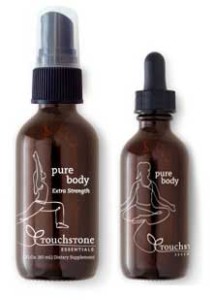
Lead is in many products we use every day and even in the outdoor air. We can’t escape it. So it’s likely that your body has built up a store of lead and possibly other heavy metals that could be affecting your health.
Once lead and other heavy metals enter your body, it is very difficult for your body to remove them.
That’s why I take PureBody Liquid Zeolite every day. This natural mineral is uniquely suited to remove heavy metals. Tiny bits of negatively-charged zeolite act like little magnets to attract positively-charged particles—which include 99.9% of heavy metals, radiation, and organic chemicals–so they can be removed from your body via your kidneys. It’s simple, effective, and affordable.
Kitchen and Bathroom Towels
Question from Sicili
Hi Debra,
Will you please tell me what type of towels you use in the kitchen and bathroom? Like for doing dishes, taking baths and drying off. Do you use non organic 100% cotton towels of different colors or do you stick to GOTS certified ? I am just curious because I am trying to figure out what to do as far as my wash cloths and such and I greatly value your opinion. Thank you so much for your time Debra.
Debra’s Answer
If I had all the money needed to buy everything in the world I want, I would choose GOTS certified organic natural fibers for everything.
The reality is that I buy what I can afford, which is 100% natural fibers, without finishes. This type of textile uses chemicals in growing and processing, but there is little, if any, exposure at the user end.
For my dishes, I now use 100% linen towels because they absorb water sooo much better than cotton. Just a wipe and dishes are completely dry. They cost about twice as much as cotton, but they are also more durable. I bought a few at IKEA. They were $3.99. VARDAGEN. They are not sold online but they probably have them at your local IKEA store. I used to use just non-organic cotton towels of various colors.
I also have some linen dish towels on the Kitchen Linens page of Debra’s List.
My bath towels are currently 100% cotton terry cloth that I bought at Bed Bath & Beyond about ten years ago. They are blue. But I have my eye on buying some linen bath towels because, as I said above, they are so absorbent, and get softer and softer with every wash.
I have some linen bath towels on the Bath Linens page of Debra’s List.
Building Biology Institute
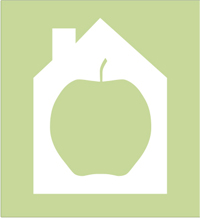 BBI educates people from all professions and walks of life about the hazards to human health from electromagnetic radiation, indoor air & water pollution and toxic building materials. The Institute’s website offers a wealth of free information (factsheets, videos, articles, downloads), as well as a comprehensive curriculum that includes online courses (self-study), a mentored correspondence course, and six instructor-led 5-day seminars. The institute also offers professional certification training for those who wish to make a profound difference in the health and wellbeing of others, training and certifying Building Biology Environmental Consultants (BBEC), Electromagnetic Radiation Specialists (EMRS), and Building Biology New-build Consultants (BBNC). Also offered is Building Biology Activist (BBA) Certification, which can be accomplished entirely from your home or office, and at your own pace.
BBI educates people from all professions and walks of life about the hazards to human health from electromagnetic radiation, indoor air & water pollution and toxic building materials. The Institute’s website offers a wealth of free information (factsheets, videos, articles, downloads), as well as a comprehensive curriculum that includes online courses (self-study), a mentored correspondence course, and six instructor-led 5-day seminars. The institute also offers professional certification training for those who wish to make a profound difference in the health and wellbeing of others, training and certifying Building Biology Environmental Consultants (BBEC), Electromagnetic Radiation Specialists (EMRS), and Building Biology New-build Consultants (BBNC). Also offered is Building Biology Activist (BBA) Certification, which can be accomplished entirely from your home or office, and at your own pace.
BBI is a 501(c)(3) nonprofit environmental education organization.
Swans Island Company
 Blankets, throws, wraps, and accessories (also yarns) handcrafted from Maine-spun fleeces and hand-dyed yarns. “A Swans Island product means natural fiber, sourced to the highest possible standard, designed to be as timeless as the tides. * Much of our fiber is from local New England farms as well as domestic, family-run farms that have been caring for their flocks for generations. Our organic merino, sourced from South America, has been certified organic by the Global Organic Textile Standard, the world’s leading processing standard for textiles made from organic fibers. * Fleece from those farms is custom spun for us by New England mills on trusty vintage machinery. From there, every skein of Swans Island yarn – whether destined for our looms, our machine-knit accessories, or your knitting needles – is dyed by hand in our Northport dye house. * Many of our yarns are dyed using naturally derived pigments like cochineal, indigo, and madder root. Others are skein-dyed with low-impact dyes. * We make each dye bath with unique recipes, expertly working the fibers in order to achieve our distinctive hand-dyed look and feel. * Many of our products are woven on traditional looms here in Northport; others are produced in partnership with American makers who share our belief in the value of a life built by hand.” Edges handwoven with 100% silk.
Blankets, throws, wraps, and accessories (also yarns) handcrafted from Maine-spun fleeces and hand-dyed yarns. “A Swans Island product means natural fiber, sourced to the highest possible standard, designed to be as timeless as the tides. * Much of our fiber is from local New England farms as well as domestic, family-run farms that have been caring for their flocks for generations. Our organic merino, sourced from South America, has been certified organic by the Global Organic Textile Standard, the world’s leading processing standard for textiles made from organic fibers. * Fleece from those farms is custom spun for us by New England mills on trusty vintage machinery. From there, every skein of Swans Island yarn – whether destined for our looms, our machine-knit accessories, or your knitting needles – is dyed by hand in our Northport dye house. * Many of our yarns are dyed using naturally derived pigments like cochineal, indigo, and madder root. Others are skein-dyed with low-impact dyes. * We make each dye bath with unique recipes, expertly working the fibers in order to achieve our distinctive hand-dyed look and feel. * Many of our products are woven on traditional looms here in Northport; others are produced in partnership with American makers who share our belief in the value of a life built by hand.” Edges handwoven with 100% silk.
Mountain Honey Clothiers
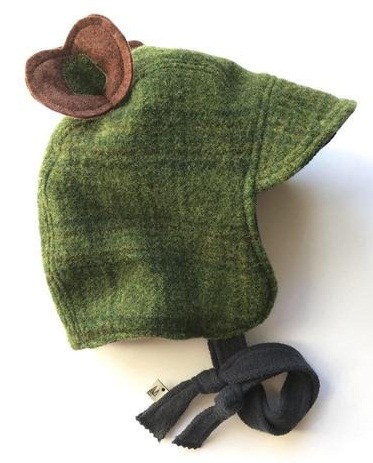 “We are committed to creating heirloom quality children’s clothing, toys, and accessories, that support imagination and your child’s own unique style. We don’t skip corners, follow the hotest trends, or print big flashy logos on our products. We create pieces that are timeless and fun, yet incredibly functional.We are all about bringing your family fashion choices that allow your little one to express their uniqueness and creativity, while making a positive impact on their world. Our clothing is more than just whimsical, well made, and unique, it is made by a small company, with a huge heart; a company with a conscience.” In an email, Diedre told me she is committed to using only natural fibers (with one tiny exception: recycled plastic in a wool blend). She tries to use as much certified organically grown cotton as possible, or organic linen. The dolls are stuffed with fluffy organic cotton fill. I choose fabrics that have a 100% cotton, linen, wool, or flax content, no synthetic fibers. I use cotton thread, and metal snaps that are produced in the US and are nickel-free. I purchase from companies that either produce their products organically, are sustainably run, or can be classified as a “small business”. 100% of my products are handmade in VT, USA by either myself or my assistant. The Mountain Honey line is based on the principles of sustainably produced, small-batch fashion.”
“We are committed to creating heirloom quality children’s clothing, toys, and accessories, that support imagination and your child’s own unique style. We don’t skip corners, follow the hotest trends, or print big flashy logos on our products. We create pieces that are timeless and fun, yet incredibly functional.We are all about bringing your family fashion choices that allow your little one to express their uniqueness and creativity, while making a positive impact on their world. Our clothing is more than just whimsical, well made, and unique, it is made by a small company, with a huge heart; a company with a conscience.” In an email, Diedre told me she is committed to using only natural fibers (with one tiny exception: recycled plastic in a wool blend). She tries to use as much certified organically grown cotton as possible, or organic linen. The dolls are stuffed with fluffy organic cotton fill. I choose fabrics that have a 100% cotton, linen, wool, or flax content, no synthetic fibers. I use cotton thread, and metal snaps that are produced in the US and are nickel-free. I purchase from companies that either produce their products organically, are sustainably run, or can be classified as a “small business”. 100% of my products are handmade in VT, USA by either myself or my assistant. The Mountain Honey line is based on the principles of sustainably produced, small-batch fashion.”
Dots on Tots
100% certified organic cotton hats for babies and toddlers. Various styles in various colors. “Dots on Tots is a baby headwear company specializing in ear flap hats made from natural, certified-organic cotton…As newborns and toddlers have sensitive skin and are vulnerable to ENT ( ear, nose and throat) complications, [parents need] a line of accessories that keep babies safe by covering their ears and at the same time not harming their sensitive skin. With her Master’s Degree in Fashion Design and Technology and an experienced mother, Olivia set forth to provide the children’s market with a niche product that would provide safety and comfort to children.” Noise-reduction inserts for ear flaps available.
Rat Pack Hats
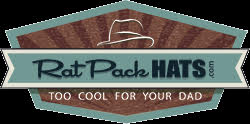 Natural fiber hats for men with “cool and sophisticated styles” reminiscent of the Hollywood “rat pack” actors. Made from cotton, linen, straw, wool, leather, or waterproof genuine oil cloth (choose “Shop Hats by Material” from the side menu).
Natural fiber hats for men with “cool and sophisticated styles” reminiscent of the Hollywood “rat pack” actors. Made from cotton, linen, straw, wool, leather, or waterproof genuine oil cloth (choose “Shop Hats by Material” from the side menu).
Jacobs & Brichford
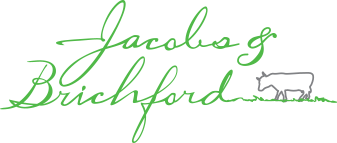 Producers of raw milk cheese on their family’s Hoosier Homestead Farm. “Making cheese from our solely grass-fed dairy cows, we continue to live and work on the farm that has been in the family since 1819. We believe in a sustainable future and our cheese is one way we can bring that vision to you.”
Producers of raw milk cheese on their family’s Hoosier Homestead Farm. “Making cheese from our solely grass-fed dairy cows, we continue to live and work on the farm that has been in the family since 1819. We believe in a sustainable future and our cheese is one way we can bring that vision to you.”
Explorer Hats
 “Indiana Jones” style hats for men and women, made from garment washed twill, weathered cotton, boiled wool or naturally harvested organic raffia. Look at this sweet wide-brimmed crocheted toyo hat with flowers made from shells. Great styles. Affordable prices.
“Indiana Jones” style hats for men and women, made from garment washed twill, weathered cotton, boiled wool or naturally harvested organic raffia. Look at this sweet wide-brimmed crocheted toyo hat with flowers made from shells. Great styles. Affordable prices.
Gneiss Spice
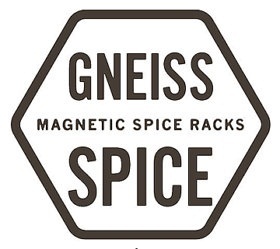 Clever magnetic spice racks and organic spices in small packages to refill. Interlocking hexagonal magnetic spice jars stick to metal racks (or refrigerator doors, I assume).
Clever magnetic spice racks and organic spices in small packages to refill. Interlocking hexagonal magnetic spice jars stick to metal racks (or refrigerator doors, I assume).
Wal-Mart Responds to Consumer Demands by Requiring Manufacturers to Remove Some Toxic Chemicals from Products Sold at Their Stores
In 2013, Wal-Mart asked it’s suppliers to reduce certain toxic chemicals from personal care, cleaning, and beauty products and promote alternatives. The program affects about 90,000 items from 700 manufacturers.
Last week, Wal-Mart announced the chemicals on the list and reported that to date its suppliers have removed 95 percent of the chemicals on the list, by volume weight, from products sold in U.S. Was-Mart stores covered by the policy.
The eight chemicals being reduced by Wal-Mart are:
- Formaldehyde
- Triclosan
- Toluene
- Diethyl phthalate
- Nonylphenol exthoxylates
- Butylparabens
- Dibutyl phthalate
- Propylparaben
Brian Yarbrough, an analyst at Edward Jones & Co. said, “The retailer’s move makes sense. Customers are seeking more information about the substances in the products they buy. This is just the natural evolution of consumers today. From Wal-Mart’s standpoint, it’s kind of the way they need to be moving.”
So, see…our purchase of nontoxic products IS making a difference. The mass market is clearly moving in the direction of less toxic products.
This list of chemicals is interesting. It’s not the list I would have chosen, but it’s a step in the right direction. This list has chemicals that vary widely in toxicity. Toluene, for example, is tremendously more toxic than propylparaben.
I’m happy to see the reduction, but this doesn’t make Wal-Mart a place where all products are safe. I wish they would identify their nontoxic products with shelf-talkers to make it easy for consumers to find them.
This is progress!
BLOOM BERG: Wal-Mart Asks Its Suppliers to Stop Using Eight Chemicals
Amagansett Sea Salt
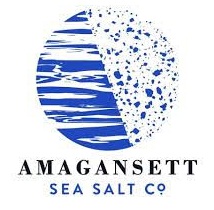 Premium finishing salt, to be added to food on your plate. “Amagansett Sea Salt is crafted entirely by hand in small batches from seawater harvested from the Atlantic Ocean. All steps – from the ocean to the jar – take place in Amagansett, a small, oceanfront hamlet in the Hamptons area of Long Island, New York. Our process is entirely natural, requiring only the sun, the wind, a strong back, and patience. By carefully balancing solar evaporation and exposure to the crisp, clear ocean breezes, our Amagansett Sea Salt forms slowly into crystals with a mild, sweet, flavor and a distinctive soft “crunch” that enhances any food. Clean water. Clean air. Exceptional sea salt. The best salt comes from clean, cold, fast-moving ocean water solar-evaporated outdoors in clean, fresh ocean air. We are not a salt importer or blender; rather we make our crystals. Our salt is made outdoors in the sunshine and bathed by ocean breezes, not under a roof or in a greenhouse. We do not boil or oven-dry our seawater or salt. We use no chemicals or anti-caking agents. We have taken excruciatingly difficult steps to eliminate all metal from contacting our sea water and salt crystals. Producing salt this way is hard, labor intensive and weather dependent, but the results are worth it.” Pure salt and salt blends.
Premium finishing salt, to be added to food on your plate. “Amagansett Sea Salt is crafted entirely by hand in small batches from seawater harvested from the Atlantic Ocean. All steps – from the ocean to the jar – take place in Amagansett, a small, oceanfront hamlet in the Hamptons area of Long Island, New York. Our process is entirely natural, requiring only the sun, the wind, a strong back, and patience. By carefully balancing solar evaporation and exposure to the crisp, clear ocean breezes, our Amagansett Sea Salt forms slowly into crystals with a mild, sweet, flavor and a distinctive soft “crunch” that enhances any food. Clean water. Clean air. Exceptional sea salt. The best salt comes from clean, cold, fast-moving ocean water solar-evaporated outdoors in clean, fresh ocean air. We are not a salt importer or blender; rather we make our crystals. Our salt is made outdoors in the sunshine and bathed by ocean breezes, not under a roof or in a greenhouse. We do not boil or oven-dry our seawater or salt. We use no chemicals or anti-caking agents. We have taken excruciatingly difficult steps to eliminate all metal from contacting our sea water and salt crystals. Producing salt this way is hard, labor intensive and weather dependent, but the results are worth it.” Pure salt and salt blends.
Conner Handmade Hats
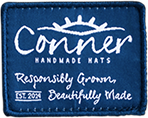 High quality hats for women, men, and children in many styles, made from organic cotton. Also hemp, leather, linen, waxed cotton, raffia, paper straw, wool, and more (see Material menu for full list). Extra large sizes available for big heads. I’ve never seen so many styles of hats made from natural materials all in one place.
High quality hats for women, men, and children in many styles, made from organic cotton. Also hemp, leather, linen, waxed cotton, raffia, paper straw, wool, and more (see Material menu for full list). Extra large sizes available for big heads. I’ve never seen so many styles of hats made from natural materials all in one place.
Naked Binder
3-ring binders (various sizes), pocket folders, and tab dividers that are ‘recyclable, strong, and made of recycled materials. We designed them to not only look great, but be healthier and safer to make, use, and recycle…We believe the products you use should inspire, be strong, and be kind to the planet.” Choose from binders made with 100% post-consumer recycled cardboard covers or beautiful real wood covers.
Southern Scent Candle Co.
I found this candle company at a local street fair. “All natural soy candles at a price that everyone can enjoy.” All organic 100% soy bean wax, cedar wooden wicks, and organic essential oils for “a fully organic product…Due to the nature of the soy and wood these candles will have a low flame, a more delicate fragrance, and create more of a nightlight effect than the full flame produced by the petroleum and sting of traditional candles.”
Red Clouds Collective
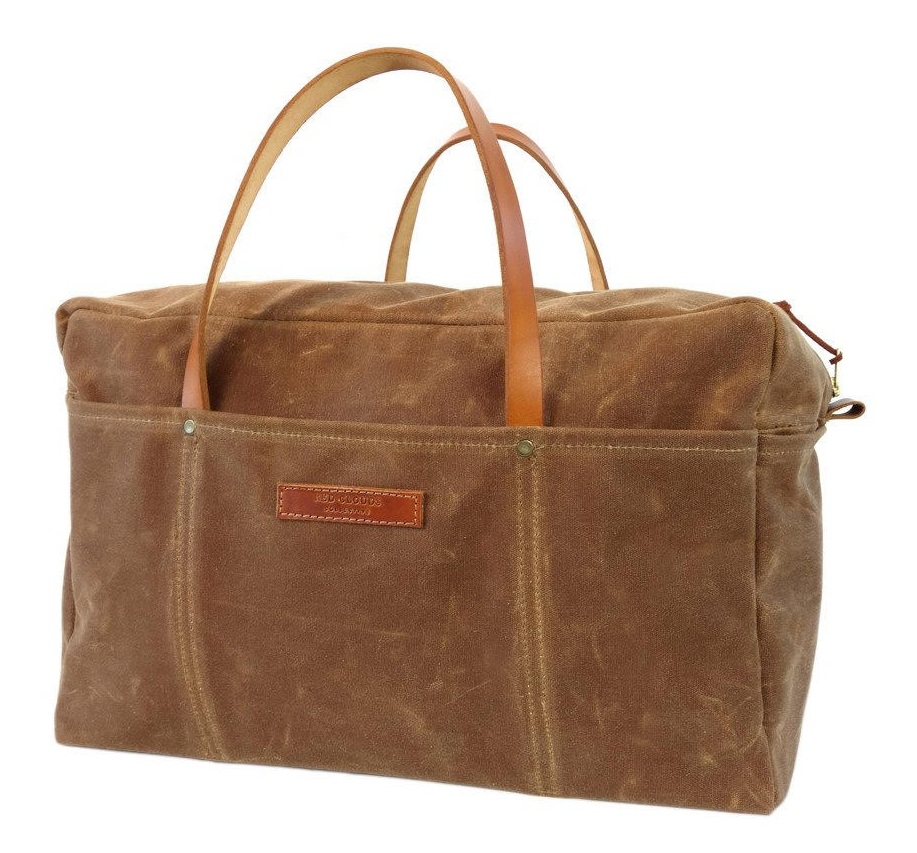 Clothing, bags, and accessories made with all natural materials and exceptional craftsmanship. “Our products are born from necessity. Each one is thoughtfully designed to make life a little easier, and they’re all built to last a lifetime.”MATERIALS: Vegetable Tanned Leather from Hermann Oak—a St. Louis, Missouri-based tannery that has been tanning leather using extracts of tree bark in the traditional method since 1881. Waxed Canvas from Fairfield Textile, a specialized American manufacturer based in Bridgeton, New Jersey that has been crafting fabric since 1838. Selvage Denim from Cone Mills’ White Oak Plant in North Carolina, woven on vintage 1940s fly-shuttle looms that give each piece of fabric a unique depth and dimension.”
Clothing, bags, and accessories made with all natural materials and exceptional craftsmanship. “Our products are born from necessity. Each one is thoughtfully designed to make life a little easier, and they’re all built to last a lifetime.”MATERIALS: Vegetable Tanned Leather from Hermann Oak—a St. Louis, Missouri-based tannery that has been tanning leather using extracts of tree bark in the traditional method since 1881. Waxed Canvas from Fairfield Textile, a specialized American manufacturer based in Bridgeton, New Jersey that has been crafting fabric since 1838. Selvage Denim from Cone Mills’ White Oak Plant in North Carolina, woven on vintage 1940s fly-shuttle looms that give each piece of fabric a unique depth and dimension.”
Seavees
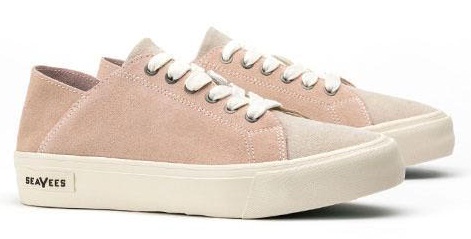 Casual sneakers, espadrilles, and sandals—made with washed natural fiber fabrics (cotton, linen, hemp), genuine gum rubber soles, and vegetable-tanned leather.
Casual sneakers, espadrilles, and sandals—made with washed natural fiber fabrics (cotton, linen, hemp), genuine gum rubber soles, and vegetable-tanned leather.
America’s First Nontoxic City
Read this inspiring story about how the city of Irvine, California got pesticides reduced in public places.
Anyone can do this anywhere, for any chemical.
Let’s get going with this everywhere.
OC WEEKLY: How Irvine Became SoCal’s First Non-toxic City

Can Water Make You Fat?
The cover of First for Women on magazine racks this week says
THE NEW WATER CURE
Oxford University researcher confirm drinking H2O speeds weight loss by 550%
But 95% of women don’t see results because the water they’re drinking is slowing their thyroid
Well, I had to read that!
Unfortunately, First for Women doesn’t cite their studies, and I couldn’t find a study online to support the claim in their headline.
But it is widely known and documented that fluoride in tap water can effect your thyroid gland. Since the thyroid gland regulates weight gain and loss, drinking fluoridated water would impair your body’s ability to lose weight. Fluoride in tap water may even contribute to weight gain—so yes, one can get fat from drinking water.
It’s no secret that drinking water can help you lose weight, but drinking fluoridated water may defeat the purpose.
Since fluoride has many other health effects, it’s always best to drink fluoride-free water.

If you are drinking tap water, it’s likely that it contains fluoride.
Your best protection is to get a water filter that is specifically designed to remove fluoride.
The water filter I use in my own home is made by Pure Effect. It’s state of the art filtration removes just about everything that might be in your water that you don’t want to put in your body…including fluoride.
Learn more about Pure Effect water filters here…
Toxic Chemicals and Food Allergies/Sensitivities
I first observed a connection between food allergies and toxic exposures more than thirty years ago when I was working in the office of a doctor who was treating patients with multiple chemical sensitivities.
They would come in reacting to chemicals and foods and the doctor would send them off to the beach for a couple of weeks to give their bodies a break from the bombardment of toxic exposures. This was the treatment then, before we knew about saunas.
And it worked, too. Patients would come back from the beach happy and excited that they could eat any food they wanted without reaction.
And that’s how I made the connection between toxic chemicals overloading your body and food allergies.
This week two emails came in regarding toxic chemical exposure and food allergies.
One was the RODALE WELLNESS: 10 Crazy Things Pesticides Do to Your Body.
The other is WHOLE LIFE NUTRITION: How Chemicals Increase Food Allergies and Food Sensitivities. This well-documented post shows how toxic chemicals damage your immune system, leading to food allergies (and allergies and sensitivities of all sorts).
I was happy to see the scientific support for this, after observing it all those years ago.
The pieces of this toxic puzzle are coming together.
Harmful Chemicals from Natural Gas Operations Contaminate Bodies of Local Residents
 Fracking is the process of drilling down into the earth before a high-pressure water mixture is directed at the rock to release the gas inside. Water, sand and chemicals are injected into the rock at high pressure which allows the gas to flow out to the head of the well.
Fracking is the process of drilling down into the earth before a high-pressure water mixture is directed at the rock to release the gas inside. Water, sand and chemicals are injected into the rock at high pressure which allows the gas to flow out to the head of the well.
You may not have considered fracking operations as a source of toxic chemical exposure, but it’s something you should check on. 12.4 million people live in the threat radius. CHECK MAPS HERE to fnd out if your home or school is within a 1/2 mile of an active oil & gas well, and more about the pollutants that may be present from fracking. Thankfully, I’m not in a fracking zone here in Florida, but if you live in the midwest, northeast, or California, please check the map.
A new study has found that many of the toxic chemicals used at fracking sites may be present in higher concentration in the bodies of people in nearby communities.
A first-of-its-kind study combining air-monitoring methods with new biomonitoring techniques detected volatile organic compounds (VOCs) released from natural gas operations in the bodies of nearby residents at levels that were as much as 10 times that of the national averages.
The study focused on measuring ambient levels of a specific family of VOCs named BTEX chemicals — which include benzene, toluene, ethylbenzene, and xylenes — because these chemicals are known to be hazardous to human health even at low levels. Researchers then used new biomonitoring methods to detect these chemicals in 11 local residents who volunteered to participate in the study by wearing air quality monitors and providing blood and urine samples, and found evidence of eight hazardous chemicals emitted from Pavillion gas infrastructure in the urine of study participants.
EARTH ISLAND JOURNAL: High Levels of Toxins Found in Bodies of People Living Near Fracking Sites
EARTHJUSTICE: Unfractured: Joining Together ro Fight Fracking
Travel Cribs
Question from Jan
Hi Debra,
Have been researching safe Bassinetts/cosleepers. The best I have found are Nuna Sena and Lotus.
Do you have an opinion on these?
Debra’s Answer
Lotus website says they are “nontoxic” (and do extensive testing to ensure the bassinets are free of a long list of chemicals, and also that they are GREENGUARD GOLD Certified (they are the only travel crib in the world to receive this certification).
These are both good indicators that the product is nontoxic. However, I don’t see their materials listed, so I can’t verify for myself.
Nuna Sena is made with OEKO-TEX certified materials, but again, I don’t know what they are.
10 Ways Pesticides Harm Your Body
Here’s a great overview of 10 documented health effects of pesticides:
RODALE WELLNESS: 10 Crazy Things Pesticides Are Doing to Your Body
Of course the answer is to eat organic, but this post might make the connection between pesticide exposure in foods and a condition you or a loved one may have.
For example, did you know pesticides in food are liked to memory loss, diabetes, and obesity?
And there’s more…
My Personal Experience With “Second-Hand” Asbestos
Hi Debra,
I saw that you haven’t posted much about asbestos and I wanted to share my experience with this dangerous mineral. Exposure to asbestos is a truly silent killer and something that everyone should be aware of.
Many people think asbestos is a problem of the past, as laws were passed in the 1970’s that limited its use. While asbestos production took a sharp turn and began to decline around the time these laws were passed, it is still NOT banned in the US and Canada. It can still be found in older homes and buildings, schools, naval yards, automobiles, and even consumer products- leaving everyone at risk for exposure. Until asbestos is totally banned and eradicated, the potential for asbestos exposure will remain.
Exposure to asbestos is something that changed the path of my life forever. I am a mesothelioma survivor and advocate. I was initially exposed to asbestos through wearing my father’s work jacket. I wore his jacket to do outside chores so I wouldn’t get my clothes dirty. Little did I know that asbestos fibers were embedded into that jacket and would lead to a diagnosis of mesothelioma in 2005 when I was just 36 years old. My prognosis was not good; I was only given 15 months to live. Luckily, I was a candidate for a dangerous surgical procedure that involved the removal of my left lung. Recently, I am happy to say I celebrated my 10-year survival anniversary and I use my second lease on life to continue the exhausting fight for an international ban on asbestos.
Asbestos was originally thought of as a “miracle mineral”. It is extremely flame retardant, heat resistant and very cheap. Because of its cost-effectiveness and many benefits, it was produced in major quantities. However, people working with the product were found to have associated health problems as early as the 1900’s. The major health issue that asbestos causes is mesothelioma, a rare and aggressive cancer that doesn’t show symptoms until 20-40 years later. Mesothelioma is usually found in lining of the lungs, heart and stomach, and leaves those diagnosed with a prognosis of about 12-21 months to live.
For more information about this dangerous cancer caused by asbestos, head over to mesothelioma.com/mesothelioma.
Excessive Lead in Tap Water Across America, says NRDC
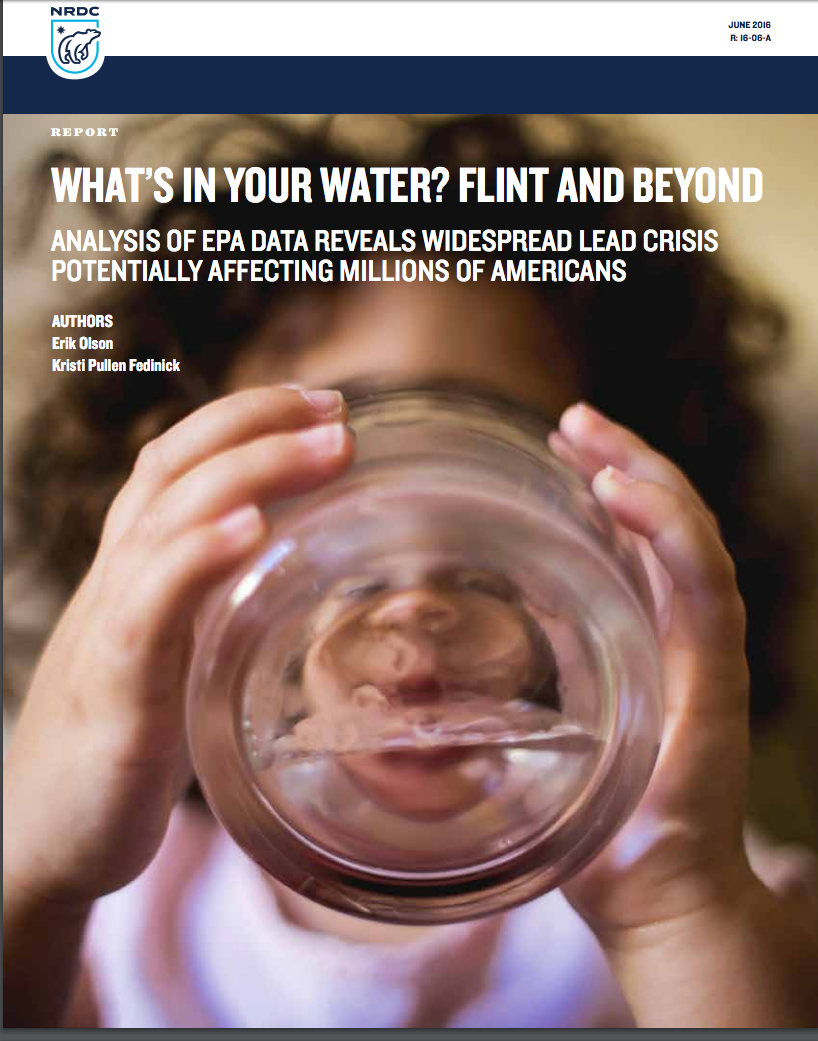 In an extensive analysis of official EPA violation and enforcement records, NRDC mapped lead-related issues in drinking water systems across the United States. Our research illustrates the extraordinary geographic scope of America’s lead crisis. In 2015, 18 million people were served by water systems with lead violations
In an extensive analysis of official EPA violation and enforcement records, NRDC mapped lead-related issues in drinking water systems across the United States. Our research illustrates the extraordinary geographic scope of America’s lead crisis. In 2015, 18 million people were served by water systems with lead violations
NRDC:
What’s in Your Water? Flint and Beyond (article)
NRDC:
What’s in Your Water? Flint and Beyond (study)
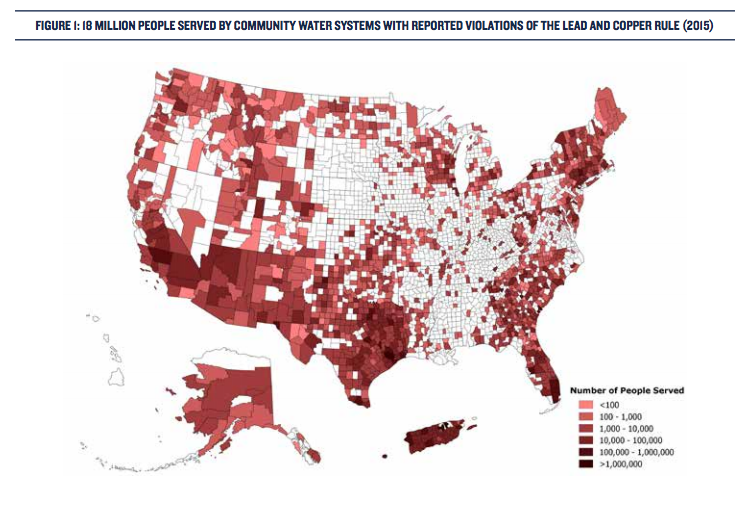
 If you are drinking tap water, it’s likely that it contains chlorine or chloramines, fluoride, lead and other heavy metals, perhaps radiation, and unknown contaminants of various sorts.
If you are drinking tap water, it’s likely that it contains chlorine or chloramines, fluoride, lead and other heavy metals, perhaps radiation, and unknown contaminants of various sorts.
Your best protection is to get a water filter that removes a broad spectrum of known pollutants and unknown contaminants.
The water filter I use in my own home is made by Pure Effect. It’s state of the art filtration removes just about everything that might be in your water that you don’t want to put in your body.
Learn more about Pure Effect water filters here…
Skin Care That Fights Pollution?
Just a few days ago, The New York Times reported that toxic pollutants in the air can affect the skin’s aging process. A study done on data from subjects in Germany and China found an association between air pollution and brown spots on the skin.
In response, major beauty companies are now offering a new type of skin care product: “pollution protection.”
Read the article for all the technical details of how pollution is affecting your skin.
But skip all the expensive recommended beauty products listed. I haven’t checked all the labels, but I suspect they contain their own pollutants.
The article clearly states the best defense against air pollution is a regular routine of gentle cleansing and application of vitamin C serum or vitamin E to the skin on your face.
THE NEW YORK TIMES: What’s All the Fuss About Pollution-Fighting Skin Care?
JOURNAL OF INVESTIGATIVE DERMATOLOGY: Expanding Our Understanding of Human Skin Aging
BPA in Canned Food = BPA in the Body—and Cream of Mushroom Soup Leaches more BPA Than Peaches
We’ve heard this before—BPA is leaching from the interior linings of cans into canned food—but a new study shows that different types of food leach different amounts of BPA.
The study suggests that canned soups and pasta can expose consumers to higher concentrations of BPA than canned vegetables and fruit — and although those foods are tied to BPA concentrations, canned beverages, meat and fish are not.
Researchers found that people who consumed one canned food item in the past day had about 24% higher concentrations of BPA in their urine compared with those who had not consumed canned food. The consumption of two or more canned food items resulted in about 54% higher concentrations of BPA.
Once the researchers evaluated what types of canned foods were consumed, they found that eating canned soup resulted in a whopping 229% higher concentration of BPA compared with consuming no canned foods. Canned pasta resulted in 70% higher concentrations, and canned vegetables or fruit resulted in 41% higher concentrations.
In the past, researchers tested can linings for the presence of BPA. This study shows that BPA from can linings actually do elevate levels of BPA in the body.
CNN: Canned foods linked to BPA risk in new study
Cook without cans at Toxic Free Kitchen.
The Least Toxic Way to Waterproof Fabric
I happened to run across a how-to webpage that gave six methods for waterproofing fabric:
1. waterproof sprays
2. laundry detergent and alum
3. turpentine and soybean oil
4. iron-on vinyl
5. beeswax
6. linseed oil
Most of these are pretty toxic, but beeswax is actually a great solution.
I used to have a “waxed” raincoa oil clothe that was cotton coated with wax. This is apparently how they made raincoats before we had modern waterproof fabrics.
You may have heard of “oilcloth,” which is fabric treated with boiled linseed oil to make it waterproof. This was used for tablecloth. Today “oilcloth” is fabric with a layer of plastic.
Here are the instructions for waxing fabric to make it waterproof:
www.wikihow.com/Waterproof-Fabric
Kelly & Co.
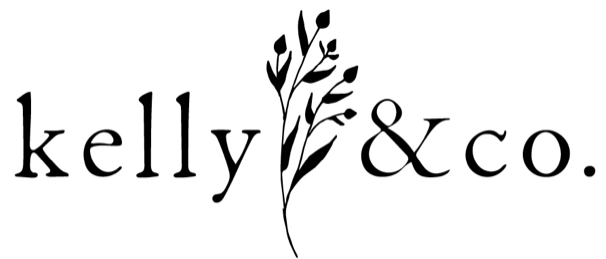 A “small and sturdy collection of thoughtfully designed handmade goods for the home. Materials- like linen, waxed canvas and reclaimed hardwoods are chosen for their sustainability, durability, and beauty. Enduring and durable, simple and sturdy, handy and handmade.” Oversized linen napkins in soft colors, linen blankets, linen coffee filters, wooden bangles, aprons, waxed canvas lunch bags and carryalls… “Kelly & Co. represents the work of two Kellys- Erin & Don- both living and working in the same tiny town in the hills of western Massachusetts. They are niece & uncle, and work with fabric & wood, respectively…Both have been at their chosen crafts for many years- so long that it feels perhaps their crafts chose them. Each will wax poetic about their materials if given the opportunity, and family dinners may find them appreciating the tiny luxuries of working where they live..”
A “small and sturdy collection of thoughtfully designed handmade goods for the home. Materials- like linen, waxed canvas and reclaimed hardwoods are chosen for their sustainability, durability, and beauty. Enduring and durable, simple and sturdy, handy and handmade.” Oversized linen napkins in soft colors, linen blankets, linen coffee filters, wooden bangles, aprons, waxed canvas lunch bags and carryalls… “Kelly & Co. represents the work of two Kellys- Erin & Don- both living and working in the same tiny town in the hills of western Massachusetts. They are niece & uncle, and work with fabric & wood, respectively…Both have been at their chosen crafts for many years- so long that it feels perhaps their crafts chose them. Each will wax poetic about their materials if given the opportunity, and family dinners may find them appreciating the tiny luxuries of working where they live..”

